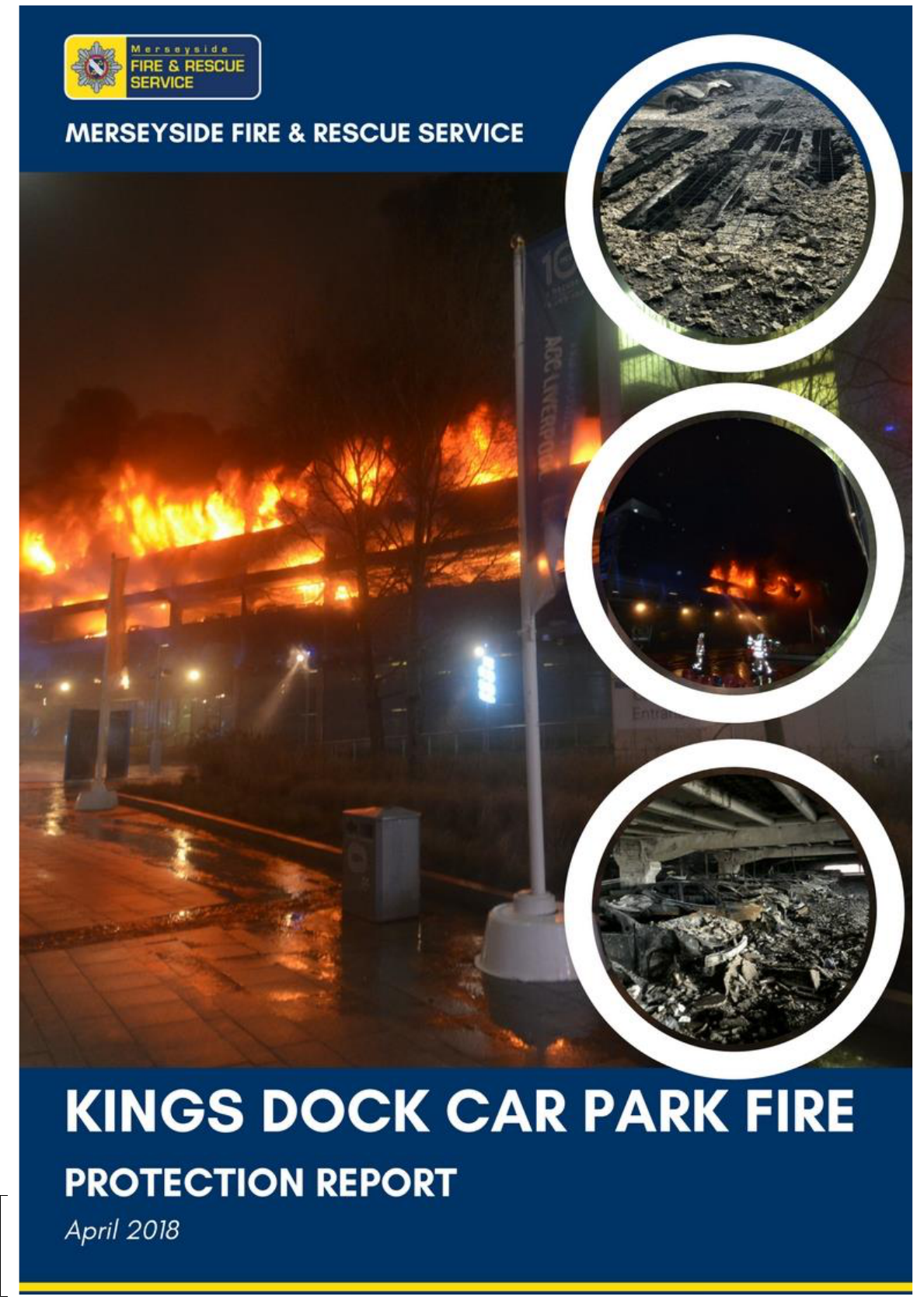
i
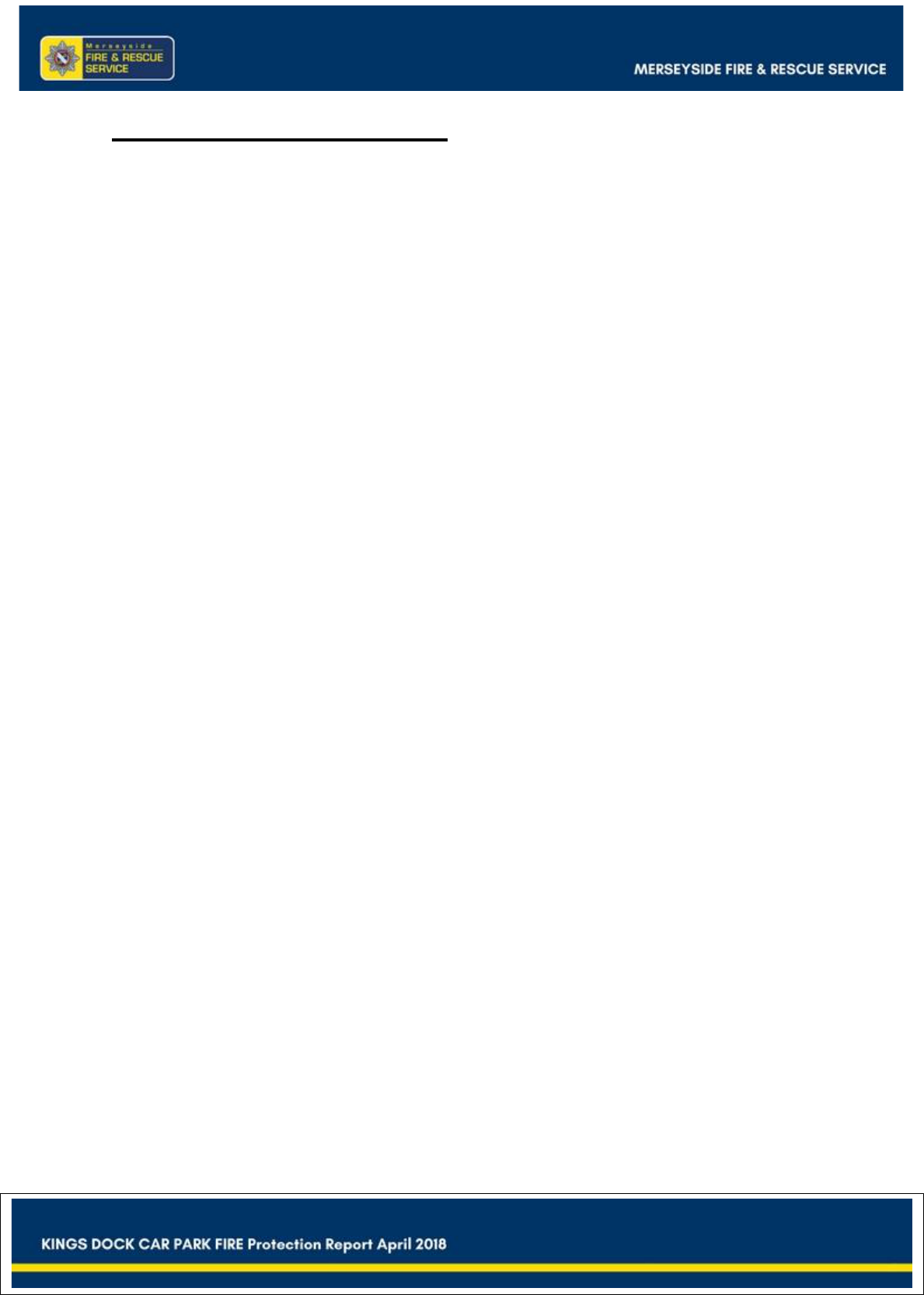
ii
TABLE OF CONTENTS PAGE
Terms of Reference 01
Executive Summary (Review Methodology) 02
Introduction 07
1. Building Construction and Fire Design Requirements 09
1.1 Building Design 09
1.2 Building Regulations 10
1.3 Background Research into Car Fires 12
1.4 BRE Fire Spread in Car Parks BD2552 13
2. Fire Spread 17
2.1 Initial Considerations 17
2.2 Drainage System 19
2.3 Fire on Level 4 24
2.4 Running fuel fires 26
3. Fire Protection and Management of Building 29
3.1 Fire Strategy 29
3.2 Previous MF&RS Protection Department Involvement 30
3.3 Fire Risk Assessments 32
3.4 Fire Protection Measures 36
3.5 Firefighting Access and Facilities 42
4. Natural Ventilation 45
5. Human Behaviour to Fire 47
6. Related Incidents 51
Glossary 53
References 55
Appendix 1 – Detailed Timeline 57
Appendix 2 – Alterations Notice for Arena & Conference Centre Liverpool 59
This publication, excluding logos, may be reproduced in any format or medium for research, private
study or for internal circulation within an organisation. This is subject to it being reproduced accurately
and not used in a misleading context. The material must be acknowledged as MF&RS copyright and
the title of the publication specified.
Any other use of the contents of this publication would require a copyright licence.
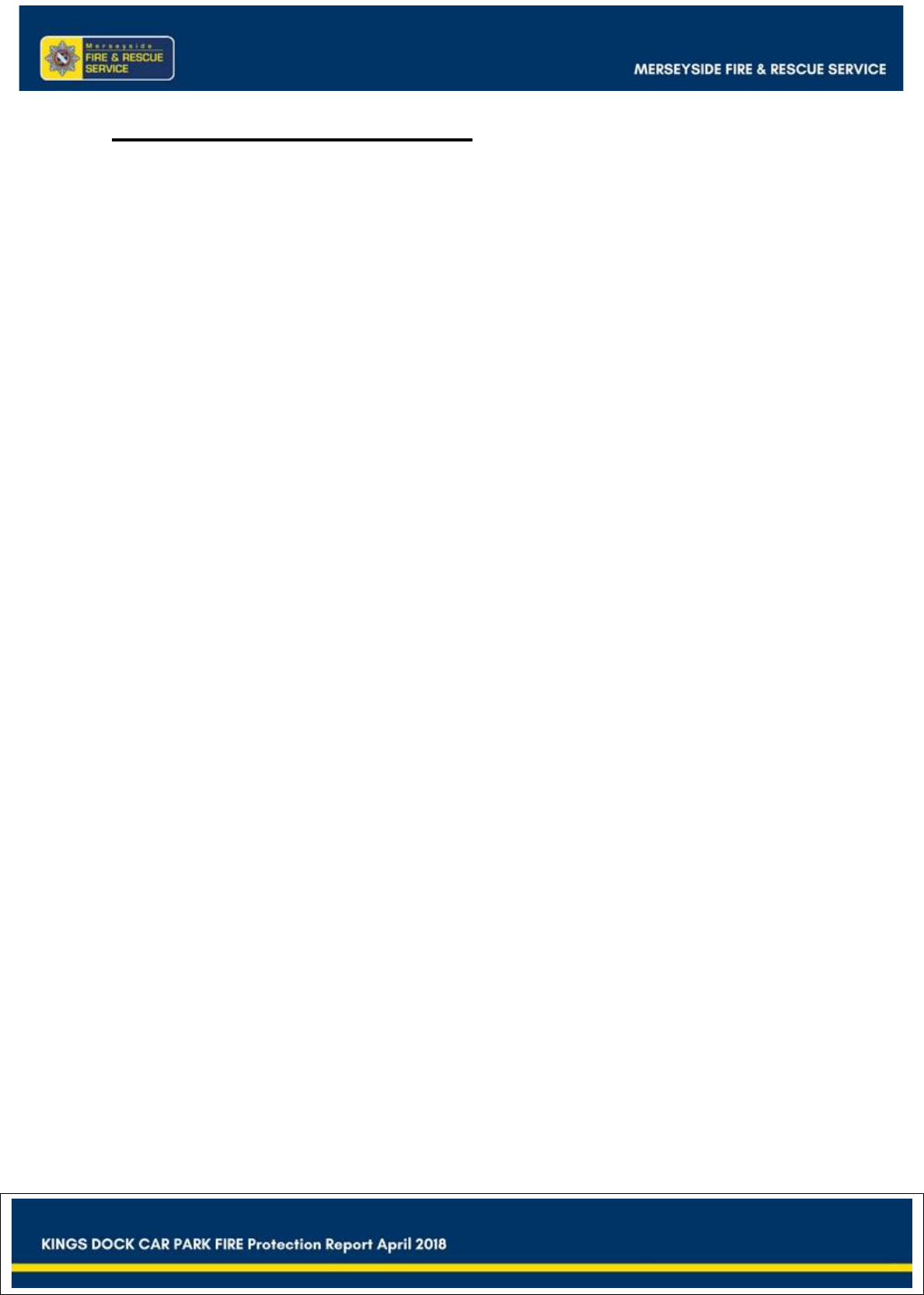
1
TERMS OF REFERENCE
Following the major fire incident at Kings Dock car park on 31
st
December 2017,
Merseyside Fire and Rescue Service (MF&RS) commenced investigations into the
incident and has commissioned this report into the fire protection considerations
surrounding the fire.
The purpose of this report is to provide information for other United Kingdom Fire and
Rescue Services (UKF&RS) and stakeholders to highlight a fire of special interest. It
will incorporate and consider the fire protection issues influencing the incident,
including:
The legislative fire protection, fire design and construction requirements for this
type of building
The specific design of Kings Dock Car Park and how the fabric of the building
behaved in the fire
The causes of the fire spread during the incident
The role of MF&RS protection department
The roles and management of the building by Liverpool City Council (LCC),
Arena Convention Centre Liverpool (ACCL), Outsourced Client Solutions Uk
Ltd. (OCS) and the Liverpool International Horse Show and Bolesworth Events
(LIHSBE)
Human behaviour in fire
Identify lessons learned and share with stakeholders.
The terms of reference do not extend to reviewing or commenting on the operational
response element of the incident, other than to timeline the arrival of MF&RS,
commencement of offensive firefighting and withdrawal of Breathing Apparatus (BA)
teams for firefighter safety. In addition, this report will not explore the cause and origin
of the fire, other than in the simplest terms, based on CCTV evidence.
The review methodology comprises:
Witness accounts from the above organisations and LIHSBE personnel
Site visits with Building Research Establishment (BRE), ACCL, LCC
Scrutiny of internal and external CCTV supplied by LCC and ACCL; scrutiny of
documents supplied by internal and external stakeholders
Photographs taken by MF&RS Incident Investigation Team (IIT)
A drone survey commissioned by LCC
Research of current and previous legislation, guidance documents and
research papers on fires in car parks.
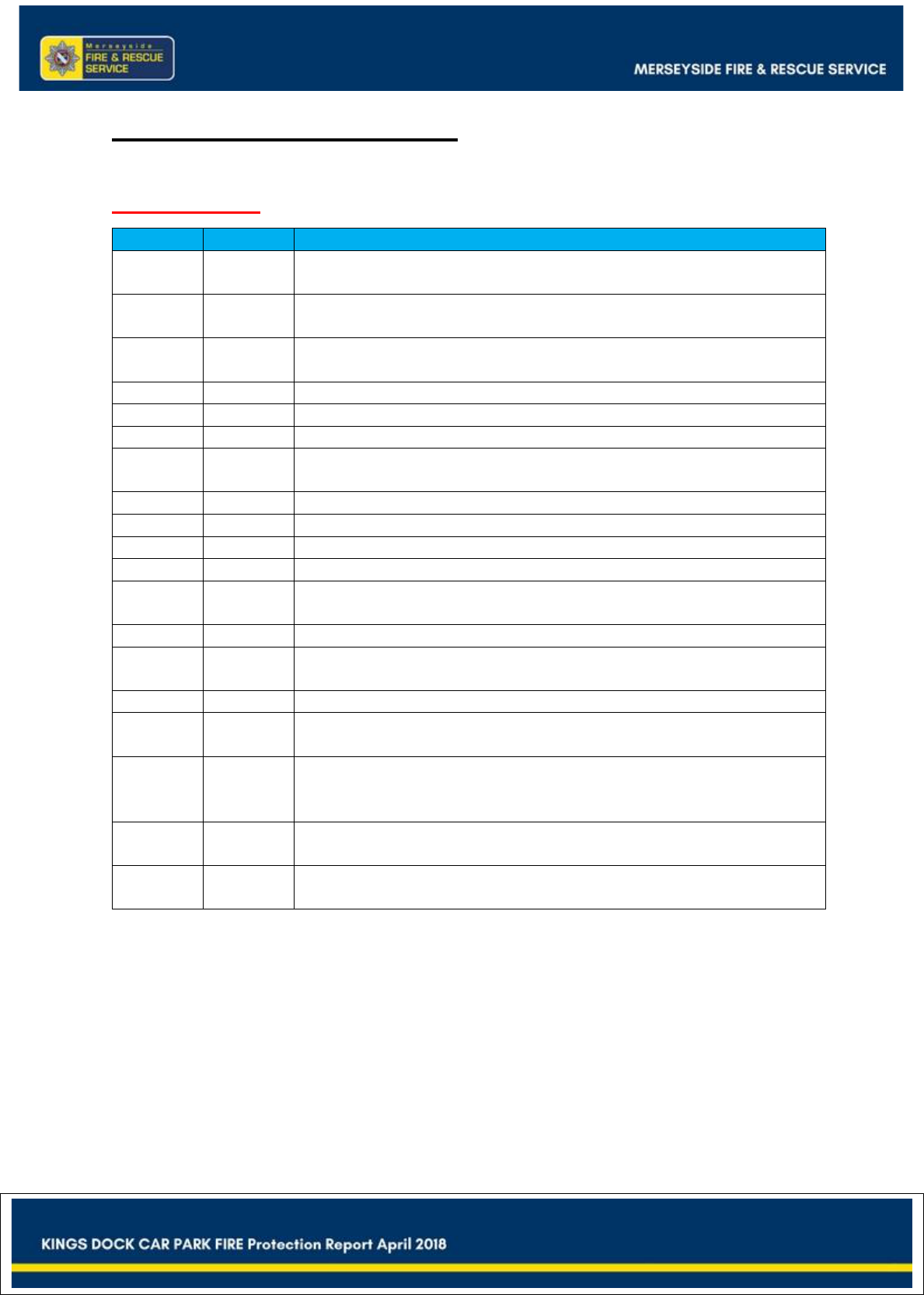
2
EXECUTIVE SUMMARY
BRIEF TIMELINE
Time
Date
Details
16:29
31.12.17
Internal car park CCTV - first signs of fire (smoke) from the
vehicle
16:37
31.12.17
External CCTV – first signs of smoke in Plaza area (pedestrian
space between the car park and ACCL)
16:42
31.12.17
First call to the Fire and Rescue Service (999 call from member
of public)
16:43:
31.12.17
First fire alarm actuation (break glass call point)
16:43
31.12.17
Two fire appliances mobilised
16:44
31.12.17
First call received from LCC at venue.
16:45
31.12.17
Event firefighting team arrive at main entrance, under blue
lights
16:50
31.12.17
MF&RS appliance in attendance at main entrance
16:56
31.12.17
Assistance message – “Make pumps 3”
16:56
31.12.17
External firefighting begins
17:01
31.12.17
Assistance message “Make pumps 6”
17:08
31.12.17
First BA team (Alpha 1) committed from stairwell 2 into level 3
(Sector 2)
17:31
31.12.17
Assistance message – “Make pumps 8”
17:40
31.12.17
BA crews report up to 30 vehicles involved and running fuel
fire between rows of cars
17:41
31.12.17
Assistance message – “Make pumps 12”
17:52
31.12.17
Internal CCTV – first signs of flame from level 4, in location
away from ramps and above initial fire on level 3
18:07
31.12.17
First BA team (Bravo 1) committed from stairwell 1 to level 3
(Sector 3). Report clear view of fire due to wind conditions. Fire
confined to two rows of vehicles, away from ramps
18:20 -
18:25
31.12.17
All BA crews withdrawn from sector 2 due to untenable fire
conditions
18:38
31.12.17
Emergency evacuation of all teams due to concerns over
firefighter safety
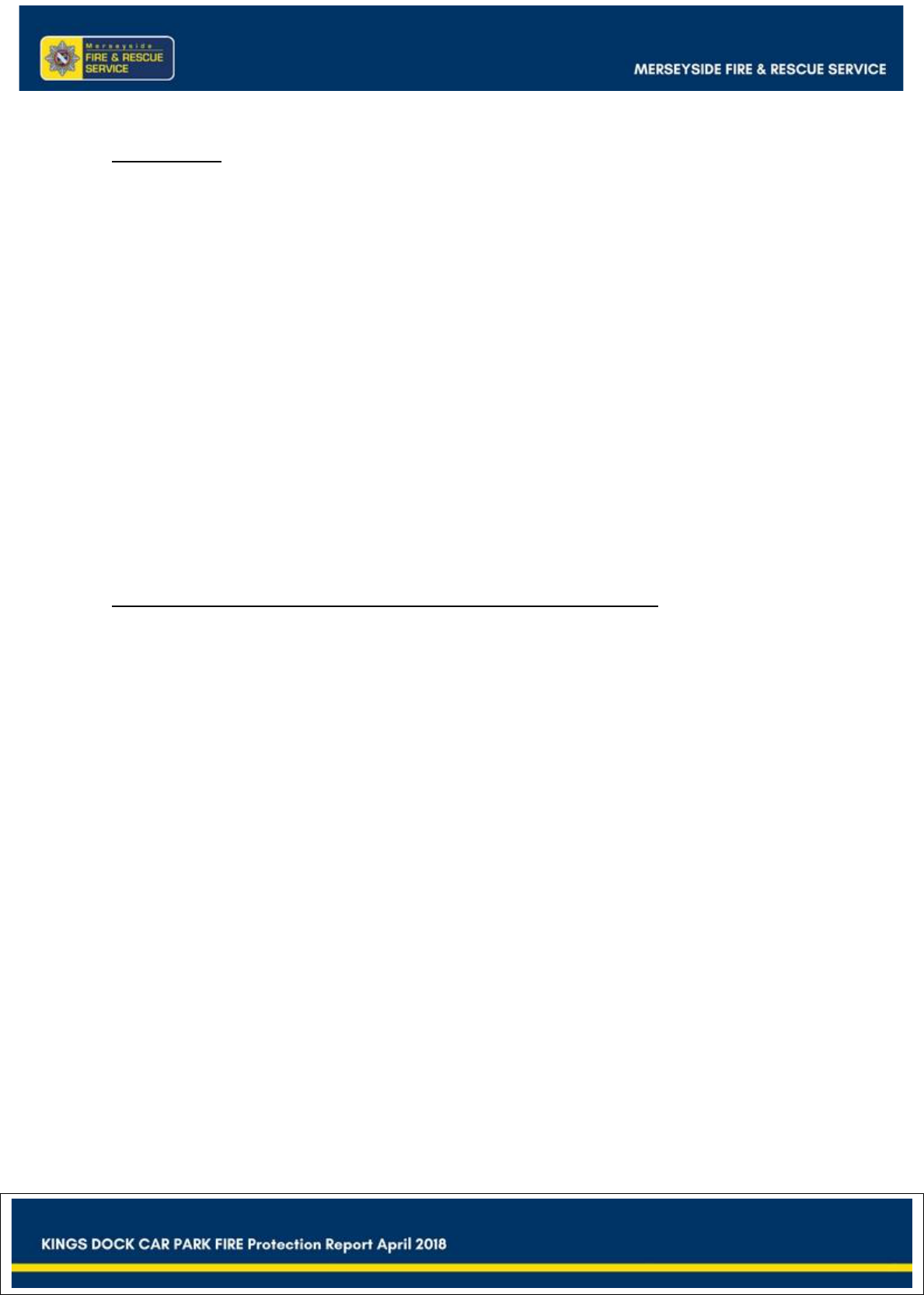
3
The Incident
MF&RS were alerted to a car on fire on the 3
rd
floor of the Kings Dock Car Park at
16:42hrs, New Year’s Eve, Sunday 31
st
December 2017. The resulting blaze led to
the loss of approximately 1,150 vehicles and so severely affected the fabric of the
building, that demolition is the likely outcome.
Fire Investigation activities began at the Kings Dock Car Park at 18:22hrs on 31
st
December with the attendance of the MF&RS Incident Investigation Team (IIT). Over
the following weeks MF&RS Protection Department worked closely with IIT and
various stakeholders (ACCL, LCC, OCS, BRE, LIHSBE and WH Management).
CCTV footage shows that the fire started in a vehicle on level 3. Attending fire crews
reported rapid lateral fire spread, running fuel fires, vertical fire spread from level of
origin and a “waterfall” of fire from the ceiling of level 3. It was initially thought that fire
spread was via the central ramps, but upon further investigation it is considered that
the drainage system was the likely cause of vertical fire spread.
Building Regulations & MF&RS Involvement with the Building
Kings Dock car park is an 8 level, open-sided construction, comprising a ground and
seven upper floors. Construction was completed in 2007. The car park is an ‘open-
sided’ car park, subject to natural ventilation.
MF&RS took part in the Building Regulations consultation process on the car park. As
a result of MF&RS submissions, it was agreed that firefighting shafts would be installed
within the building. This was due the building’s size and the lack of access afforded to
external firefighting appliances, on two of its elevations. The building was constructed
to these specifications. When it opened in November 2007 it complied with Building
Regulations.
On 2
nd
November 2012 and on 2
nd
December 2015, MF&RS Fire Safety Inspectors
audited the premises under the Regulatory Reform (Fire Safety) Order 2005 (RR(FS)O
2005). On both occasions the outcome was broadly compliant, although the use of
advertising on the external facia of the ground level of the car park was identified as
potentially affecting cross ventilation.
Due to the complex and diverse nature of the events that are held at ACCL and the
inherent changes in fire strategies associated with these complexities, MF&RS had
served ACCL with an Alterations Notice in 2008 (see Appendix 2).
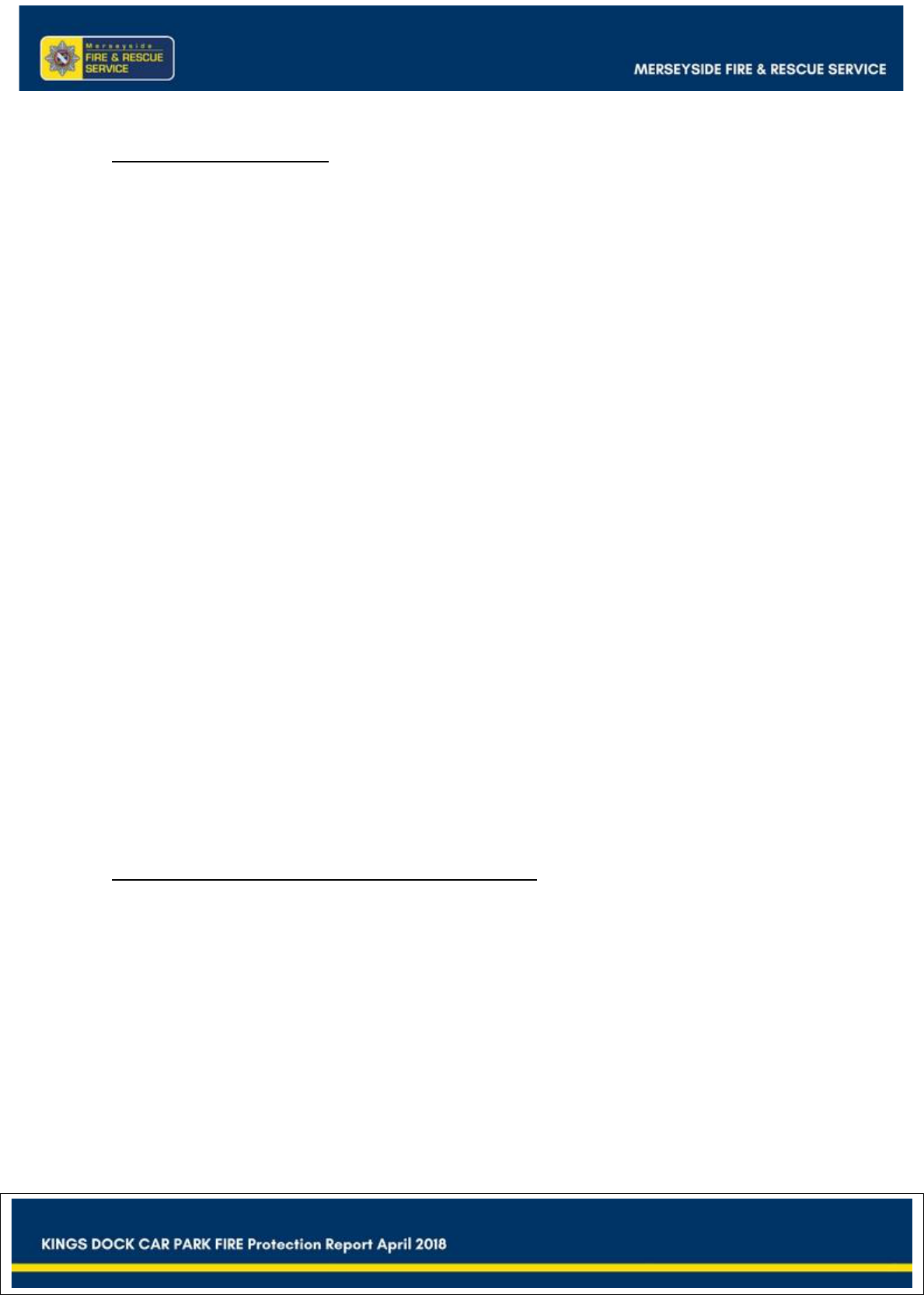
4
Fire Spread in Car Parks
In 1968, The Ministry of Technology and Fire Offices’ Committee Joint Fire Research
Organisation researched and concluded that fire spread from one vehicle to others
would not occur and that if it did, the Metropolitan Brigades would invariably be in
attendance within 3 to 4 minutes. “This research underpinned the recommendations
in Approved Document B.” (Fire Spread in Car Parks BD 2552 p.15). The fire
resistance requirements under Building Regulations have not increased since the
1968 paper.
In 2006, the Department for Communities and Local Government (DCLG)
commissioned the Building Research Establishment to carry out a 3 year project titled
“Fire Spread in Car Parks” (BD 2552). Although there had been few deaths or injuries
recorded to that date in the UK, there were concerns regarding new and emerging
risks from modern cars and alternative fuels.
This research demonstrated, amongst other things, that:
sprinklers are effective in both controlling a developing and fully developed fire
running fuel fires spread the fire
current methods to calculate ventilation openings from open-sided car parks
and mechanical ventilation in enclosed car parks needed to be considered
the ease with which a car fire in a car park spread to nearby cars and once a
very severe fire has developed, fire will spread to other cars separated by an
un-filled parking bay, and
fire conditions in partial and fully closed car parks are much more severe than
in open sided car parks.
The report concluded that the current fire resistance recommendations for car parks
in ADB needed to be kept under revision and that calculations for smoke control and
smoke clearance need to be carefully considered (BD 2552 p.98).
Fire Protection and Management of the Building
The active and passive fire protection measures within the building complied with
regulatory requirements and performed beyond the required standard during the
incident.
The complex relationship between ACCL and LCC has led to a somewhat over-
complicated management of fire safety within the building. This appears to have led
to some confusion amongst staff as to who is responsible for the management of the
building. This has the potential to become further complicated during large events,
such as the Liverpool International Horse Show.
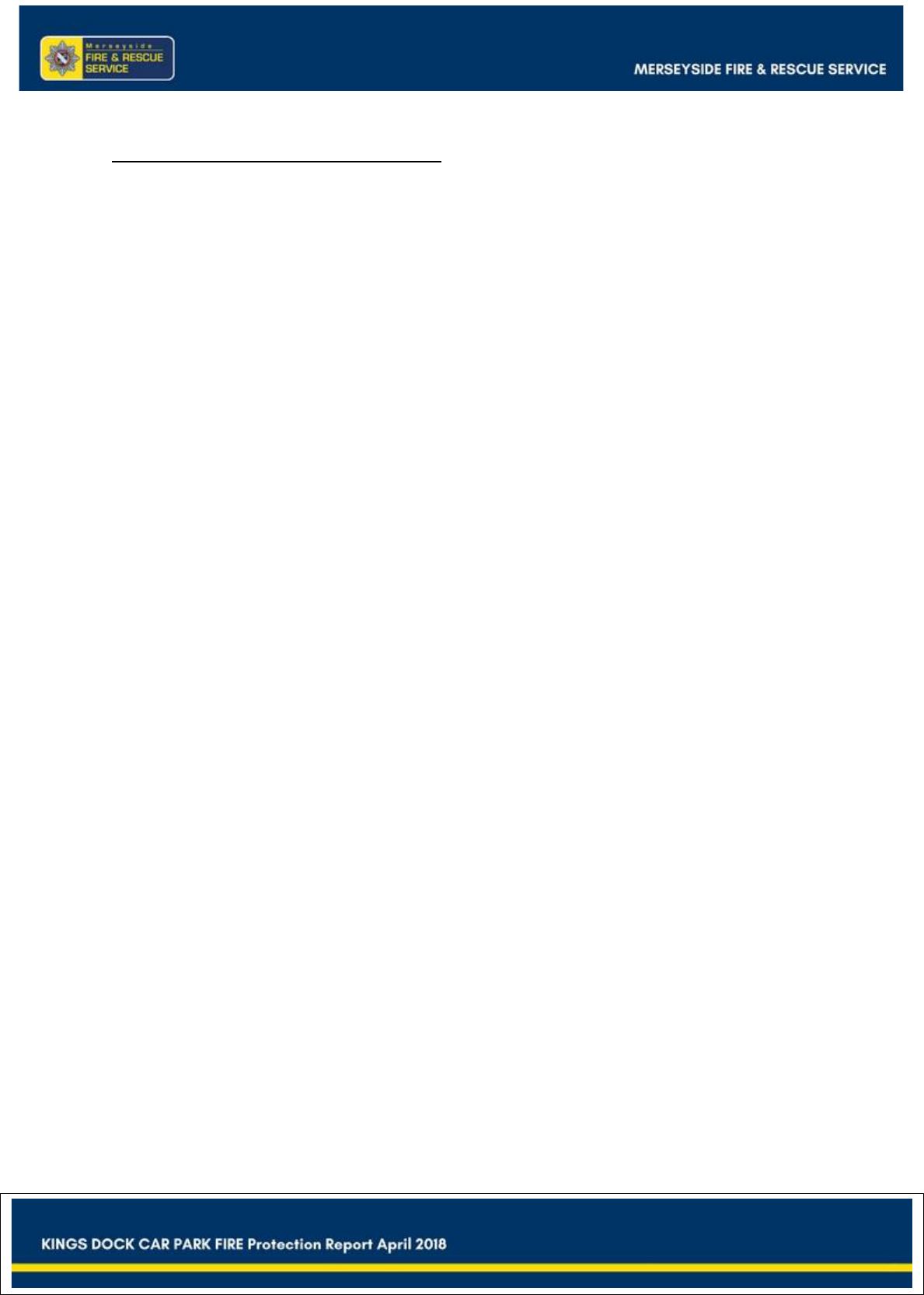
5
Observations and Recommendations
Fire will spread from vehicle to vehicle in car parks, be they open air, open-sided or
enclosed. This has been proved in both simulated experiments in the UK and abroad
and in actual incidents, such as Boomtown Festival, Monica Wills (see Related
Incidents p.51) and Kings Dock fires.
Fire may spread beyond floor of origin. In the case of Kings Dock this was likely to
have been through the drainage system and failure of the ribbed slab floors in the early
stages of the incident, although the geometry and central ramp design, combined with
running fuel fires, certainly contributed later on.
Running fuel fires, due to failure of plastic fuel tanks, in early stages of vehicle fires
can be expected. It is estimated 85% of European vehicles have plastic fuel tanks.
Sprinklers are effective in both controlling a developing and fully developed fire.
Without sprinklers fire is likely to spread from car to car and dangerous levels of smoke
are likely for long periods (BD2552 p.46). Designers should seriously consider
sprinkler provision to avoid multiple vehicle fires, resulting in huge insurable losses
and the possible loss of life.
Fire may spread beyond floor of origin. In the case of Kings Dock evidence would
suggest that this was initially through the failure of the drainage system. Designers
should give serious consideration to the implications of drainage design that could aid
fire spread between levels.
The fire safety management of buildings needs to be simplified and clear to all.
Although not a contributory factor during this incident, careful consideration should be
given to using car parks for purposes other than the parking of vehicles, in future.
Current building regulations for car parks should be reviewed in light of this incident.
Private response teams should make every attempt, as far as is reasonably
practicable, to ensure that their personnel, equipment and vehicles are not mistaken
for emergency services. The requirement for response under blue lights by such teams
is questionable.
MF&RS would advocate more public information as to what their actions should be
upon discovering a fire and the potential positive and negative effects of members of
public recording and streaming live emergency incidents and the impact this has on
the emergency services and any potential victims
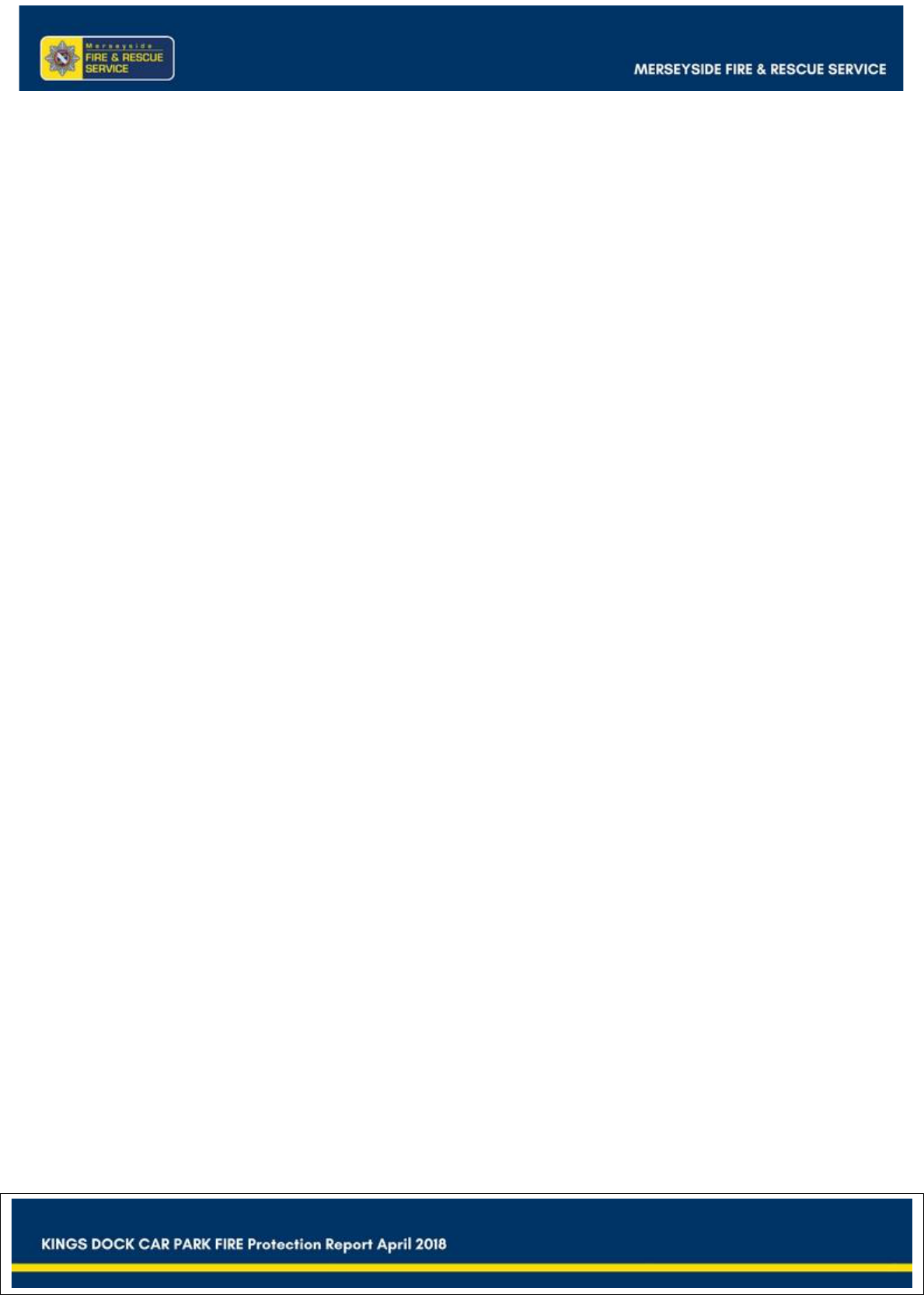
6
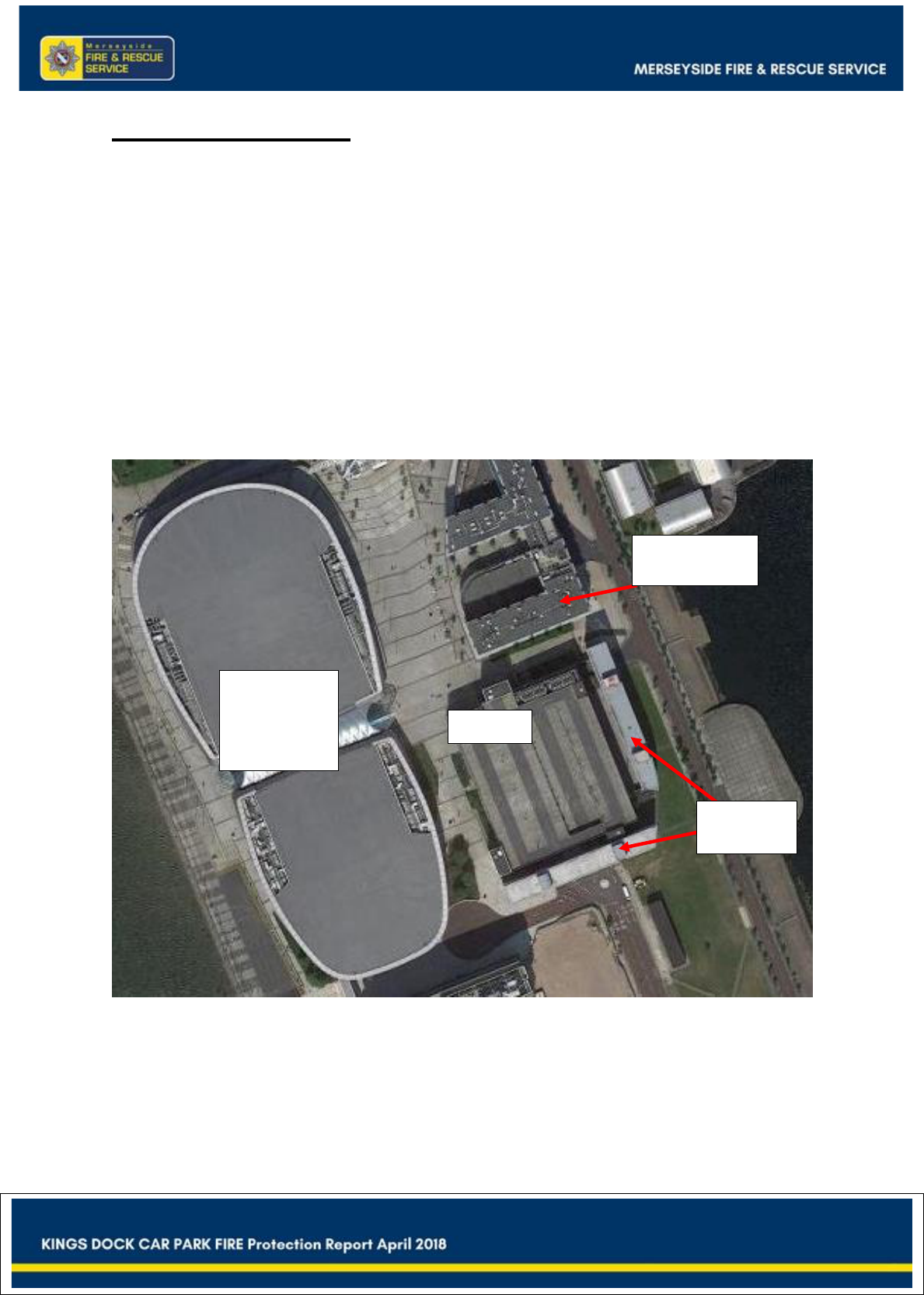
7
INTRODUCTION
Kings Dock car park is an 8 level, open-sided construction, comprising a ground and
seven upper floors, the seventh being roof top parking. The footprint is 4930m². The
construction method is concrete columns and beams, with tied in reinforced pre-cast
ribbed concrete floors. The building is surrounded to the south and east by blocks of
serviced apartments, which lie in very close proximity (6m) to the car park, and to the
north by the Staybridge Suites Hotel, which is separated from the car park by a 15m
concourse. To the west, lies the Arena and Convention Centre Liverpool (ACCL).
There is a service road running under the concourse between the car park and the
Staybridge Suites, which leads to a loading bay and this is used for importing and
exporting equipment, people and animals for shows and conventions held in the Echo
Arena.
Figure 0.1: Aerial view
A planning application for the car park was submitted to MF&RS for consultation in
2005 and construction was completed in 2007. There is capacity for 1,600 cars and
unlike many public car parks, the occupancy is likely to be extremely high at the start
and end of concerts in the ACCL. The capacity is reduced to 1,460 for events where
the ground floor is used for purposes other than parking.
Apartment
blocks
Staybridge
Suites Hotel
Car park
Arena &
Conference
Centre
Liverpool
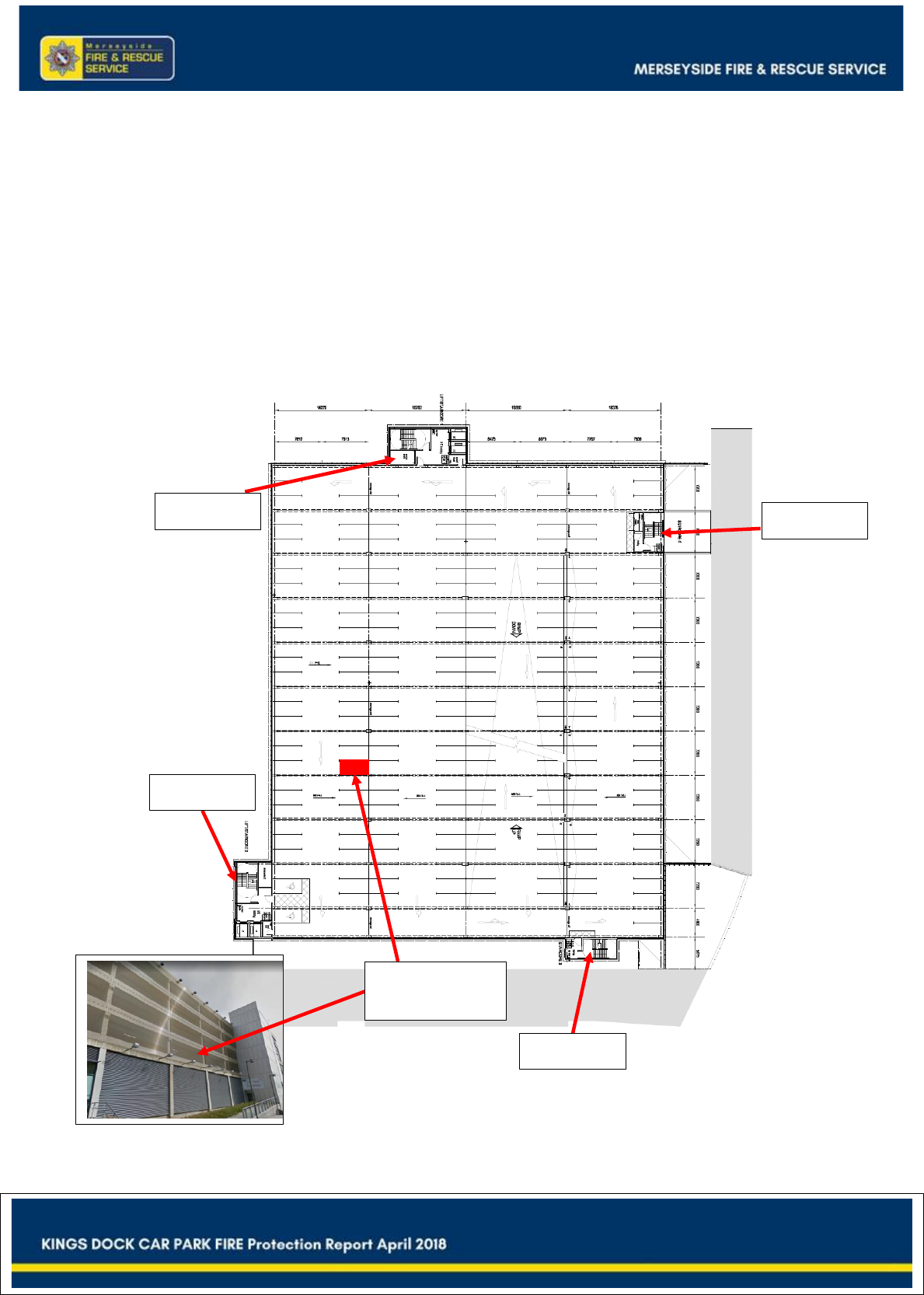
8
MF&RS were alerted to a car on fire on the 3
rd
floor of the Kings Dock Car Park at
16:42hrs, New Year’s Eve, Sunday 31
st
December 2017. The resulting blaze led to
the loss of approximately 1,150 vehicles and so severely affected the fabric of the
building that demolition is the likely outcome. A visiting contingent from the Building
Research Establishment (BRE) on 10
th
January 2018 likened the fire to a
petrochemical fire; due to the heat generated and the behaviour of the concrete
structure (evidence of explosive spalling, floor failure and structural element damage).
Figure 0.2: Level 3 floor plan
Stairwell 4
Position of
vehicle of origin
Stairwell 1
Stairwell 2
Stairwell 3
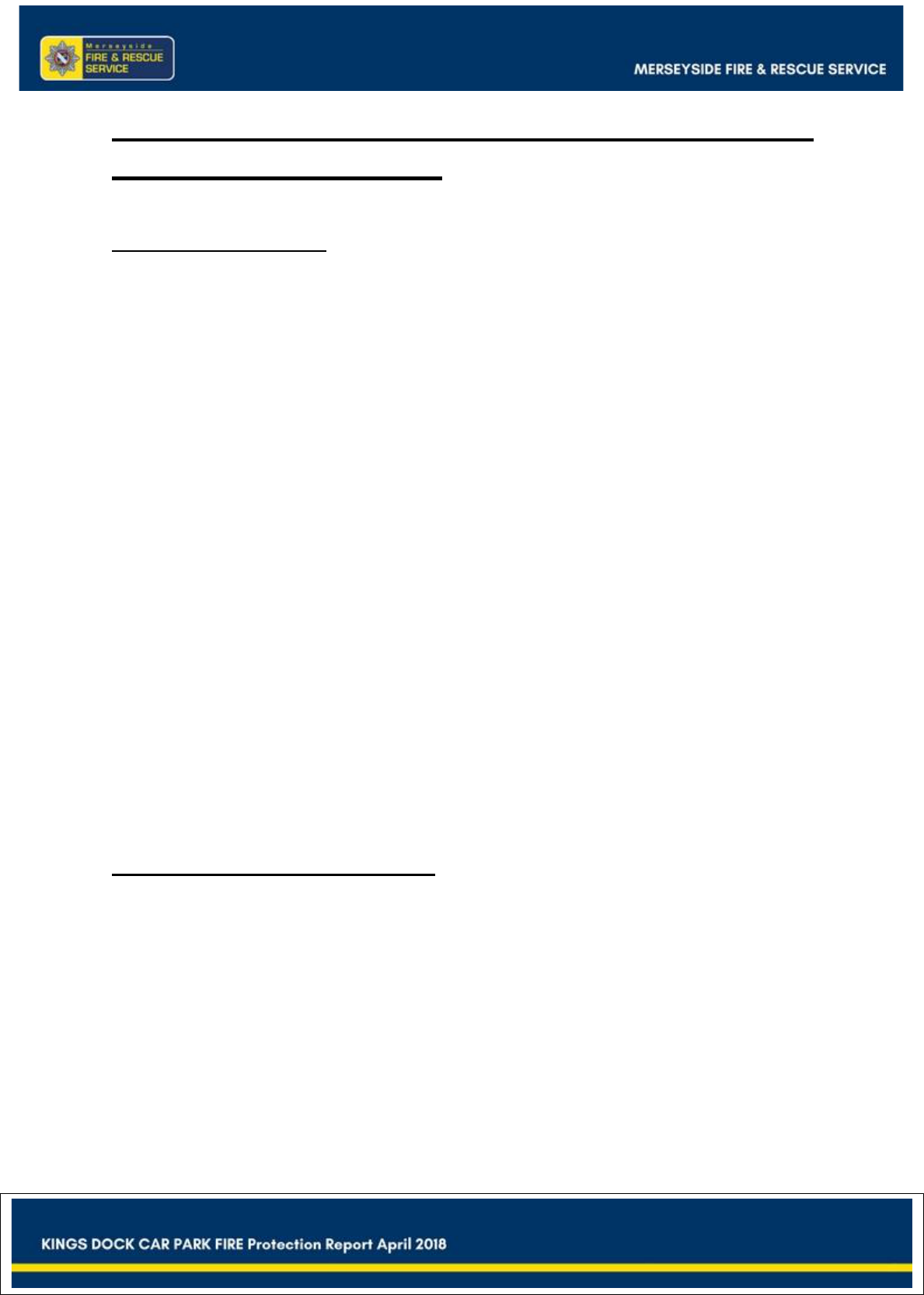
9
1. BUILDING CONSTRUCTION AND DESIGN
FIRE REQUIREMENTS
1.1 Design Specification
The design construction submission for the Kings Dock car park was submitted as
follows: an 8-storey structure built of precast reinforced concrete. The form of
construction is portal frame providing clear span across the parking bays, which, in
turn, supports a precast reinforced concrete floor deck. The beams and columns are
connected using grouted rebar and coupled rebar. The top section of the beam is cast
in-situ, which forms a monolithic connection between slab, beam and column.
The car park is an ‘open-sided’ car park, subject to natural ventilation (see Section 4.
Natural Ventilation). Stability is achieved by the long ramp augmented by the stair
cores, which are constructed in 170mm thick precast concrete walls with tied precast
landings. The designer was responsible for all in-situ concrete groundworks, retaining
structures and below ground drainage layouts. The ground floor slab is designed as
load bearing.
Under the fire design table, contained within the submission, the following information
is given:
15mins fire resistance – open sided car park.
2hr to stair walls/1hr to compartment floors provided by slabs (additional fire
protection may be provided by spray applied system).
Observations and recommendations
1. The solid elements of structure (columns beams and walls) meant that the building
was able to structurally withstand the fire for a period well in excess of the 15 minute
requirement under the guidance in ADB (see 1.2). Under the current Integrated Risk
Management Plan, MF&RS response standard is 10 minutes on 90% of occasions.
Therefore, 15 minutes fire resistance to any building will severely restrict safe
firefighting operations capabilities.

10
1.2 Building Regulations
In Approved Document B, Volume 2 (buildings other than dwelling houses) 2010,
section 11.2 gives the following general principles for buildings used for parking cars:
a. The fire load is well defined; and
b. Where the car park is well ventilated, there is low probability of fire spread from
one floor to another
11.3 gives the following requirements to conform to the definition of an open sided car
park:
a. there should not be any basement storeys;
b. each storey should be naturally ventilated by permanent openings at each car
parking level, having an aggregate vent area not less than 1/20
th
of the floor
area at that level, of which at least half (1/40
th
) should be equally provided
between two opposing walls;
c. where one element of structure supports or carries or gives support to another,
the fire resistance of the supporting element should be no less than the
minimum period of resistance for the other element (whether that element is
load bearing or not).
d. If the building is also used for any other purpose, the part forming the car park
is a separated part and the fire resistance of any element of structure that
supports or carries or gives stability to another element in the other part of the
building should be no less than the minimum period of fire resistance for the
elements it supports; and
e. All materials used in the construction of the building, compartment or separated
part should be non-combustible, except for:
i. Any surface finish applied to a floor or roof of the car park, or
within any adjoining building, compartment or separated part to
the structure enclosing the car park, if the finish meets all aspects
of the guidance on requirements B2 and B4;
ii. Any fire door
iii. Any attendant’s kiosk not exceeding 15m
2
in area; and
iv. Any shop mobility facility
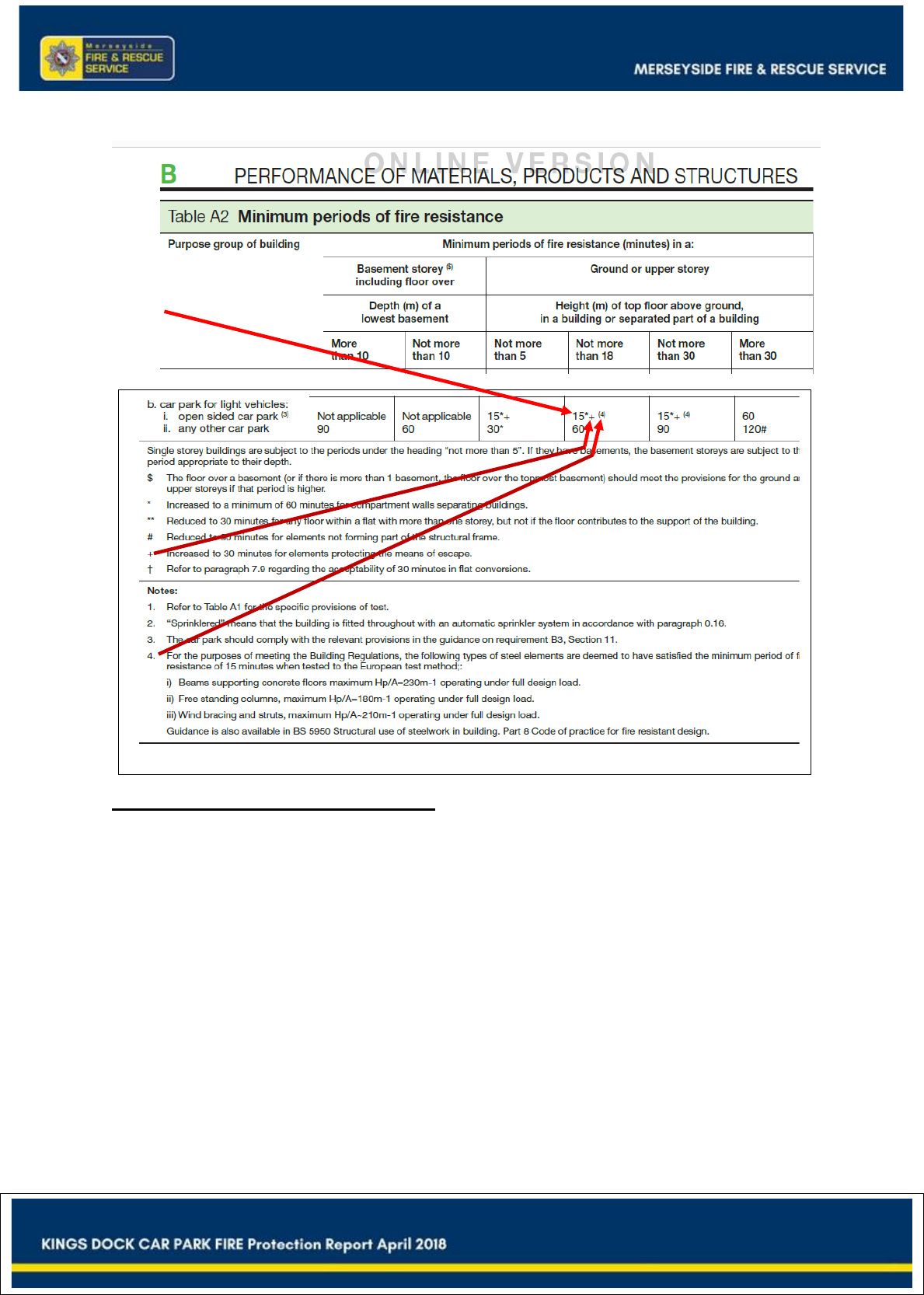
11
Figure1.2.1: ADB Vol.2 Table A2 Minimum Periods of Fire Resistance
Observations and recommendations
1. ADB states: “the fire load is well defined.” This is based on out-dated research
on old vehicles and requires further consideration.
2. ADB states: “Where the car park is well ventilated, there is low probability of
fire spread from one floor to another.” This was clearly not the case at this
incident and requires revision.
3. The sheer size of Kings Dock Car Park brings into question the validity of
categorising it as open-sided. Even the more up to date research, which was
conducted in relatively small rigs by BRE (see section1.4), could not possibly
replicate smoke dispersal and heat release within a 24,000m² structure.
Current methods for calculating ventilation openings for smoke clearance from
open-sided car parks should be reviewed.
4. Under current guidance in ADB, there is no requirement for sprinklers within
an open-sided car park. Serious consideration should be given to the
provision of sprinklers.
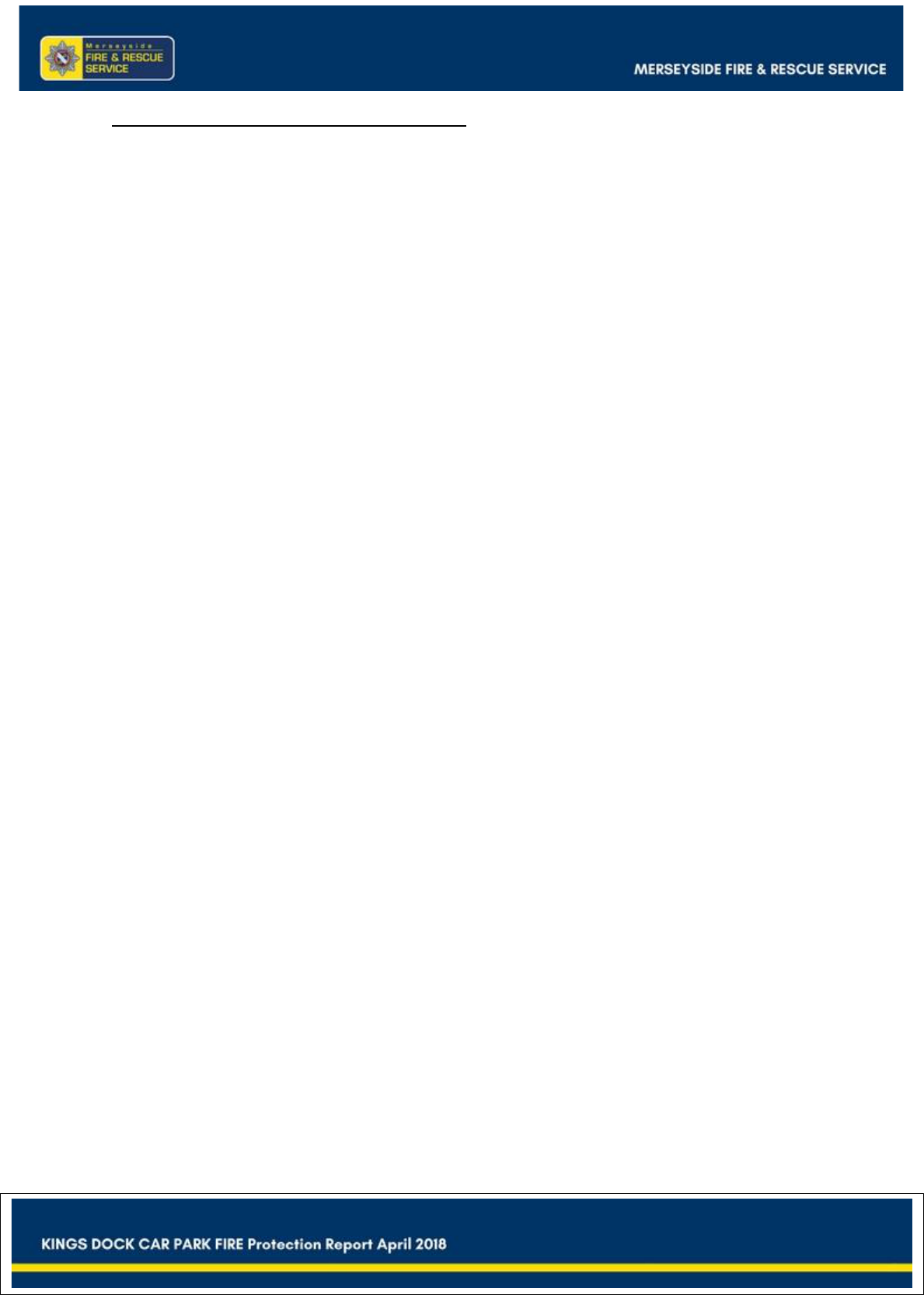
12
1.3 Background Research into Car Fires
In 1968, The Ministry of Technology and Fire Offices’ Committee Joint Fire Research
Organisation produced Fire Note No.10, “Fire and Car-Park Buildings”. This document
was the result of a research experiment, exploring the likelihood of fire spread from
one vehicle to another, which would, in turn, determine the fire resistance
requirements of the structures. The structures were classed as ‘light storage’ and had,
up until then, been mainly constructed from reinforced concrete, which was the
cheapest construction material that would comply with fire resistance of 1 hour under
the Building Regulations 1965.
However, the document noted that if fire resistance requirements were removed, then
a steel frame construction would be cheaper. It states in its summary, “The
experimental work carried out…..confirms the fact that an outbreak of fire,
within a single parked car, is unlikely to result in uncontrollable fire spread in
the car park or in serious damage to the structure of the building.”
This research formed the basis of fire resistance requirements in car parks under
Building Regulations and although newer research has taken place in England (BRE
conducted a 3 year experiment and published its findings in 2010 – see 1.4) and
around the world, the fire resistance requirements under Building Regulations have
not increased since the 1968 paper. With this in mind, it is worth noting the following
facts, findings, calculations and assumptions from the research and on which Fire Note
10 was written. Viz:
“…the parking area for each car is considerably larger than the floor area which
each car covers” (Spacing of Vehicles Fire Note 10 p.2). This indicates that cars
manufactured in the 1950’s are considerably smaller than the parking spaces
provided under regulatory requirements and this would give a greater distance
between cars, thus reducing effects of radiated heat. However, cars are now
considerably larger, reducing the distance between parked vehicles.
“One of the major hazards considered was the disruption of the petrol tanks
and the flowing of petrol under other cars in the vicinity via the sloping concrete
ramp. In no case did this occur.” (Fire Note 10 Explosion Risk p.7). It is
estimated 85% of European vehicles have plastic fuel tanks (BRE Fire Spread
in Car Parks BD 2552 p.12).
“From visual observations made during the tests, the smoke layer was mainly
at ceiling level and would have caused the fire brigade little or no difficulty in
dealing with the outbreak” (Fire Note 10 Risk of Smoke Obscuration p.8)
“…in Metropolitan Boroughs the fire brigade attends 4 out of 5 fires within 3 min
and it is therefore difficult to see how a sustained fire could take hold.” (Fire
Note 10 An assessment of the Risk p.9)
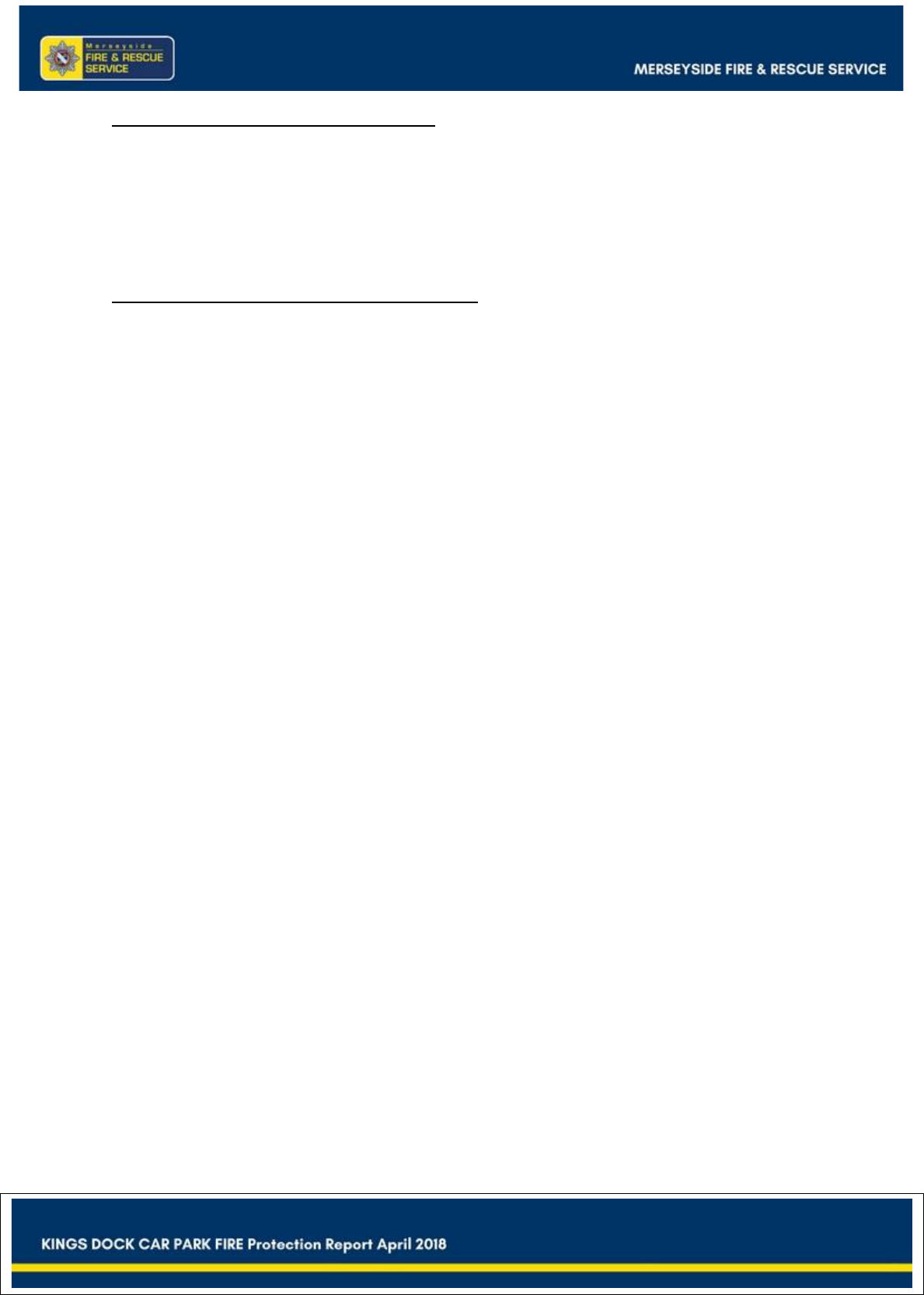
13
Observations and recommendations
1. The cars used and the materials they were constructed from have a far lower
calorific value than modern vehicles.
2. The cars used for the experiment were far smaller than most modern vehicles.
1.4 BRE Fire Spread in Car Parks BD2552
In 2006, DCLG Sustainable Buildings Division commissioned BRE to carry out a 3
year project titled “Fire Spread in Car Parks”. As a result, document BD 2552 was
produced in December 2010. Although there had been few deaths or injuries recorded
to that date in the UK, there were concerns regarding new and emerging risks from
modern cars and alternative fuels. The overall aim of the project was to gather
information on the nature of fires involving the current design of cars and to use this
knowledge as a basis, if necessary, to update current guidance in ADB Vol.2 on fire
safety strategies for car parks (see section 1.2). Historical research was conducted
and a number of different scenarios were tested over the 3 years and the following
notable observations and conclusions were made:
Average heat release per vehicle of 4.75 MW at the Monica Wills car park fire
2006. (BD 2552 Car Fires p.14)
“In a number of incidents, a running fuel fire was reported, which spread the
fire.” (BD 2552 Car Fires p.14).
“Sprinklers are effective in both controlling a developing and fully developed
fire, without sprinklers fire is likely to spread from car to car and dangerous
levels of smoke are likely for long periods.” (BD 2552 Research p.15).
“Fires in open car parks behave in a very similar manner to fully closed car
parks in terms of obscuration and toxic product concentrations.” (BD 2552
Research p.15).
“Fire conditions in partial and fully closed car parks are much more severe than
in open sided car parks.” (BD 2552 Research p.16).
In Test 1, car 1 (Renault Laguna petrol 2002) burnt for 20minutes at 2MW, but
within 2 minutes of car 2 (Renault Clio petrol 1998) igniting, the intensity
reached 16MW and a ceiling temperature of 1100°C. There was extensive
spalling of concrete roof slabs during this test. (BD2552 2.9.1 Observations
and Results p.39).
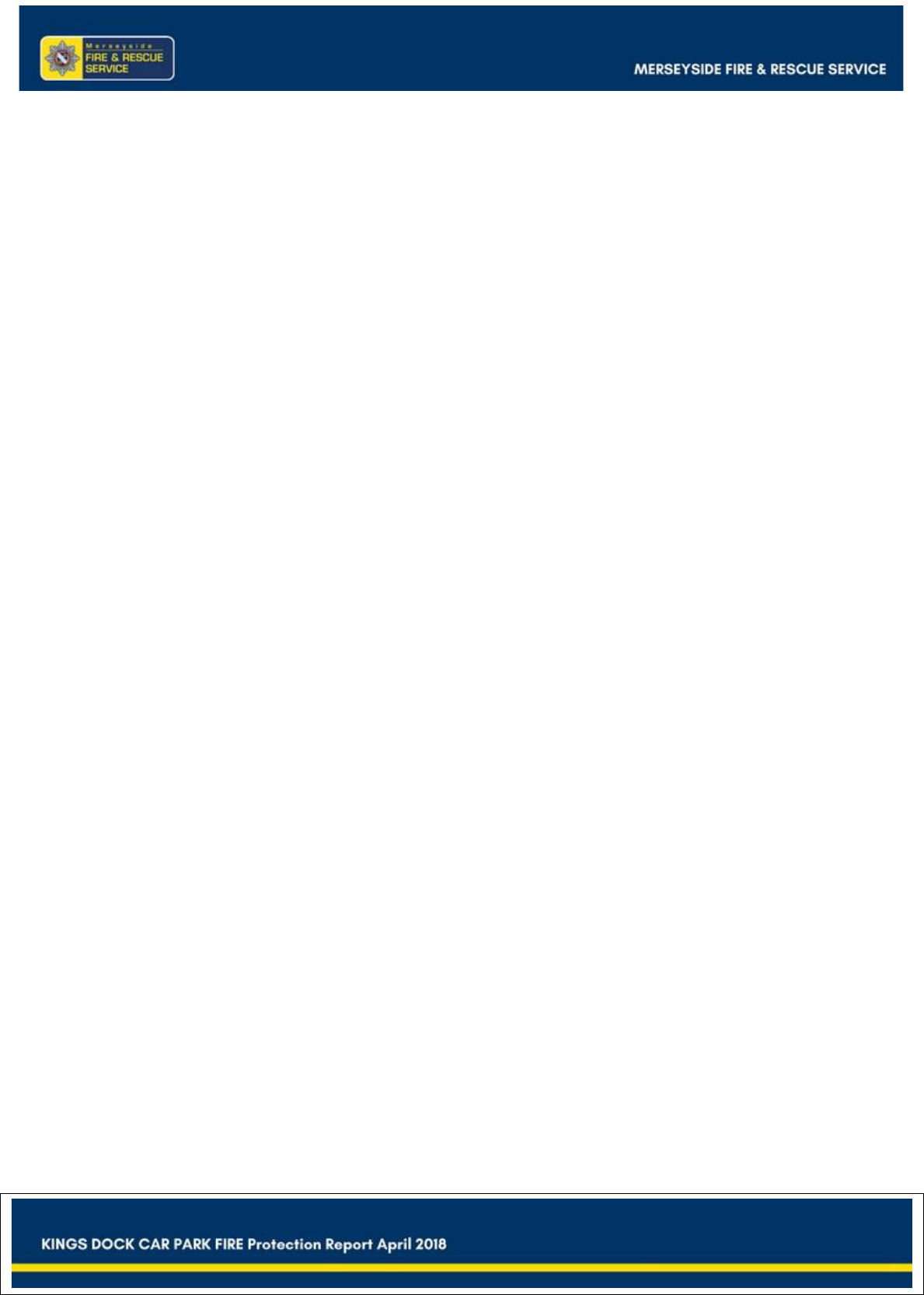
14
“Fires in car parks for which the building is classified as ‘flats’ show an injury
rate that is quite high compared with other types of premises” (BD2552
Statistics p.95).
“…serious concerns regarding car ‘stackers’” (BD2552 Car park design p.95).
‘‘Timber framed and other innovative designs need to be kept under review’’
(BD2552 Car park design p.95).
“The Monica Wills incident is the most recent incident to demonstrate that fire
can spread between cars and that, in extreme cases, very many cars can burn
out with a very high heat release rate (and substantial structural damage); the
“traditional” view that car fires do not spread was substantially refuted by this
incident……However, there is no evidence to indicate that the current
provisions in ADB for the protection of car parks need revision.” (BD 2552
3.5 Fire Development).
“As well as the structural damage caused, spalling can be dangerous for
firefighters.” (BD2552 Fire Resistance p.97).
Although there were no cases of structural collapse of a car park due to fire in
the UK, there have been cases in Europe. Notably, Gretzenbach in
Switzerland, where an underground car park collapsed, resulting in the death
of 7 firefighters (BD2552 Fire Resistance p.98).
“Current methods to calculate ventilation openings…from open-sided car
parks, and…..enclosed car parks need to be considered,” (BD2552 3.9
Ventilation and smoke control p.98).
“The ease with which a car fire in a car park might spread to nearby cars has
been demonstrated. Once a very severe fire has developed, fire will spread to
other cars separated by an un-filled parking bay.” (BD2552 4.1 General
Conclusions p.99)
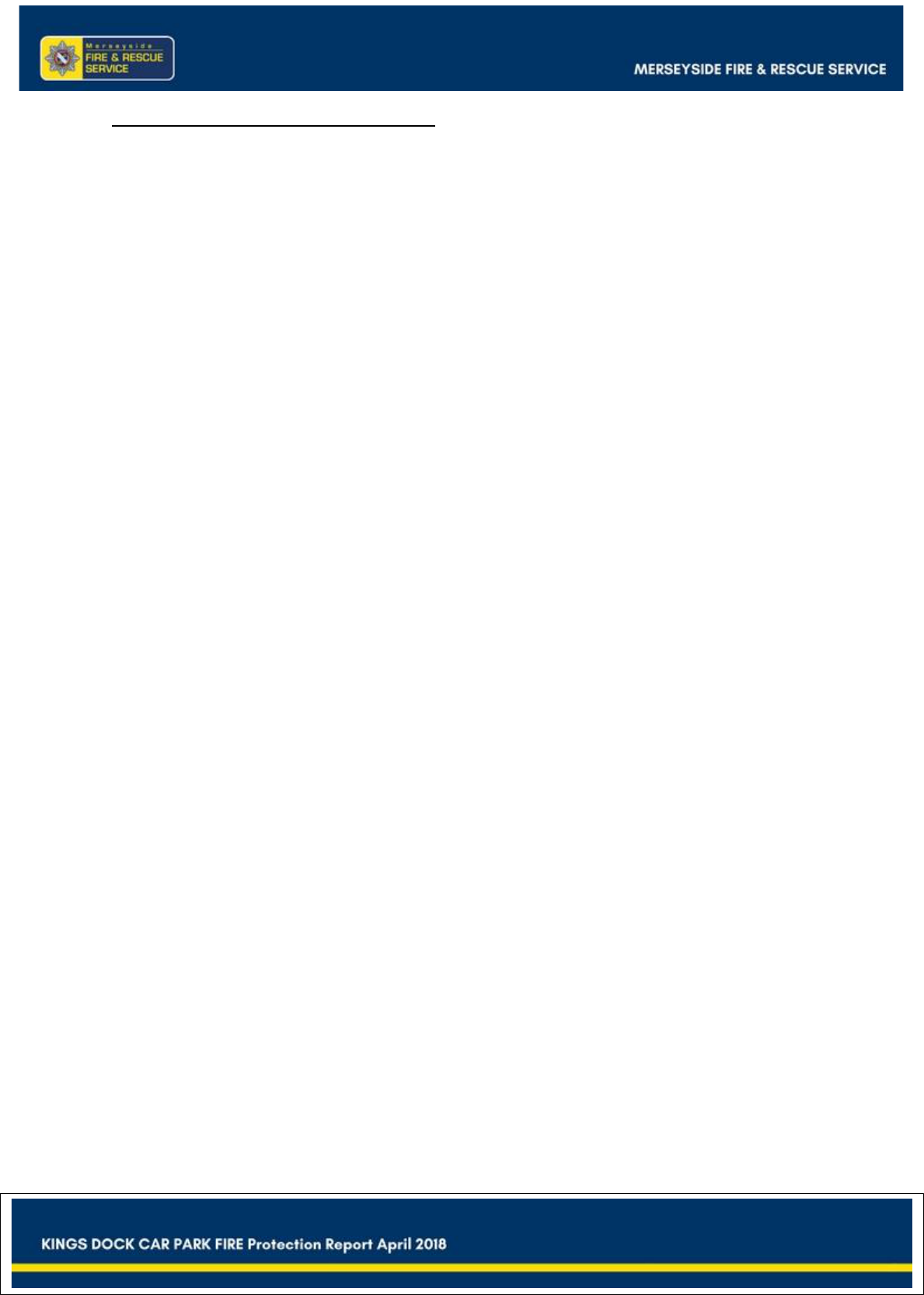
15
Observations and recommendations
1. The more modern the vehicle, the higher calorific potential (Natural fires in
closed car parks: Car Fire Tests, Daniel Joyeux 1997). Further research on
modern vehicles should be commissioned, in order to ascertain conformity to
current fire resistance standards under building regulations.
2. Radiated heat and direct flame impingement, due to larger vehicles in restricted
spaces and low ceilings, will give temperatures in excess of 1100°C (BD2552
p.64). Spacing of vehicles and ceiling height in car parks should be reviewed.
3. Sprinklers are effective in both controlling a developing and fully developed fire.
Without sprinklers fire is likely to spread from car to car and dangerous levels
of smoke are likely for long periods (BD2552 p.46). Designers should seriously
consider sprinkler provision to avoid multiple vehicle fires, resulting in huge
insurable losses and the possible loss of life.
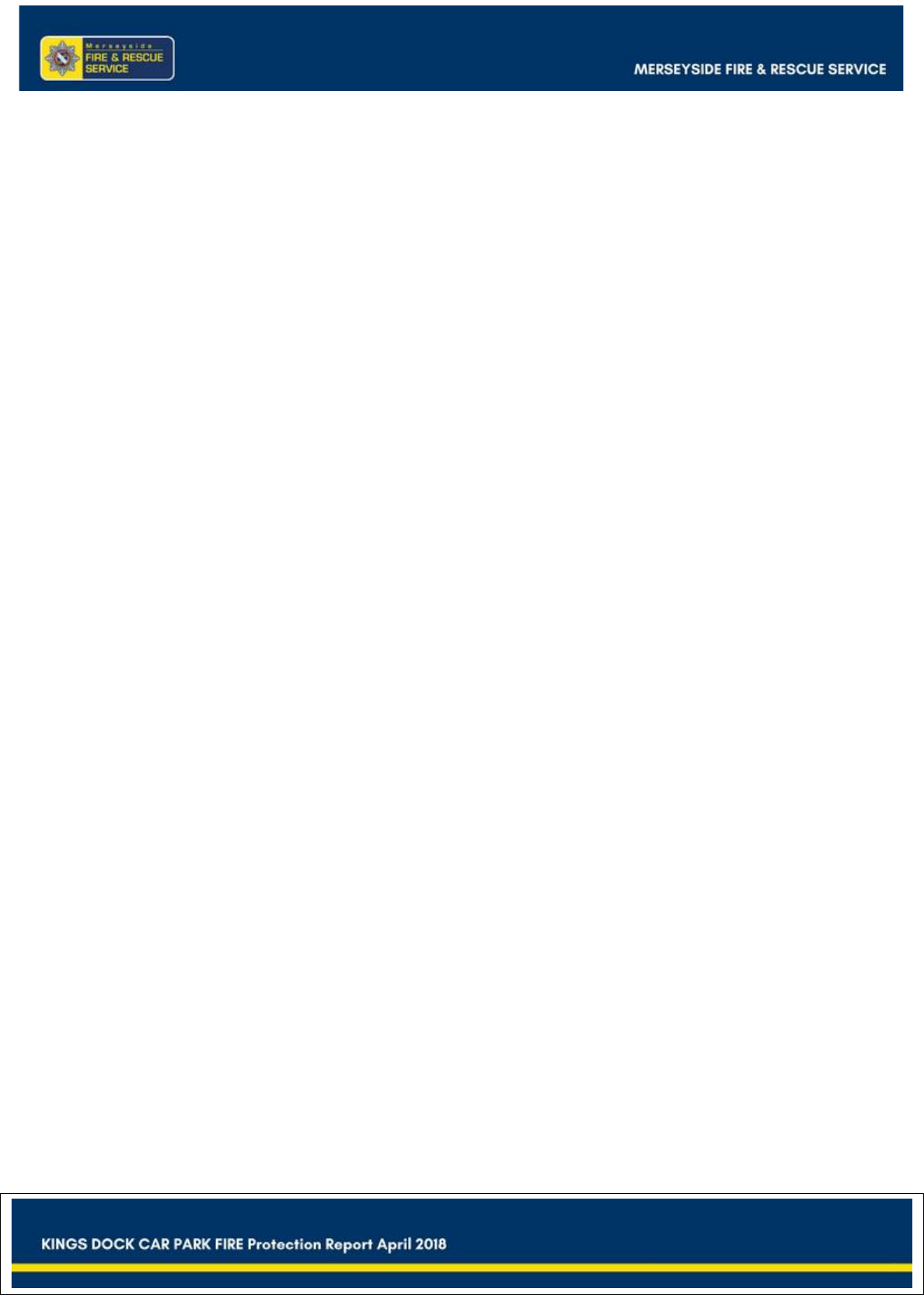
16
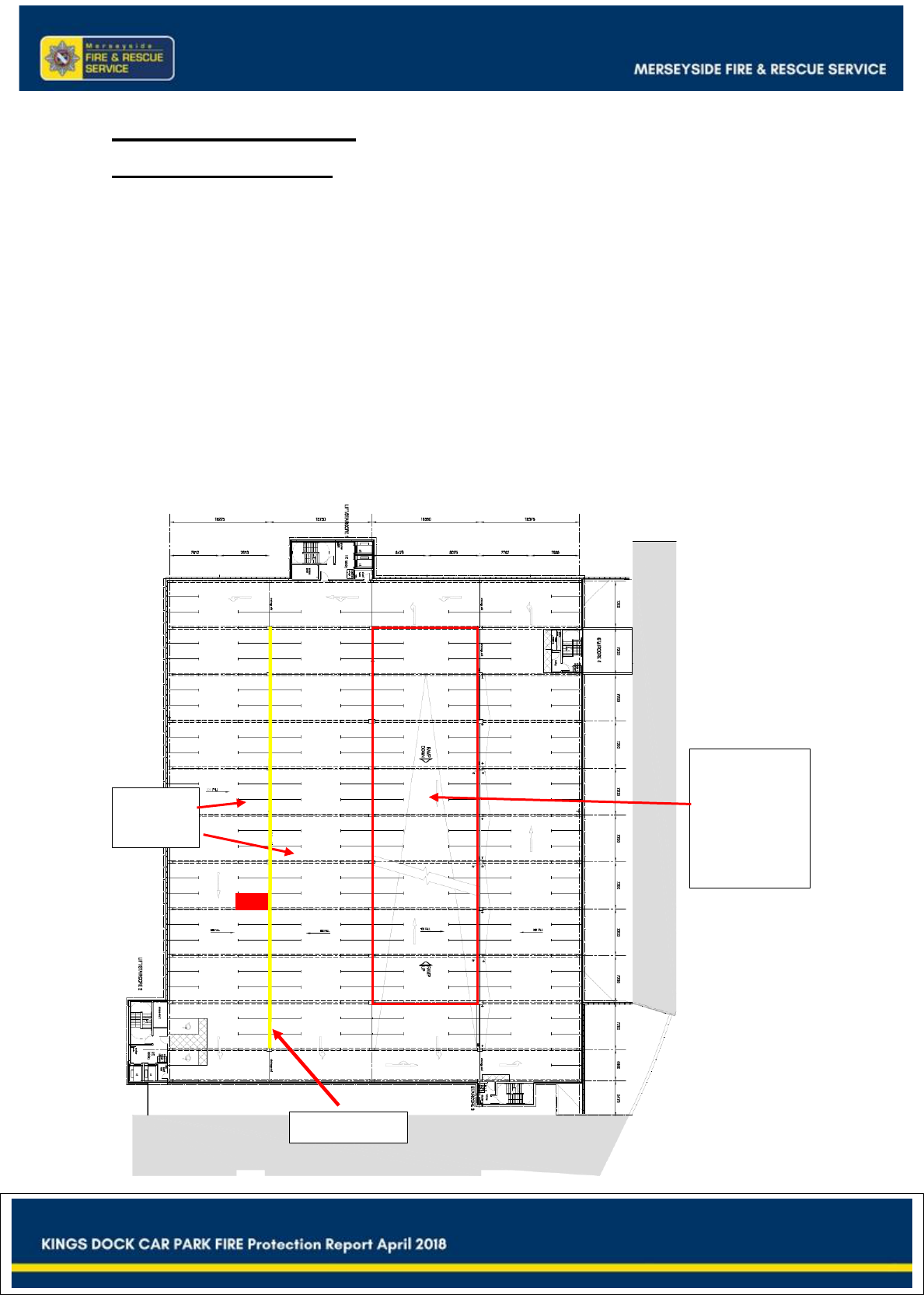
17
2. FIRE SPREAD
2.1 Initial Considerations
Fire Investigation activities began at the Kings Dock Car Park at 18:22hrs on 31
st
December with the attendance of the MF&RS Incident Investigation Team (IIT). Over
the following months MF&RS Protection Department have worked closely with IIT and
various other stakeholders (ACCL, LCC, BRE, Liverpool International Horse Show,
WH Management).
From initial observations, CCTV and open Social Media sources it could be seen that
the fire, once sufficiently developed, moved rapidly up through the structure. Early
thoughts around this concentrated on vehicles being parked on the ramps between
floors as a possible factor in fire spread.
Figure 2.1.1: Level 3-6 floor plan with drainage and ramp system
Ramp area
showing
parking bays
(layout of
floors 3-6)
2
nd
& 3
rd
Rows
Drainage slot
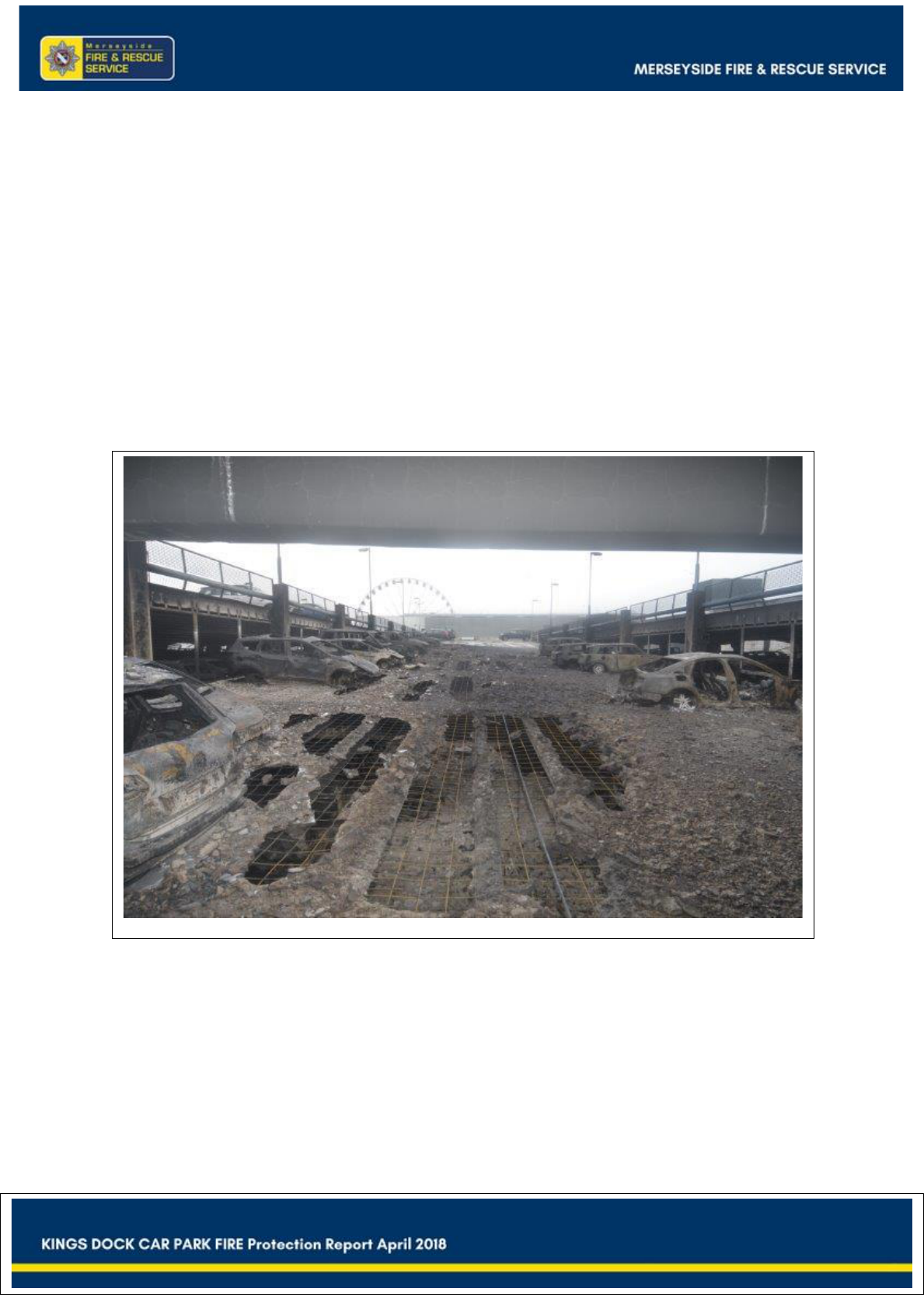
18
Once initial crews and officers were de-briefed it became apparent that the fire, prior
to evacuation and cessation of internal firefighting on Level 3, was surrounded and
confined to the second and third rows of cars. However, the fire had already spread to
Level 4. This, therefore, ruled out the ramps as the initial reason for fire spread
upwards. Although this was, no doubt, a major contributory factor in later fire spread
through the structure, acting as a chimney.
BA teams and external firefighting personnel had reported spalling or exploding
concrete, with BA teams seeing debris falling down from the ceilings on level 3. The
later BA teams also reported holes in the ceiling on level 3 and ignited fuel running
down like a waterfall from the floor above.
Figure 2.1.2: Photograph of ramp from level 6 to level 7
The explosive spalling of the concrete, particularly of the precast ribbed floor slab, may
have provided an additional route for fire development between levels. However, the
fire severity for this event to occur would be well in excess of the fire design resistance
period. The integrity of the concrete and its resistance to spalling will depend on many
factors, such as water content; whether the concrete is reinforced and the aggregate
and materials used.
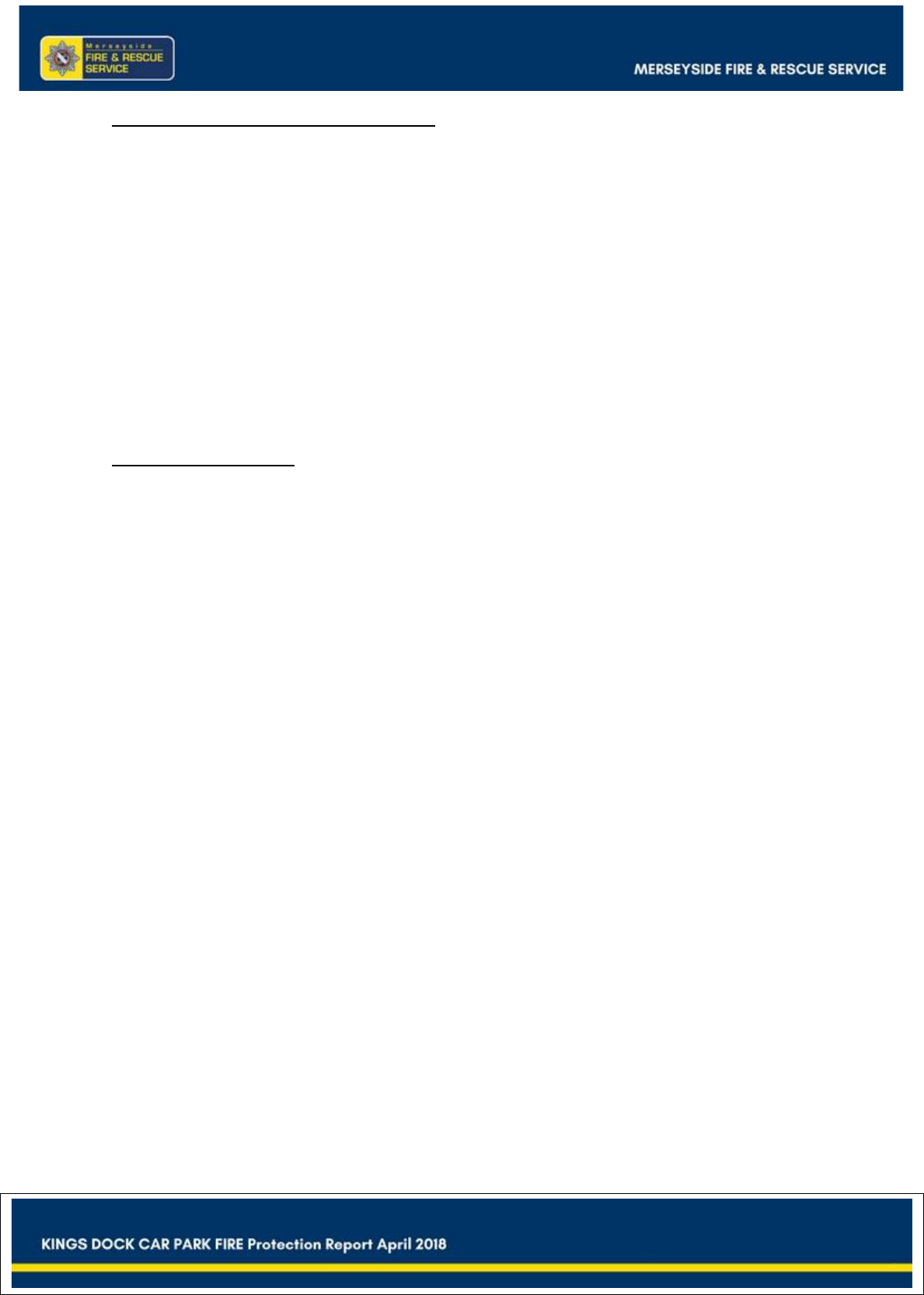
19
Observations and recommendations
1. Rapid spread of fire, once two or more vehicles are fully involved will occur. Fire
will “leap” across empty bays, due to its intensity, in particular the temperature of
the smoke/ceiling jet (BD2552 p.39). In the Kings Dock car park incident crews
reported that additional vehicles became involved “every 30 seconds”. The rate
increased exponentially up to rapid fire development on level 4, just after the crews
withdrew. Sprinklers will delay fire development and prevent fire spread to multiple
vehicles before the attendance of the Fire and Rescue Service.
2. Early firefighting intervention, or automatic suppression is imperative to
controlling fire spread.
2.2 Drainage System
Further investigation by MF&RS Protection has shown that there is a drainage system
built into the car park floor to take away any excess surface water. The drainage
system design varies on different parts of the floor level, i.e. the drains adjacent to the
ramps are designed as grids that run through plastic pipe and into the column, whereas
the drainage system design to the ACCL side of the ramps, adjacent to where the
vehicle of origin was situated, comprises a 15mm wide neck drainage slot that runs
between columns (Figure 2.2.3 p.21). This slot drains into a system of aluminium
trays, attached to the ceiling of the level below and running the length between
columns. These trays empty, at either end, into the concrete support columns via a
plastic drainpipe elbow (Figure 2.2.1 p.20).
This is considered as the likely cause of initial fire spread between level 3 and 4.
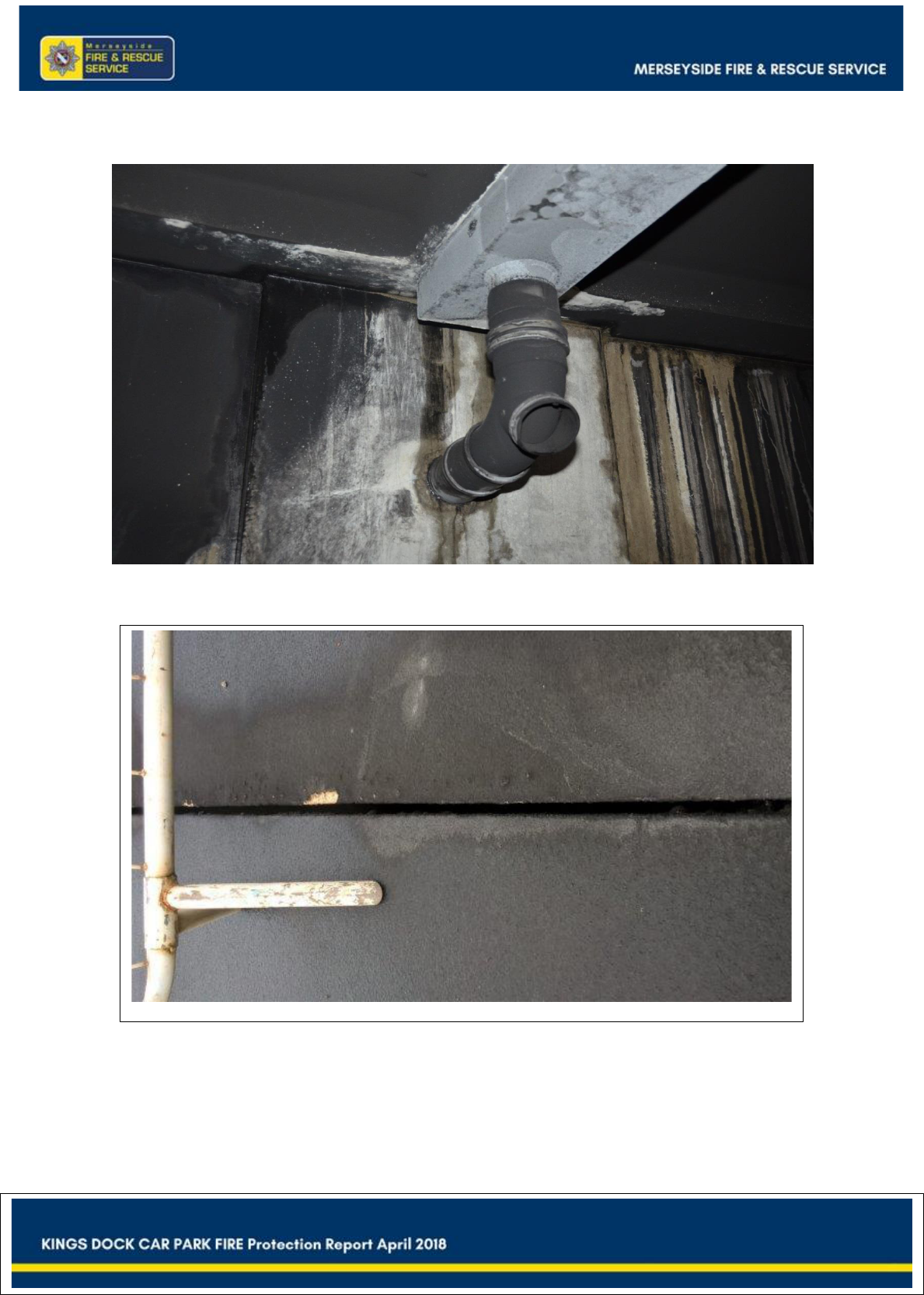
20
Figure 2.2.1: Photograph of intact drainage system type adjacent to vehicle of
origin
Figure 2.2.2: photo view of the drainage slot from above, Level 7 Roof
This drainage slot runs between columns with two rows of three cars parked between
each column (see fig.2.1).
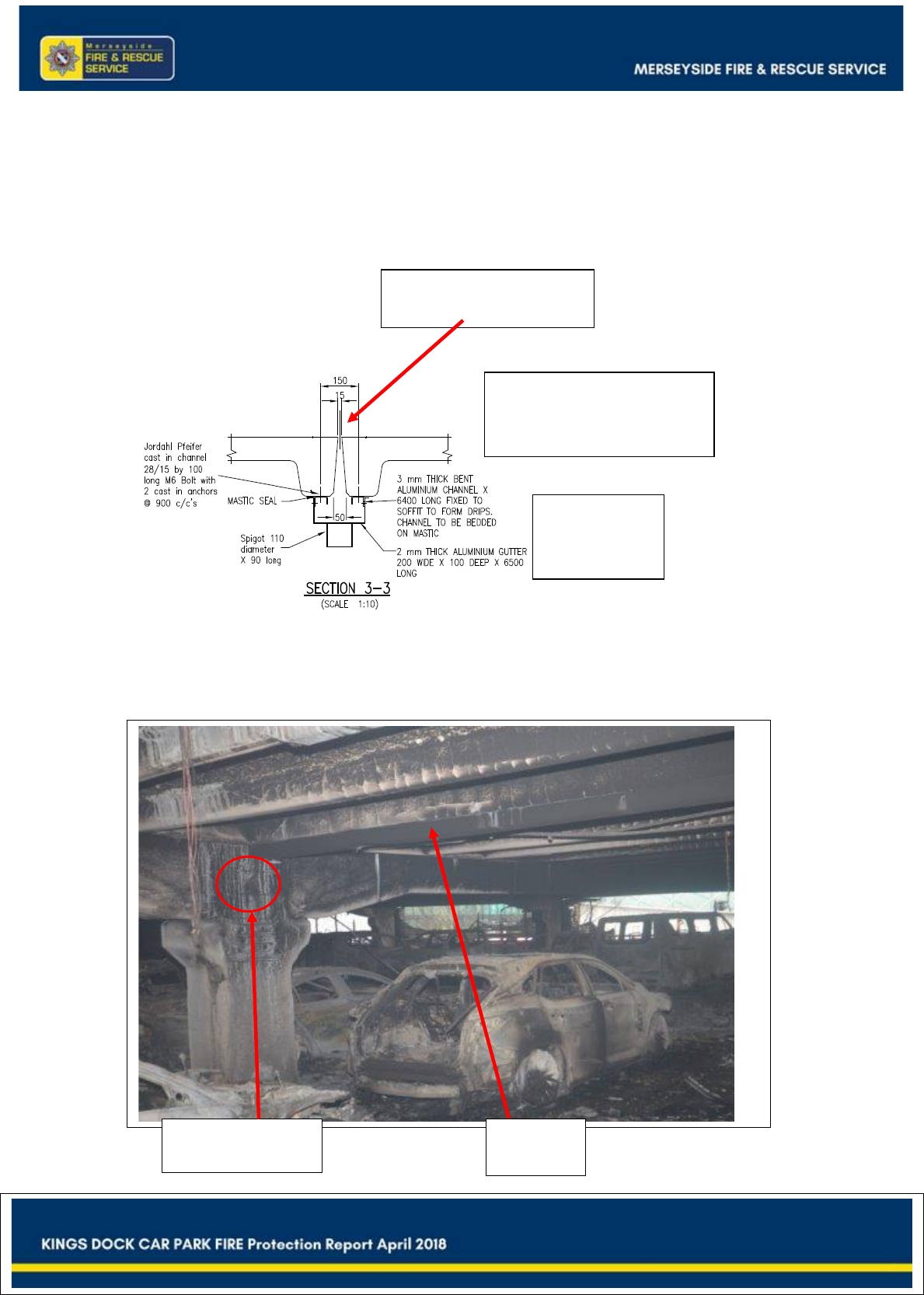
21
Figure 2.2.3: Extract from Level 2 Structural GA drawing 04248/15
Figure 2.2.4: section of aluminium guttering in place.
15 mm wide nominal gap
between precast floor
panels
Longitudinal
aluminium
gutter.
95mm thick pre-cast
concrete floor panels with no
topping.
Plastic drainpipe
elbow burnt away.
Aluminium
guttering
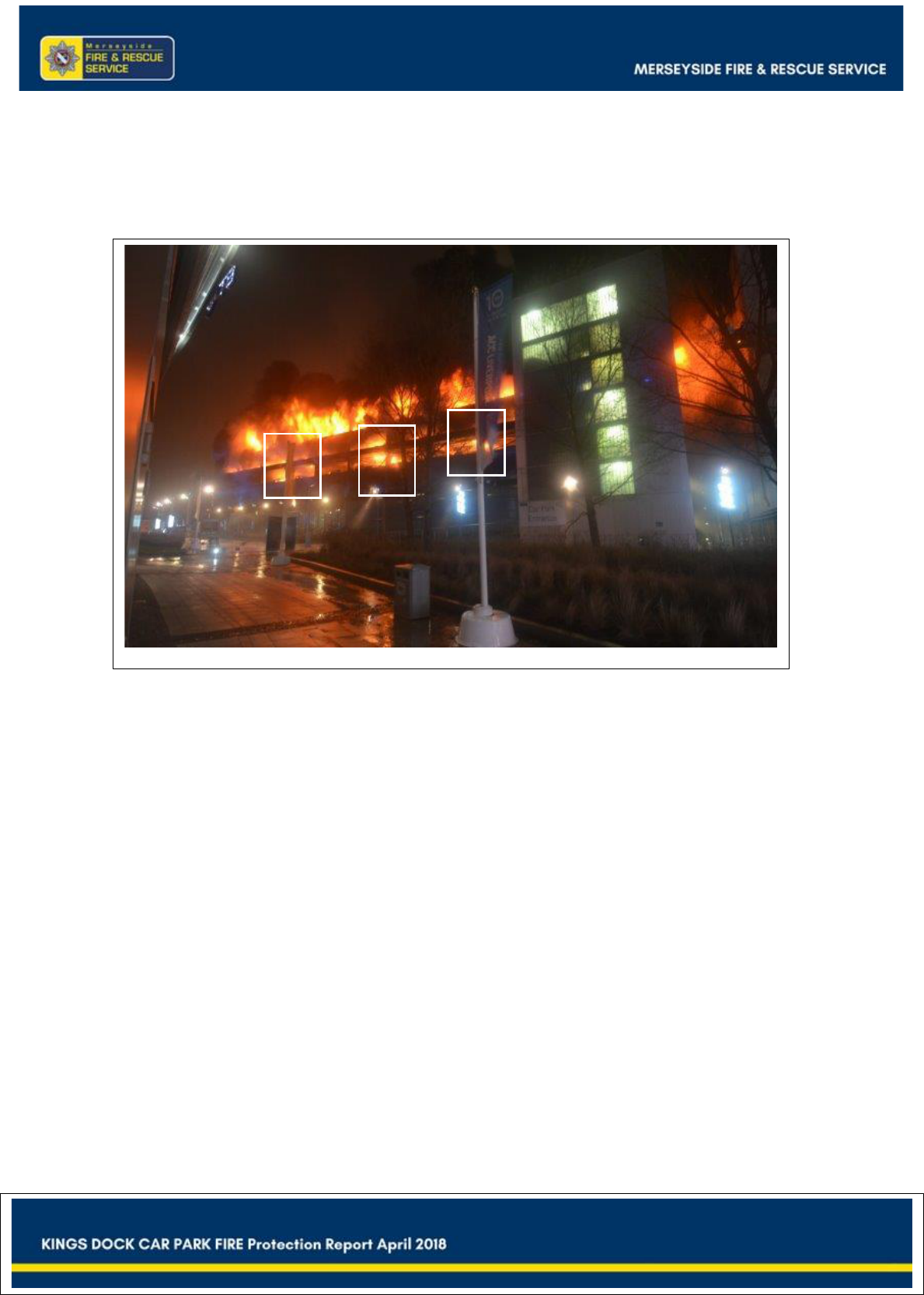
22
The external CCTV image below (fig.2.2.5) appears to show vertical walls of fire at
equidistant positions along the length of the level. This would appear to be further
evidence of drainage failure and the “waterfalls of fire” that BA crews alluded to.
Figure 2.2.5 External CCTV image
With temperatures in excess of 1,200°C, very early failure of plastic elbow pipes would
have occurred and with a melting point of 660°C, the aluminium drainage trays would
also have been subject to failure (see fig.2.2.6) prior to the spalling of the concrete
ribbed floor slabs. Failure of the aluminium tray would expose the drainage channel
and allow hot gases and flame to be directed to the floor above and impinge on the
two rows of cars adjoining this channel.
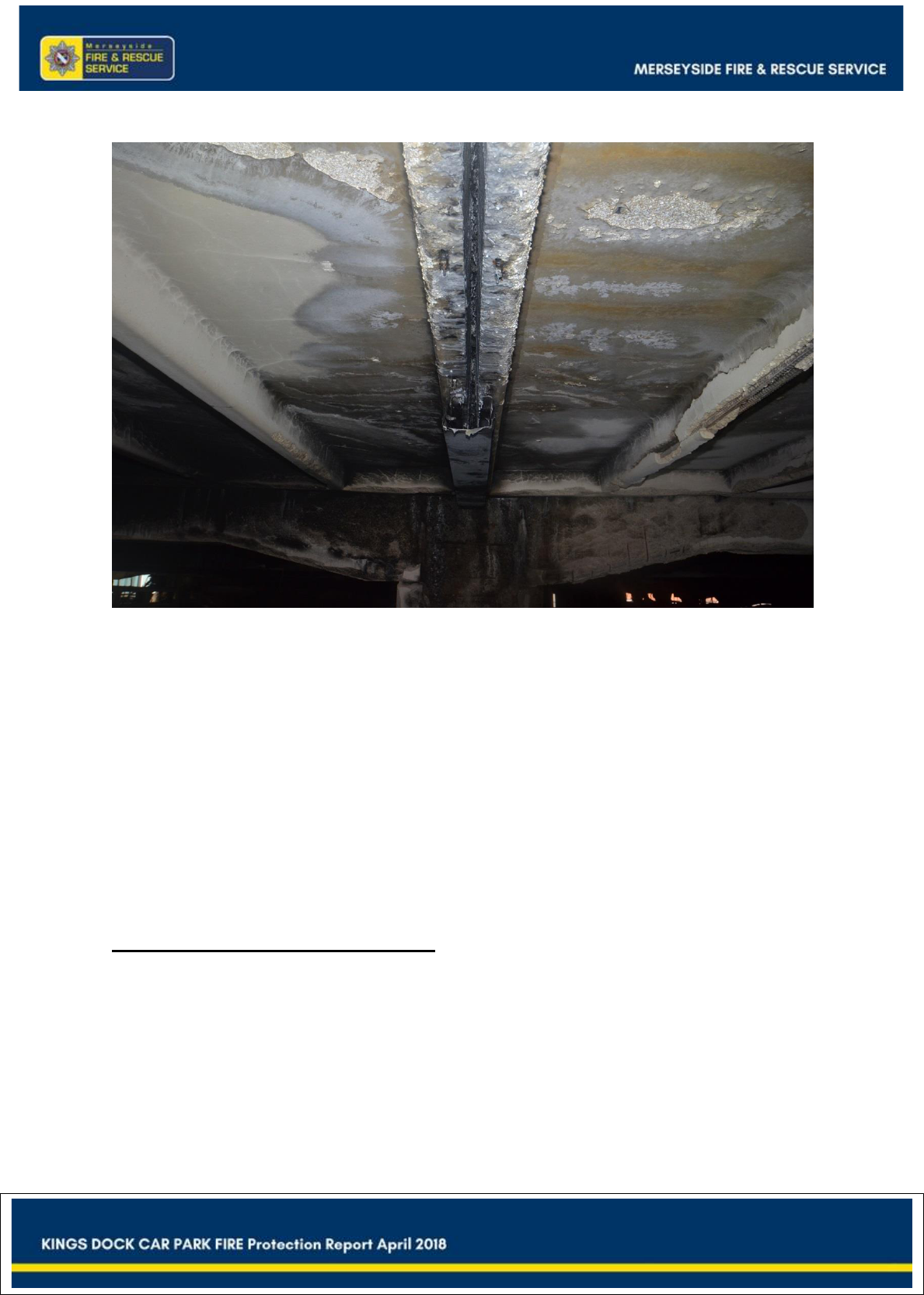
23
Figure 2.2.6: melted aluminium drainage tray and visible drainage slot
A section of undamaged drainage tray from the car park has undergone testing by
BRE. This has confirmed it to be 2mm thick aluminium, which would fail at around
660°C.
MF&RS first attendance was 16:50hrs and internal firefighting commenced on level 3
at 17:08hrs. At 17:35hrs BA crews had reported “waterfall of fire” coming from the
ceiling of level 3 and at 17:40hrs reported 30 vehicles involved in fire.
Observations and recommendations
1. Fire may spread beyond floor of origin. In the case of Kings Dock evidence
would suggest that this was initially through the failure of the drainage system
and was later exacerbated by the failure of the ribbed slab floor. Although the
geometry and central ramp design, combined with running fuel fires, certainly
contributed at a later stage in the incident. Designers should give serious
consideration to the implications of drainage design that could aid fire spread
between levels.
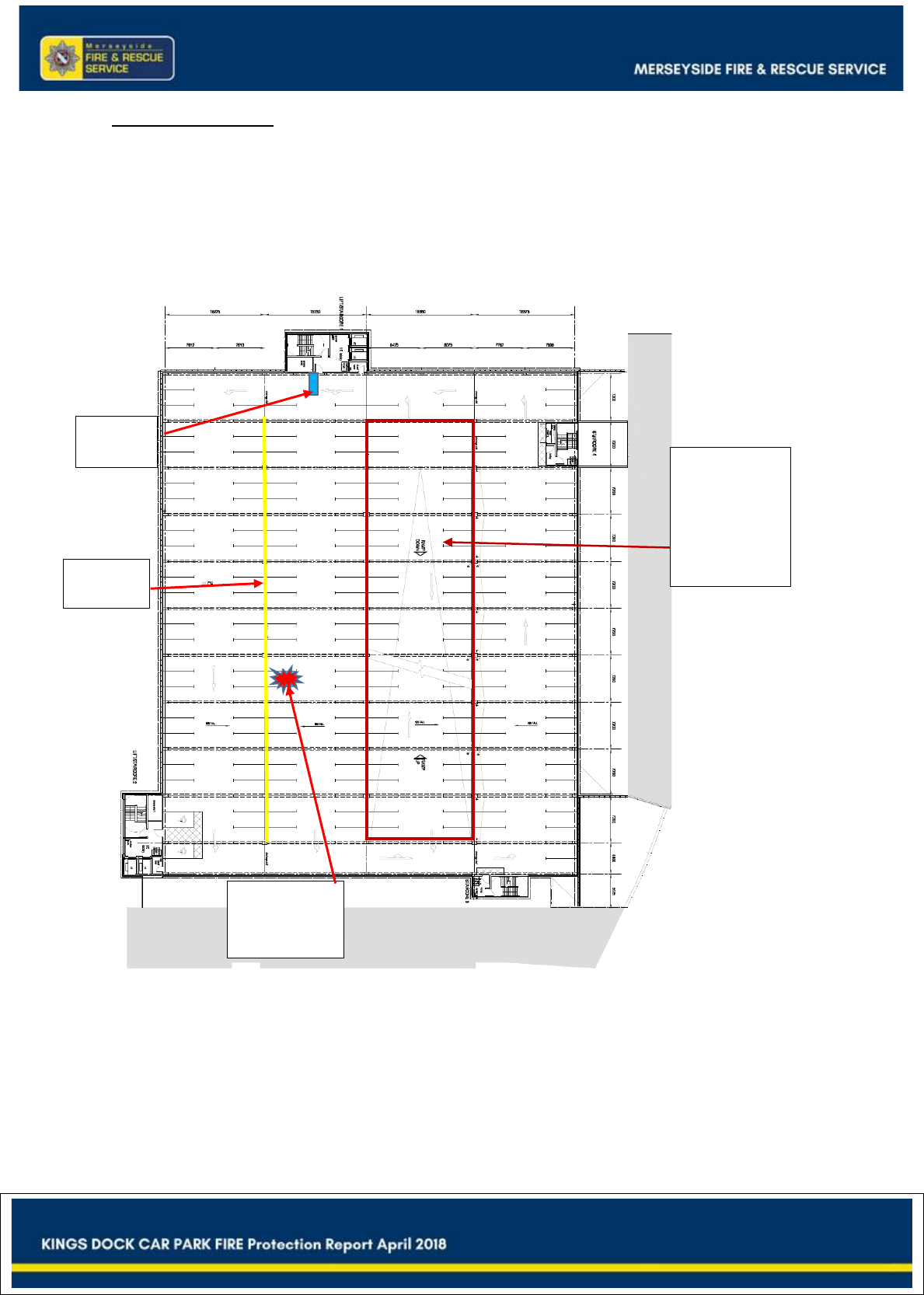
24
2.3 Fire on Level 4
The following plan and images show the first signs of flame captured by CCTV camera
outside stairwell 1, level 4 at 17:53hrs (figure 2.3.2) and then a well-developed fire at
18:11hrs (figure 2.3.3), with several vehicles involved. A major fire event occurred on
level 4 shortly afterwards and fire crews were withdrawn for firefighter safety.
Figure 2.3.1: Level 4 floor plan and position of fire break through
This evidence is further proof that the fire spread occurred through the floor, via the
drainage system, as the flame is practically directly above where the original fire
started. None of the cars adjacent to the ramp are involved in fire at this point. The
images showing fire development on level 4 also mirror, to a great extent, the BRE
experiments conducted between 2006 and 2009, where multiple vehicles become
totally involved in fire in a short period of time, approximately 20 minutes after first
ignition.
Camera
Position
Approximate
position of
flame
Ramp area
showing
parking bays
(layout of
floors 3-6)
Drainage
Slot
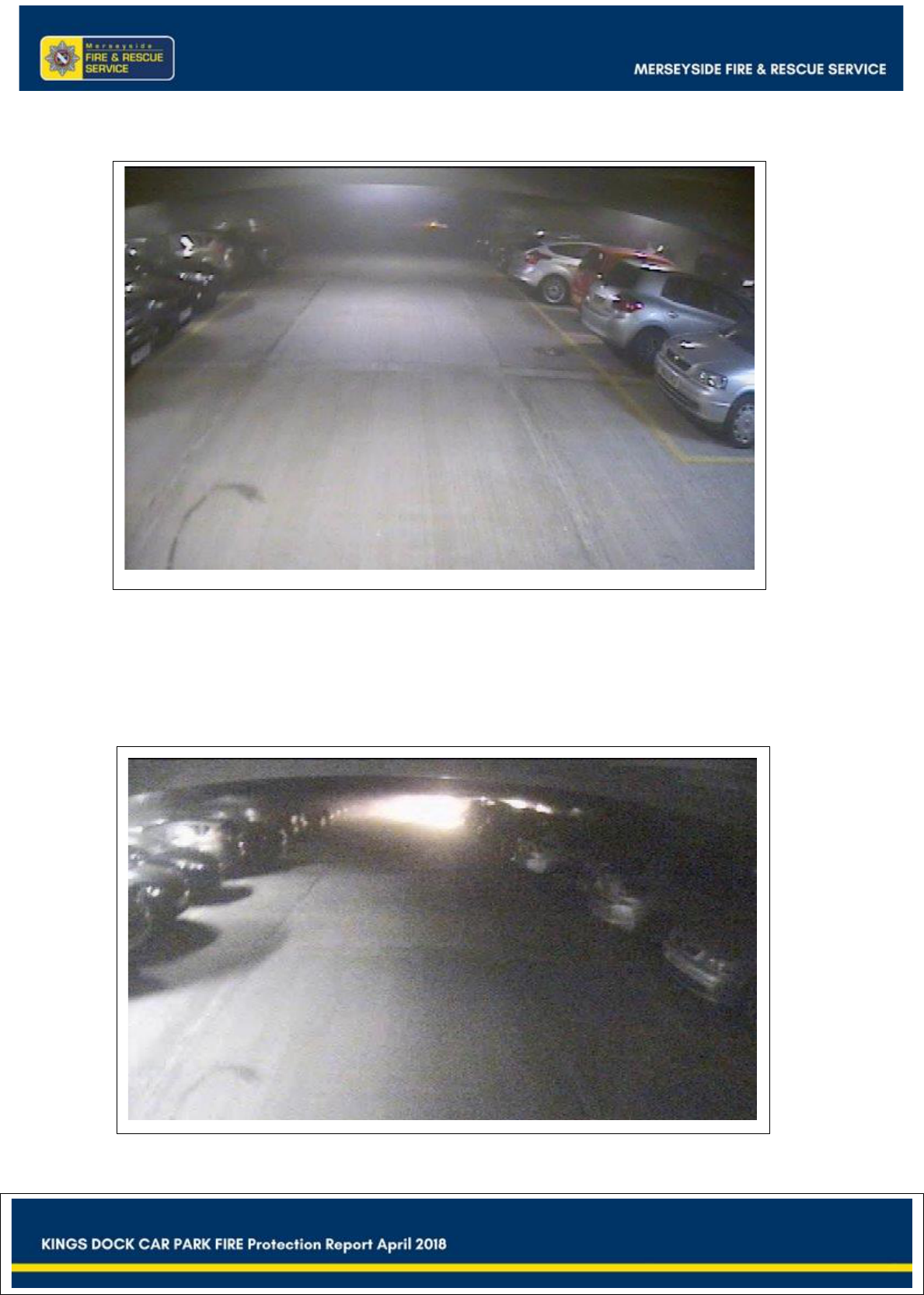
25
Figure 2.3.2: First Sign of Flames on level 4 at 17:53hrs
NB flames may have been present on level 4 earlier than 17:53 but they were
not captured by CCTV due to smoke obscuration. Firefighters on level 3 had
reported “waterfall of fire” at 17:35, when they returned to BA entry control
point.
Figure 2.3.3: Developed fire on level 4 at 18:11hrs
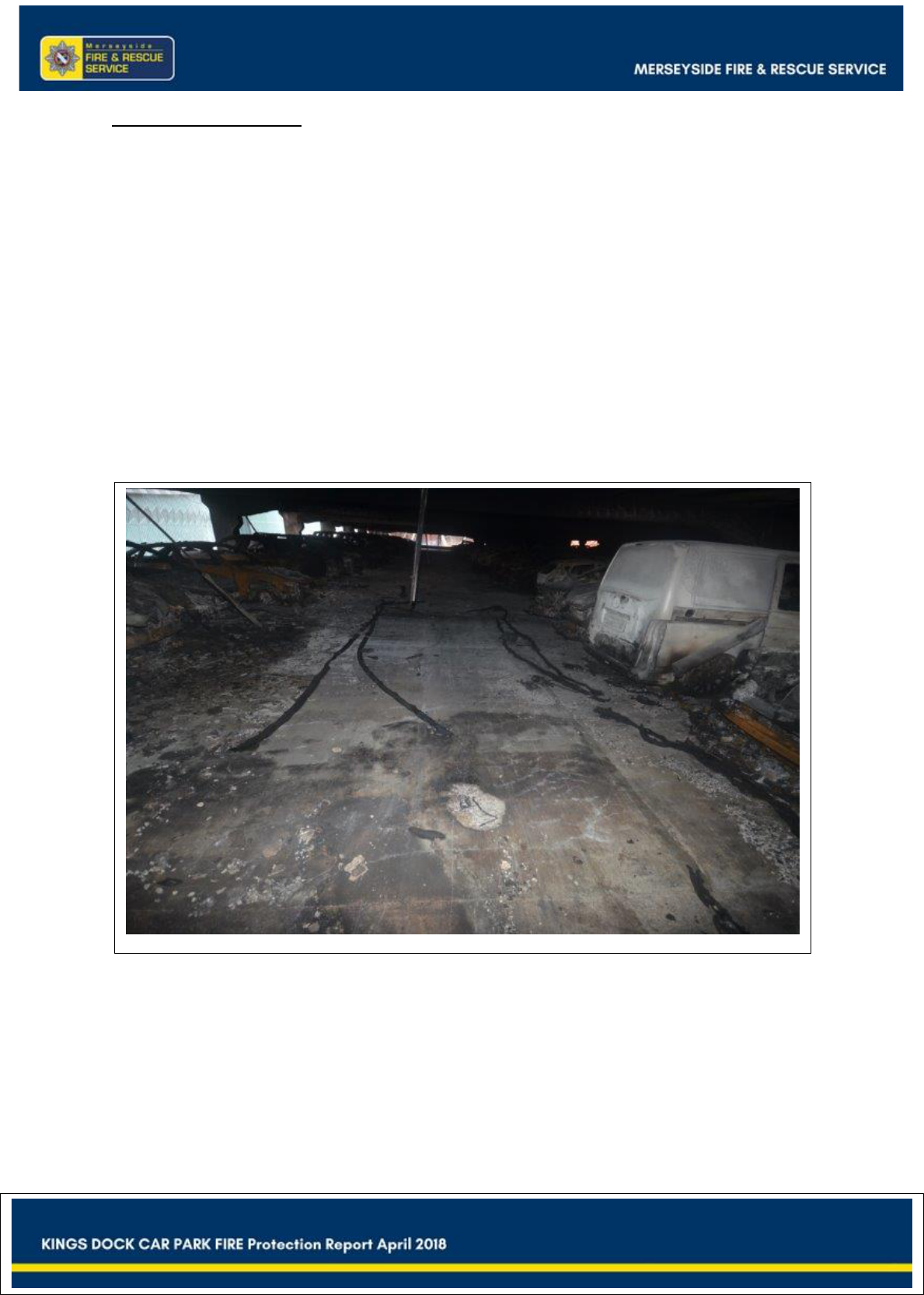
26
2.4 Running fuel fires
Running fuel fires were witnessed by BA crews and this undoubtedly led to fire spread
through the drainage system, down ramps and along the rib slab floor. This was also
highlighted in the BRE experiments conducted between 2006 and 2009:
“Running fuel fires due to failure of plastic fuel tanks in early stages of vehicle
fires can be expected. It is estimated 85% of European vehicles are thought to
have plastic fuel tanks.” (BRE Fire Spread in Car Parks BD2552 p.12).
For two minutes, the tank, fixed as on the vehicle, must be exposed to flame.
There must be no leakage of fuel from the tank” (The United Nations Economic
Commission for Europe (UNECE) Regulation 34, Annex 5, paragraph 5.1).
Areas of the roadways within the car park, sited away from any parked vehicles,
appear to have suffered spalling.
Figure 2.4.1: Photograph of Spalled Concrete: Level 3
The image above appears to show a distinct difference in surface temperature of the
concrete on level 3. The different colouring and the spalling of the floor towards the
bottom of the photograph, combined with the two lines of burnt delivery hose, having
been vaporised beyond the line of colouration change, would appear to support
evidence of very high localised temperatures. In the early stages of the incident, wind
direction was coming north easterly (coming towards the camera view for this
photograph) and firefighters had to withdraw from this area due to the untenable
conditions.
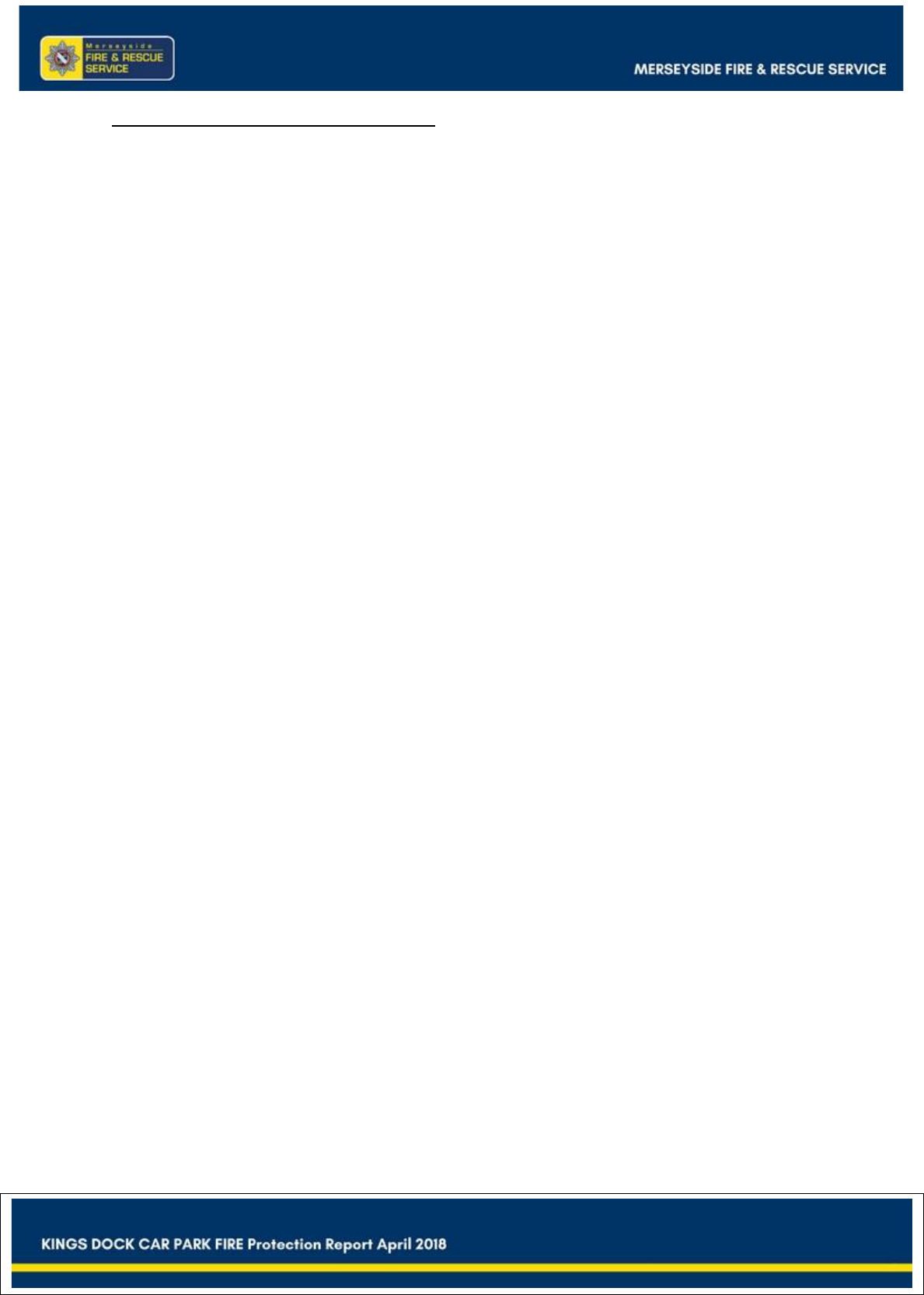
27
Observations and recommendations
1. Running fuel fires will lead to fire spread in car parks. Designers should
consider the likelihood of running fuel fires, when designing floor layouts and
ramping systems that incorporate vehicle parking.
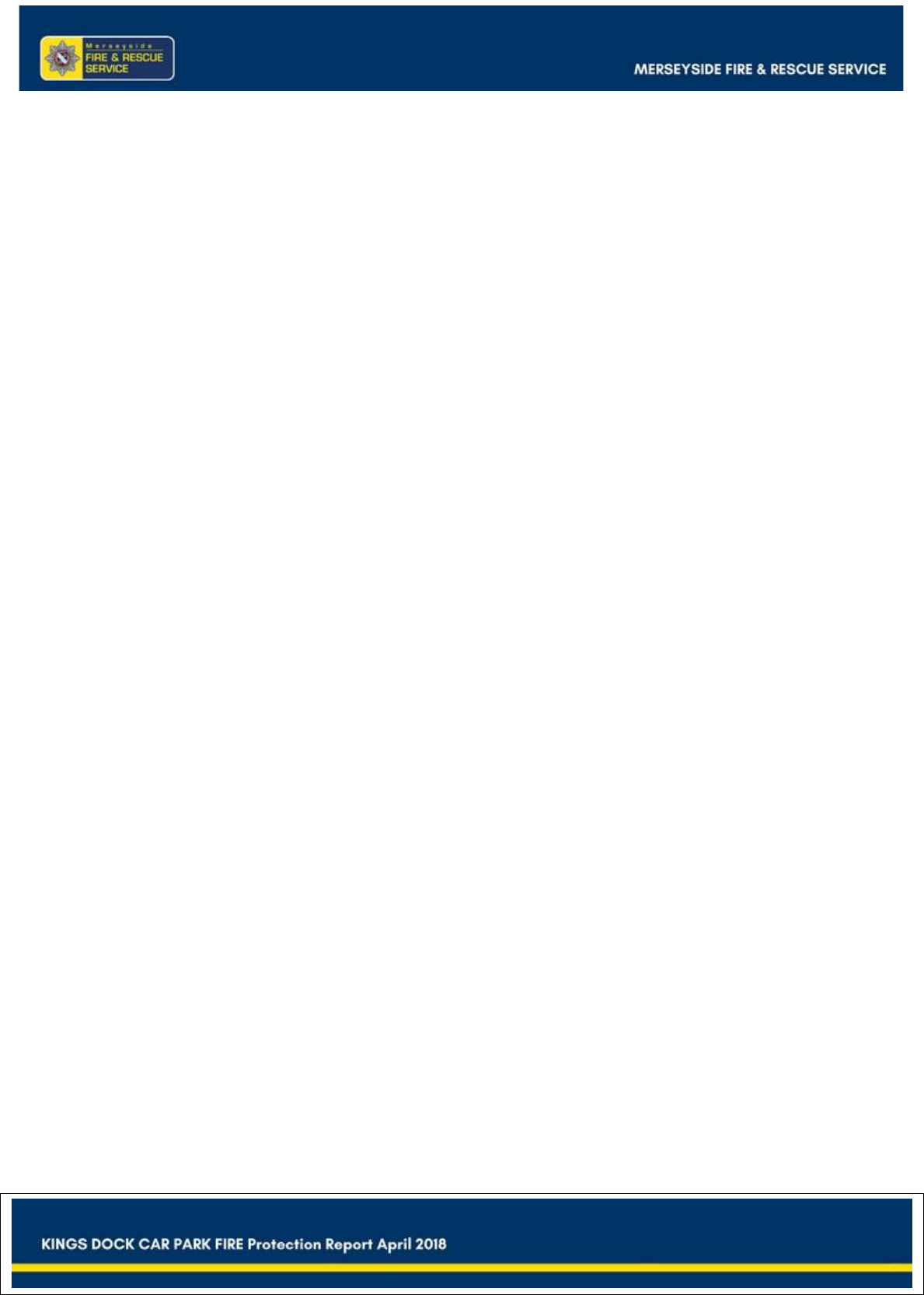
28
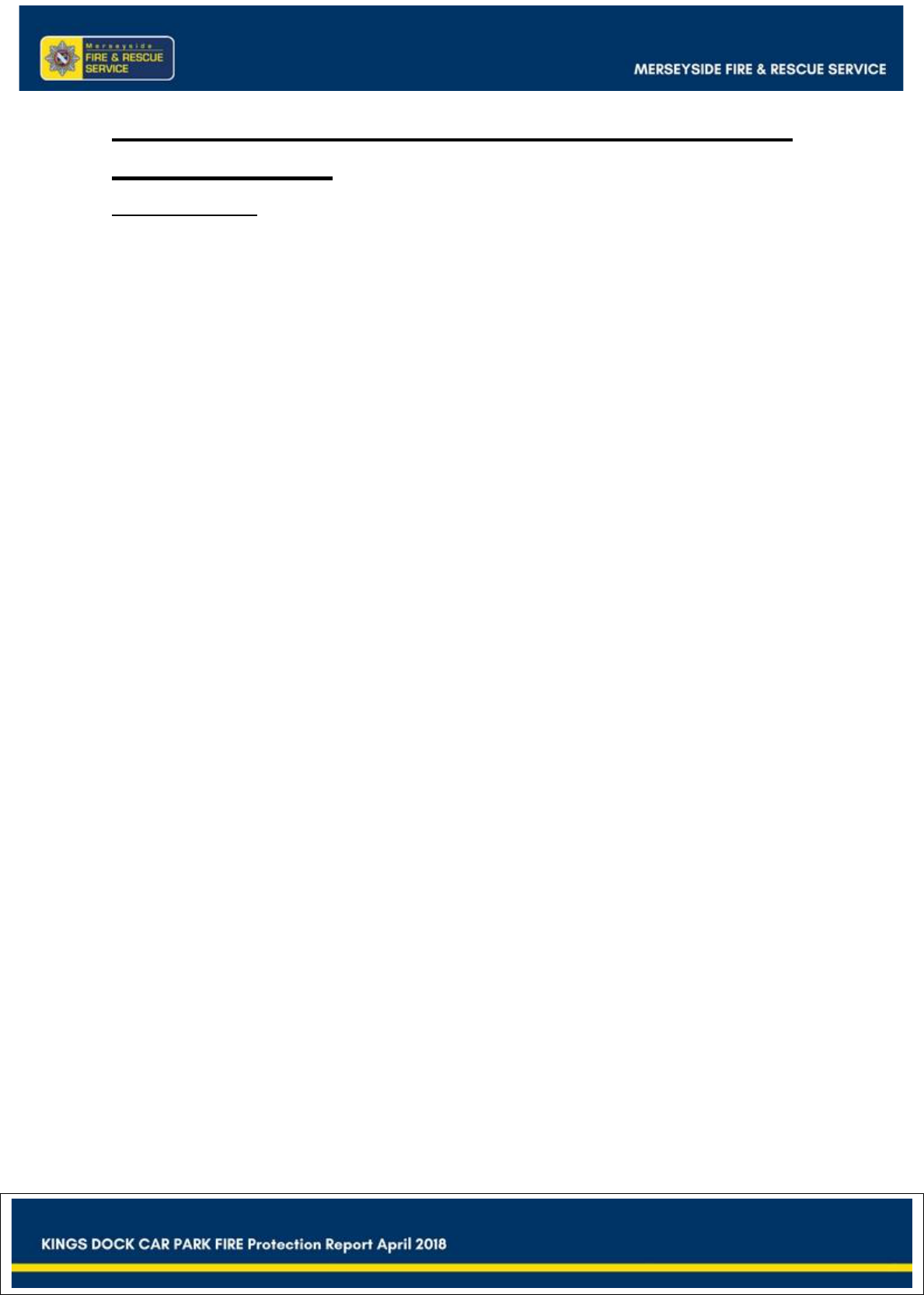
29
3. FIRE PROTECTION AND MANAGEMENT OF
THE BUILDING
3.1 Fire Strategy
There are some complexities regarding the management of the premises, the fire risk
and the fire evacuation strategy within the premises. Following interviews and reports
submitted by the two stakeholders (LCC and ACCL), it has been established that:
On a day to day basis,
The Echo Arena and car park were commissioned and are owned by LCC
ACCL leases the Echo Arena and car park from LCC
LCC staff the car park
LCC is responsible for H&S and fire strategy within the car park; although ACCL
commissioned Omega Fire to complete a fire risk assessment on the building
ACCL are responsible for H&S within the Echo Arena and the service road and
loading bay area, which runs adjacent to the car park and under the
plaza. ACCL is not responsible for H&S on the roads throughout the site, these
are common parts and are managed by CBRE on behalf of Kings Waterfront
Estate Ltd.
During major events and the Liverpool International Horse Show, in particular,
The car park is managed and falls under the responsibility of the LCC staff. As
part of the event, LIHSBE organised for WH Management (an events
management company) to enhance the onsite monitoring; to assist in fire safety
measures for the stables; to deal with car, bin and lorry fires; and to assist in
any emergency evacuation.
ACCL subcontract OCS UK Ltd. to supply stewards, cleaning and security for
Echo Arena, service road and loading bay area, the plaza and the pedestrian
walkways around the site. The stewards should operate in the external venue
areas; e.g. directing vehicles to pick up and drop off points and guiding people
across the roads. There should be no need for ACCL staff/ security to assist in
the car park as LCC should have adequate staff levels required for busy
periods.
In the event of fire, LCC should evacuate the car park and ACCL staff should
help in evacuation, in as much as they form a perimeter to block entry to
members of the public to the car park. There is no formal agreement or
requirement to do this. However, in the event of any emergency situation ACCL
stated that their staff/security would assist a neighbouring organisation where
needed. This would be dynamically assessed as to the level of support
provided.
ACCL, in conjunction with LIHSBE staff & WH Management staff, Online Safety
Solutions (OSS) staff are responsible for H&S, fire strategy for the Arena and
the evacuation of the ground floor given over to stables and the service road
area. WH Management were contracted to manage an evacuation of the
ground floor (stables level). LCC still had overall control of the building and the
LCC staff evacuate public from other floors.
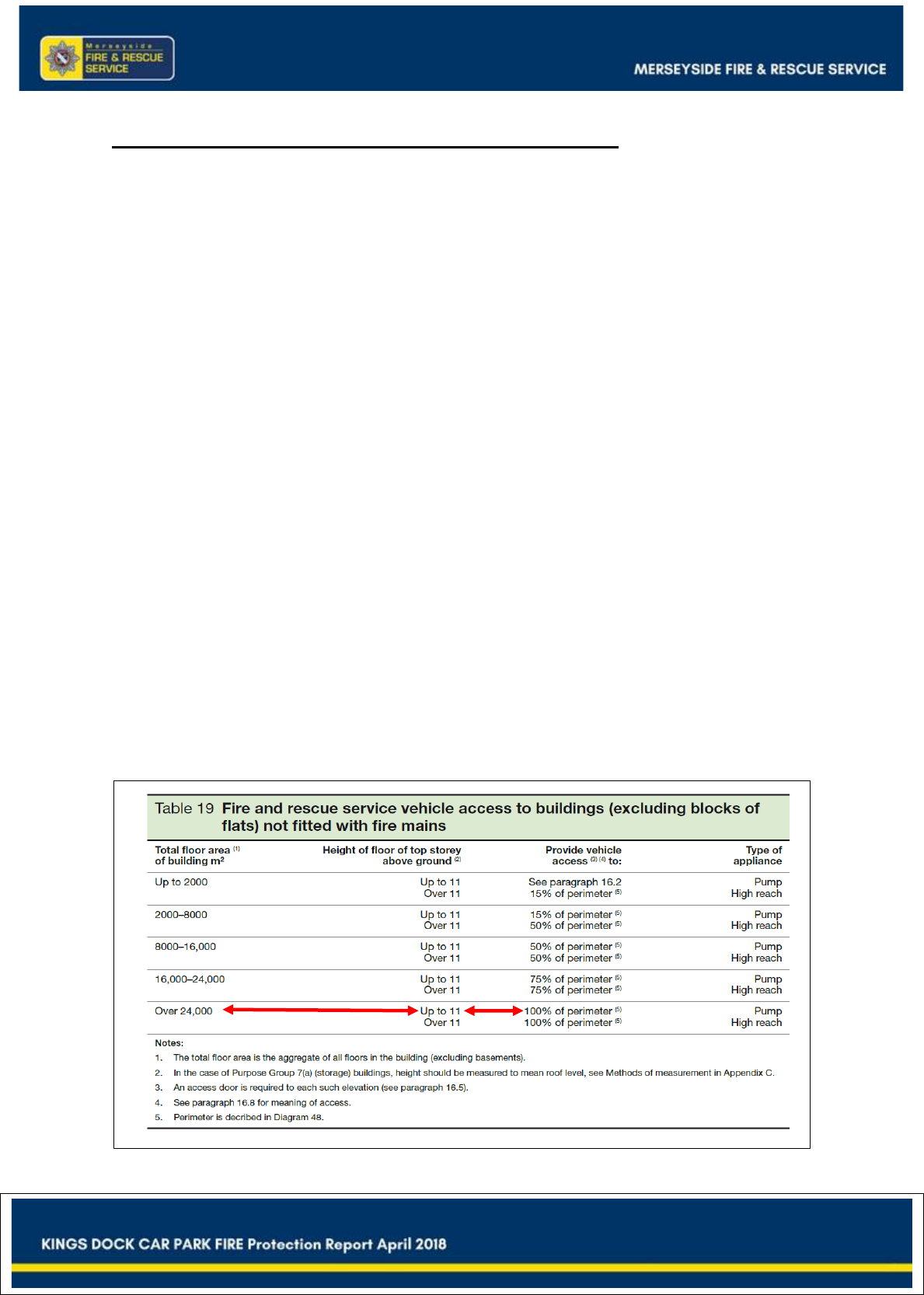
30
3.2. Previous MF&RS Protection Department Involvement
King’s Dock Car Park was an integral element of the King’s Dock Development project,
which was commissioned by LCC in 2004. MF&RS took part in the Building Regulation
consultation process on the car park, which commenced in 2005 and it was agreed in
this consultation process that the car park would be considered a stand-alone building.
MF&RS, Liverpool City Council Local Authority Building Control (LCCLABC), the
architects and the developers took part in this process.
During the process, the design consultants submitted proposals to reduce the width of
staircases, based on the assumption that the occupancy would never fulfil its full
potential due to the transient nature of a typical car park occupancy. MF&RS insisted
on the stair widths remaining at the original submissions (1500mm), due to the fact
that the car park would serve a large event arena and that this would realise a
predictable large peak time activity (before and after shows and events).
The design consultants also submitted that the building did not require firefighting
shafts because it was not 18m in height. MF&RS countered this submission, stating
that: “…although the building was less than 18m, it did not comply with Table 19 in
ADB….The gross floor combined area exceeds 24,000m² and consequently requires
100% perimeter access for pumping appliances and high rise appliances. The future
apartments, when constructed, will restrict 50% of the access area, consequently
reducing our access to 50% of the building. As a result the firefighting shafts become
a necessity and a requirement.” As a result of MF&RS submissions, it was agreed that
firefighting shafts would be installed within the building with a minimum1500mm
staircase. The building was constructed to this standard and opened in November
2007.
Figure 3.2.1: Table 19 ADB Volume 2
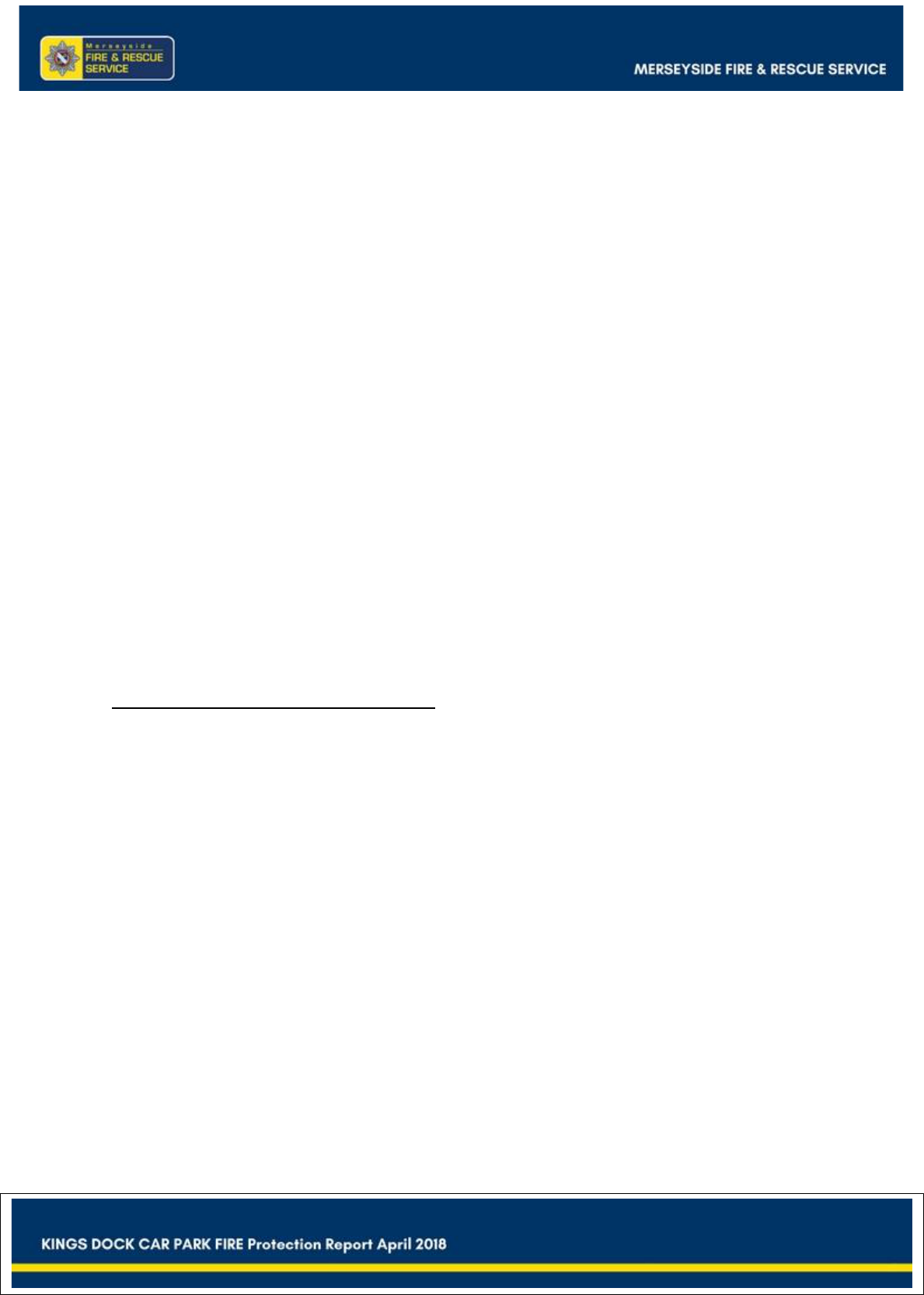
31
On 2
nd
November 2012 and on 2
nd
December 2015, MF&RS Fire Safety Inspectors
audited the premises under the Regulatory Reform (fire safety) Order 2005 (RR(FS)O
2005). On both occasions the outcome was broadly compliant and a medium risk level
was determined. Under the MF&RS Risk Based Inspection Strategy, this would mean
that the building would not require a further audit for a further 36 months. Following
the 2012 audit, Liverpool Protection Department North wrote to the responsible
person, stating: “Temporary hoardings that have been positioned to the ground floor
may have considerably reduced the cross ventilation facility provided to this open-
sided car park. This may impact on firefighting access and firefighter safety.” (See
section 4. Natural Ventilation).
Due to the complex and diverse nature of the events that are held at ACCL and the
inherent changes in fire strategies associated with these complexities, MF&RS had
served ACCL with an Alterations Notice in 2008 (see Appendix 2)
This was in no way a punitive action by MF&RS and should not be viewed as such.
This action was taken due to the diversity of shows, events and conferences that are
held at ACCL. With this in mind, MF&RS were informed of the proposed change in
strategy for the inaugural Liverpool International Horse Show in December 2016.
Liverpool Protection Department North wrote a comprehensive note for case on the
arrangements which involved the car park and ACCL itself. Liverpool Protection
Department North submitted Operational Action Information Note (Ref. 11E/00306) to
the Operational Planning Department and this information was disseminated to
operational crews on a Public Events Briefing Note.
Observations and recommendations
1. MF&RS were appropriately consulted in the construction of this car park and
were able to contribute effectively to ensure public and firefighter safety. This
demonstrates the importance of good consultation between developers and the
Fire and Rescue Service in ensuring that appropriate safety measures are
implemented.
2. The close proximity of the serviced apartments to the southern and eastern
elevations of the car park meant that aerial appliance access was very limited
and firefighters faced extremely difficult conditions in order to save these
buildings from fire. Designers and approved inspectors should give due regard
to firefighter safety when considering design requirements of their buildings.
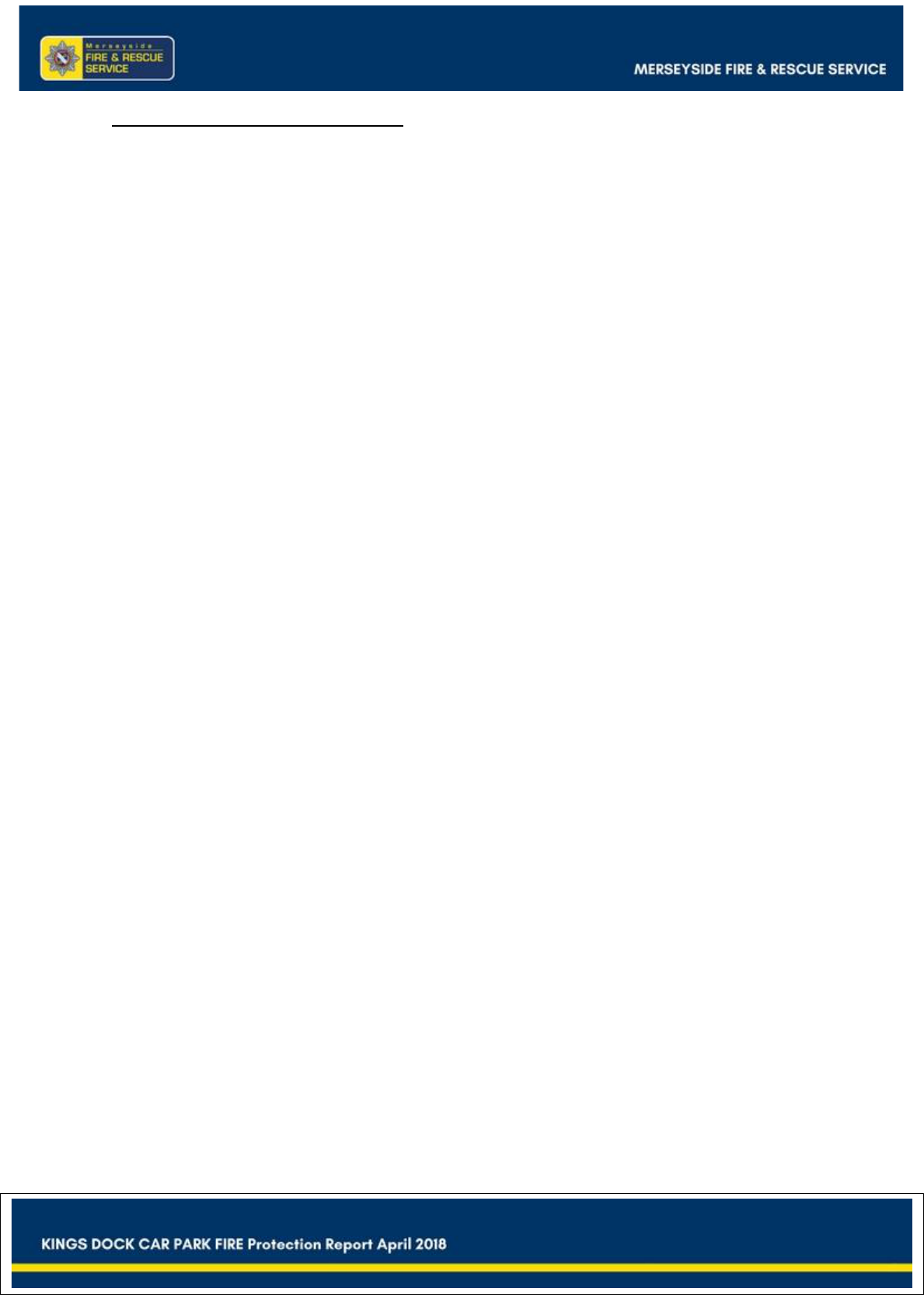
32
3.3 Fire Risk Assessments (FRA)
Kings Dock Car Park has 4 separate fire risk assessments completed on it by different
stakeholders, two of which are for the day to day running of the car park and two are
for the car park during the Liverpool International Horse Show. These are:
LCC produced a FRA, specifically for the day to day running of the car park,
dated 30
th
June 2017. It does not identify any non-compliance issues.
ACCL commissioned Omega Fire to carry out a FRA, specifically for the day to
day running of the car park, dated 9
th
February 2017. This was a
comprehensive and detailed FRA, identifying several minor deficiencies.
ACCL commissioned Omega Fire to carry out a FRA for all areas of the King’s
Dock Development given over to the Liverpool International Horse Show,
including the Arena, ground floor of the car park, the pontoon and the service
tunnel/loading bay. This was a comprehensive and detailed document,
identifying hazards and risks and a fire strategy for the event.
LIHSBE commissioned WH Management to manage certain aspects of the
event, including a fire evacuation strategy, basic firefighting and a 24hr fire
watch. WH Management commissioned Online Safety Solutions (OSS) to
provide a FRA for the event, for all areas of the King’s Dock Development during
the Liverpool International Horse Show, including the Arena ground floor of the
car park, the pontoon and the service tunnel. This was a comprehensive and
detailed document, identifying hazards and risks and a fire strategy for the
event.
RR(FS)O 2005, Article 9 states: “The responsible person must make a suitable and
sufficient assessment of the risks to which relevant persons are exposed for the
purpose of identifying the general fire precautions he needs to take to comply….under
this order.”
and
RR(FS)O, 2005, Article 22(1) states: “Where two or more responsible persons share,
or have duties in respect of, premises (whether on a temporary or permanent basis)
must –
a) Co-operate with the other responsible person…to comply with….this Order.
b) (taking into account the nature of his activities)…to co-ordinate the measures
he takes to comply with… this Order with the measures the other responsible
persons are taking to comply with…this Order.
c) Take all reasonable steps to inform the other responsible persons concerned
of the risks to relevant persons…
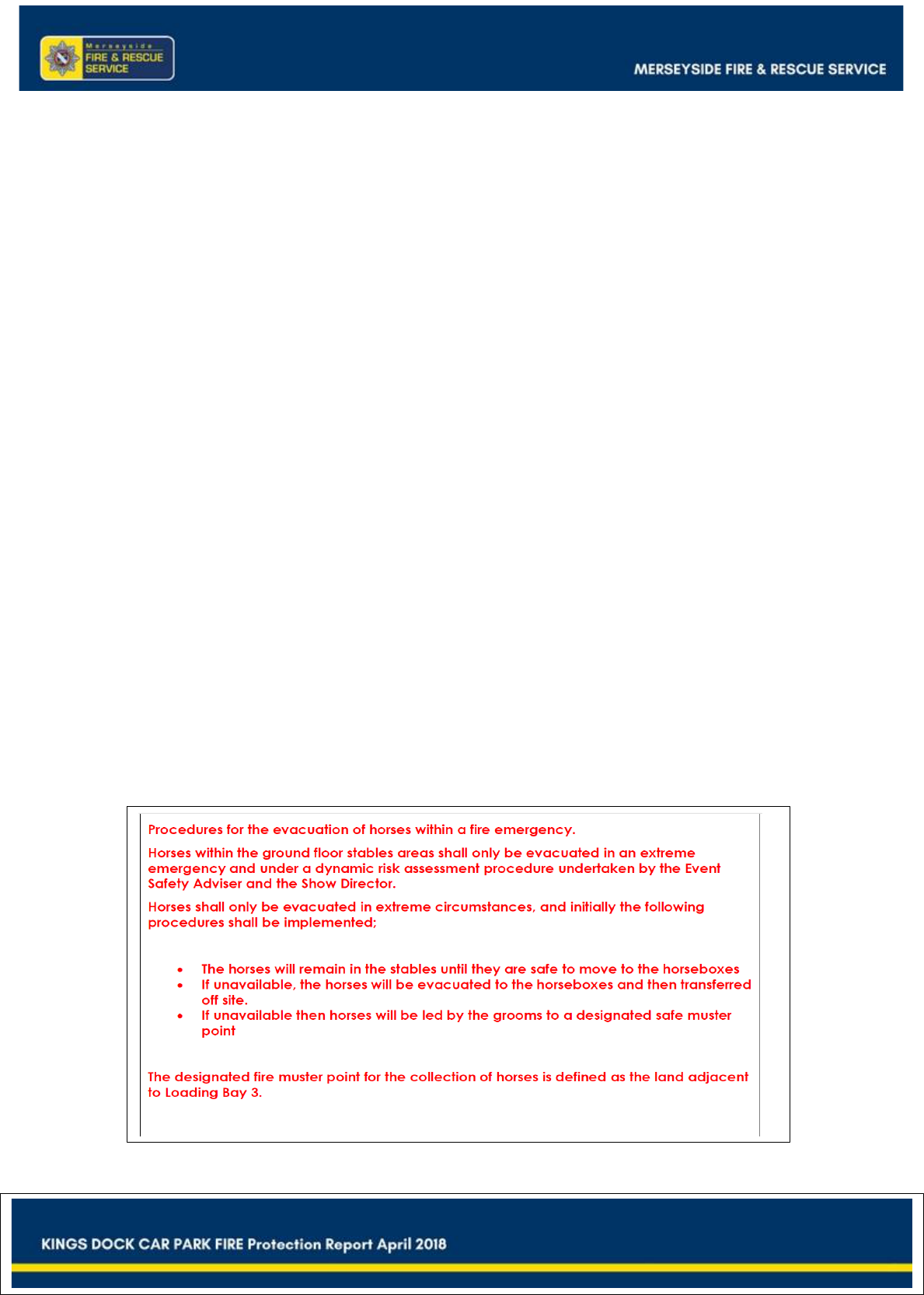
33
A suitable and sufficient FRA is an analysis of hazards and associated risk within a
premises. Having more than one can potentially complicate matters. Such
arrangements may make it difficult for the responsible person(s) to determine which
FRA is the most comprehensive and the most appropriate to adopt. Also, where part
of the building has essentially undergone a change of use, has increased in risk and
is under the control, to some extent, of another responsible person, there should be a
tacit understanding of roles and responsibilities of all employees in case of fire.
It should be noted that the FRAs and fire strategies for the event were detailed and
comprehensive. Co-operation and co-ordination between the responsible persons
were fairly robust, with pre-event planning and table top exercises taking place prior
to the event. This preplanning extended to an emergency planning meeting and one
of the scenarios was how to deal with fire in the stables.
During the incident, the evacuation of people from the car park was prioritised and a
co-ordinated plan (see Figure 3.3.1) was in place to evacuate the horses. This plan
took into account the potential risk to people, if the horses were to be evacuated at the
same time. The impact on emergency service response and activities should also be
considered. On actuation of the fire alarm, the system is interfaced to ACCL and has
the effect of closing the entry barriers and opening the exit barriers of the car park.
This design feature is to stop vehicle access to and enable vehicle egress from a
potential fire. However, the disciplined evacuation of the horses via the front entrance
to the car park could have been jeopardised by interventions of worried members of
the public applying pressure to employees, who, in turn may not have been aware of
the strategic decisions around the co-ordinated and controlled evacuation plan.
Figure 3.3.1: extract from OSS Event FRA
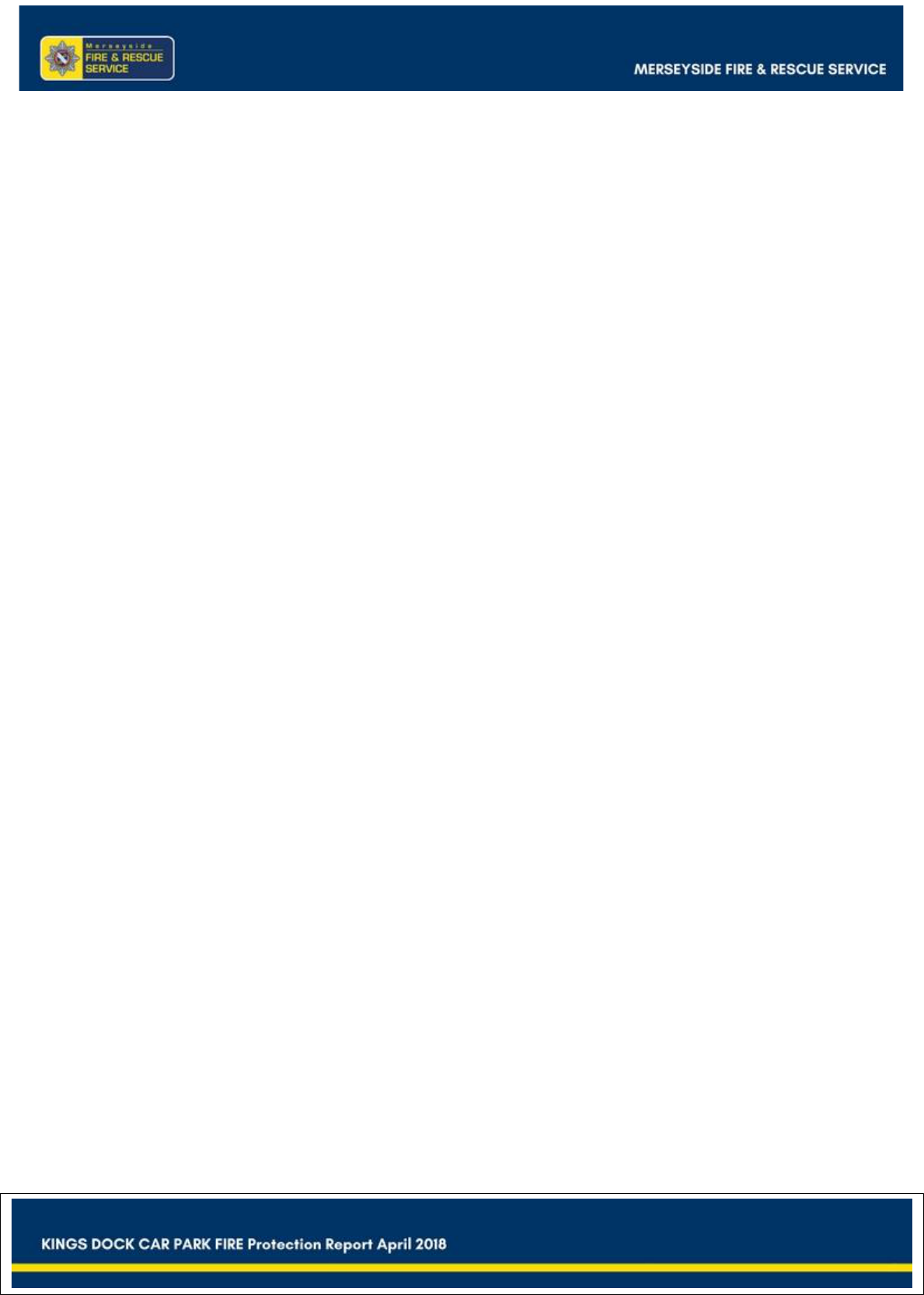
34
CCTV footage indicates that there may not have been strict adherence to the
delineation of roles and responsibilities outlined in the different FRAs and fire strategy
documents. It clearly shows staff from OCS and LISHBE accessing areas that fell
under the responsibility of LCC. It must be noted, however, that their presence and
actions did contribute to the safe evacuation of levels 1 to 7
LCC staff priorities were, once the evacuation of people from levels 1 to 7 had been
completed, to prevent vehicular and pedestrian access to the car park (under the fire
strategies, they were to be aided by ACCL staff with this task).
On actuation of the fire alarm the exit barriers open, to allow vehicular egress and the
entrance barriers close to prevent vehicular access. One of the predetermined escape
routes for the horses was via the entry barriers on the ground floor.
This situation, combined with considerable pressure from worried horse owners, had
the potential to lead to an uncontrolled evacuation of horses into oncoming fire
appliances and adversely affect firefighting operations.
Although tensions were raised at this critical time, LCC and ACCL and LIHSBE staff
managed a well-controlled and co-ordinated evacuation of the horses, as per the pre-
planning.
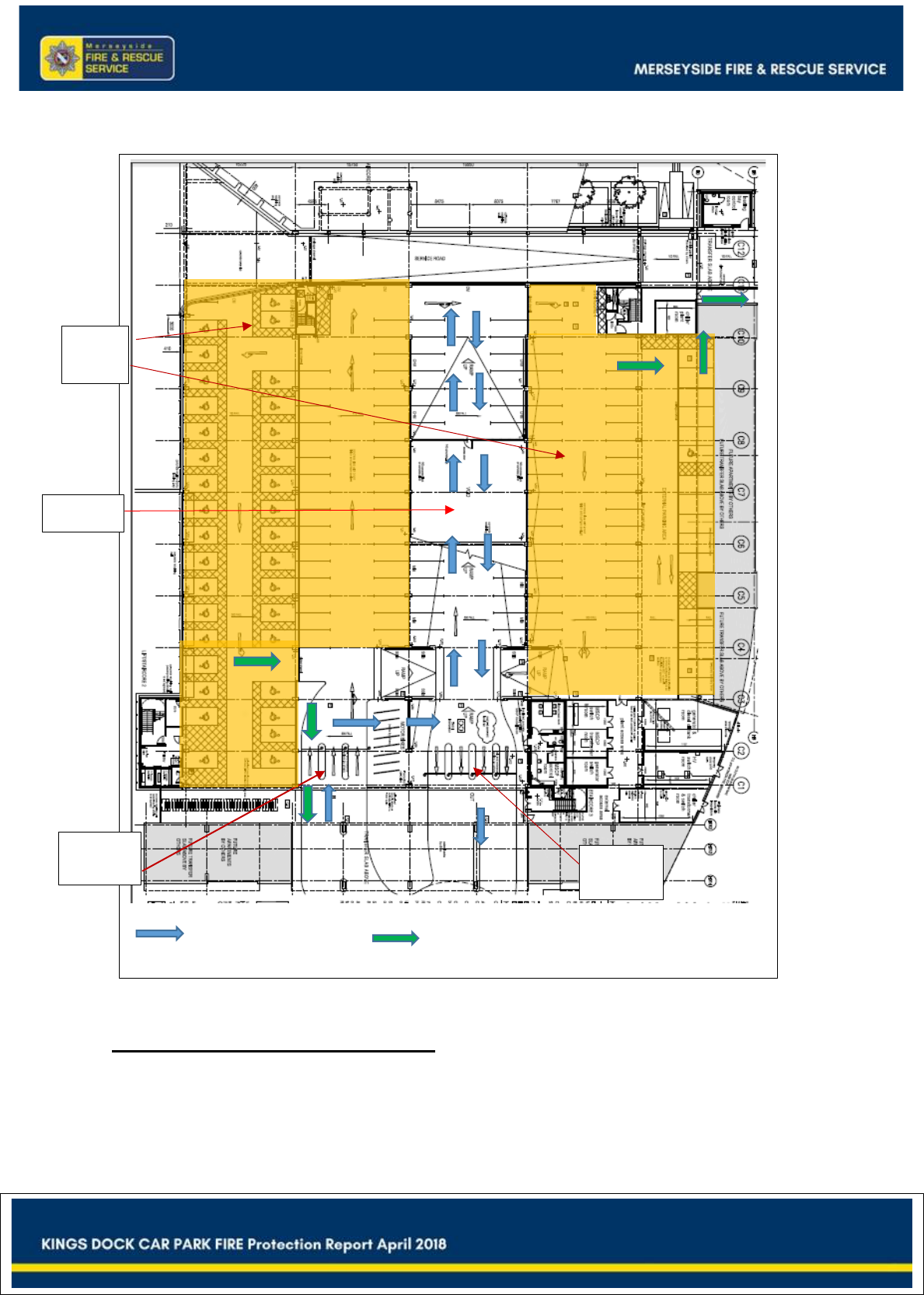
35
Figure 3.3.2: Ground Level floor plan
Observations and recommendations
1. LCC should review all fire risk assessments for their car parks
2. Although not a contributory factor during this incident, careful consideration
should be given to using car parks for purposes other than the parking of
vehicles, in future.
Entry
Barriers
Exit
Barriers
Stable
Areas
Service tunnel road
Vehicle entry and
exit routes
Ramp
Horse escape exits
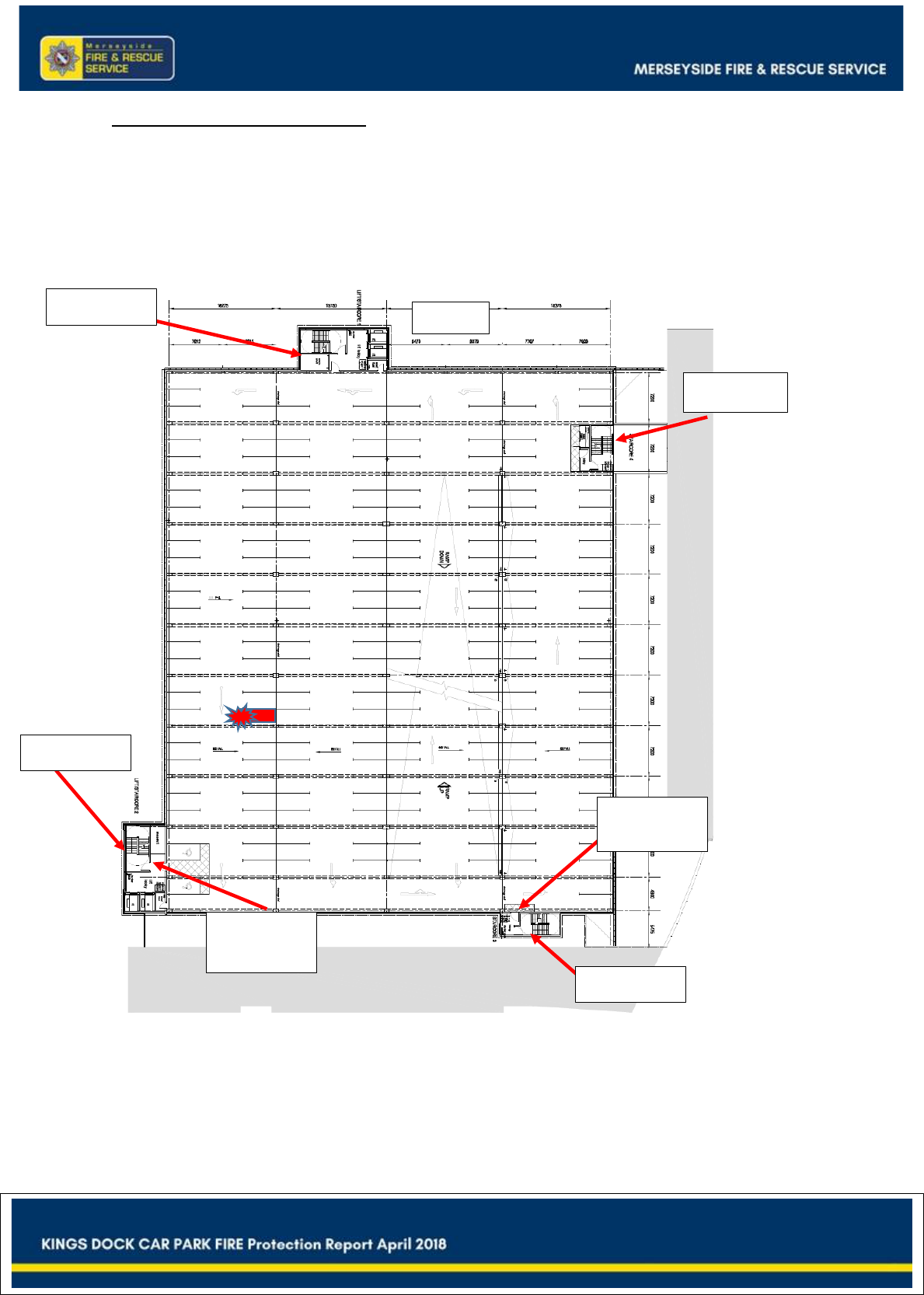
36
3.4 Fire Protection Measures
The car park is served by a combination of a manual and an automatic fire alarm
system, complying with BS5839-1. There are manual call points on all levels of the car
park, adjacent to protected stairwell exits.
Figure 3.4.1: Level 3 floor plan
The fire alarm was first actuated at 16:43:49, alarm panel indicating call point 64, level
3, adjacent to escape stairwell 3.
Level 3
Stairwell 3
Stairwell 4
Stairwell 1
Stairwell 2
1
st
Call point
actuated
Multi sensor
56
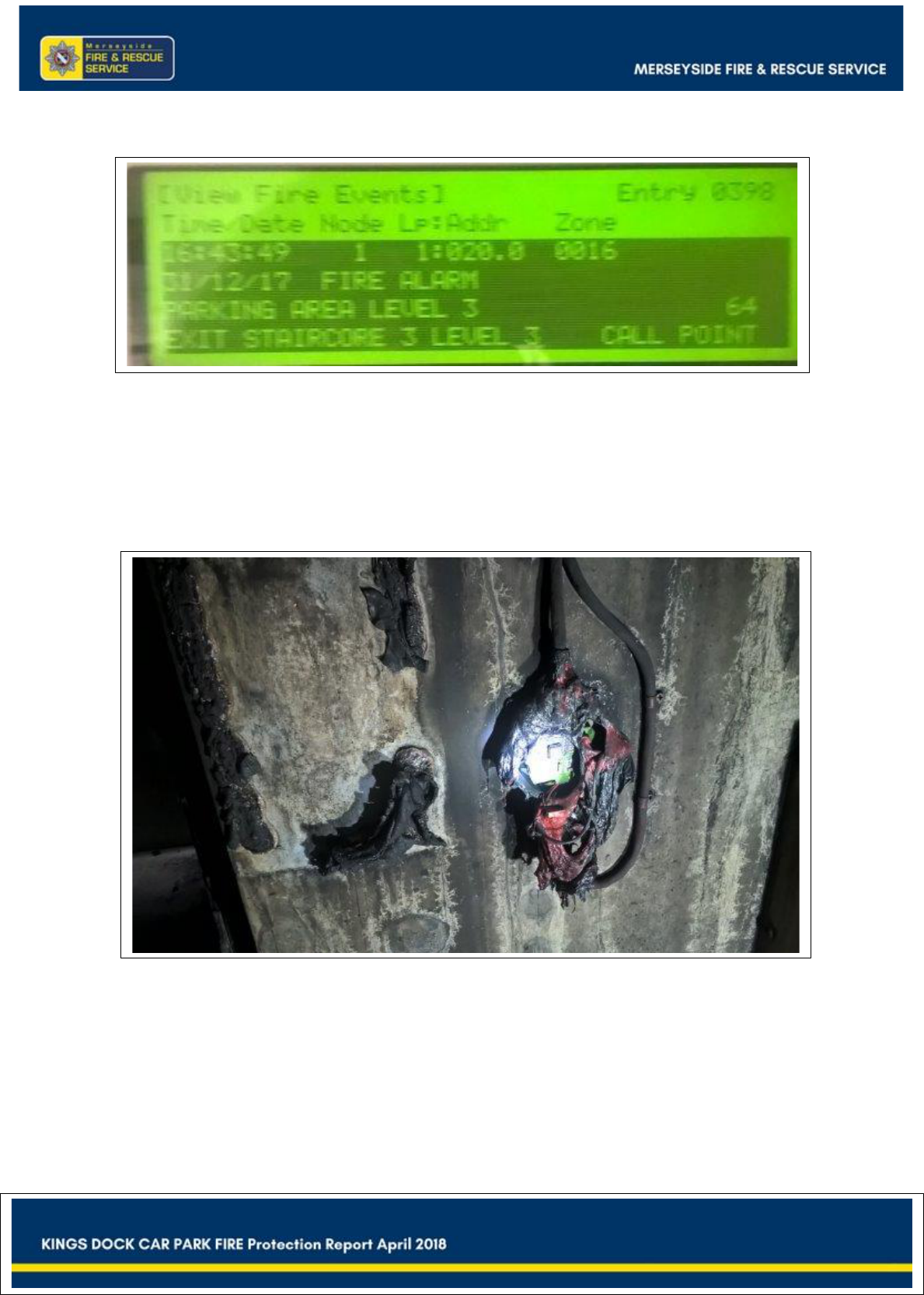
37
Figure 3.4.2: Photograph of Alarm Panel, 1st Actuation
However, it was not possible to visually identify this call point, due to fire damage.
Figure 3.4.3: Photograph of Damaged Call Point on Level 3, Outside Stairwell 3
The second actuation was at 16:51:53, alarm panel indicating multi-sensor 53. The
fire alarm panel indicates lift lobby, level 3.
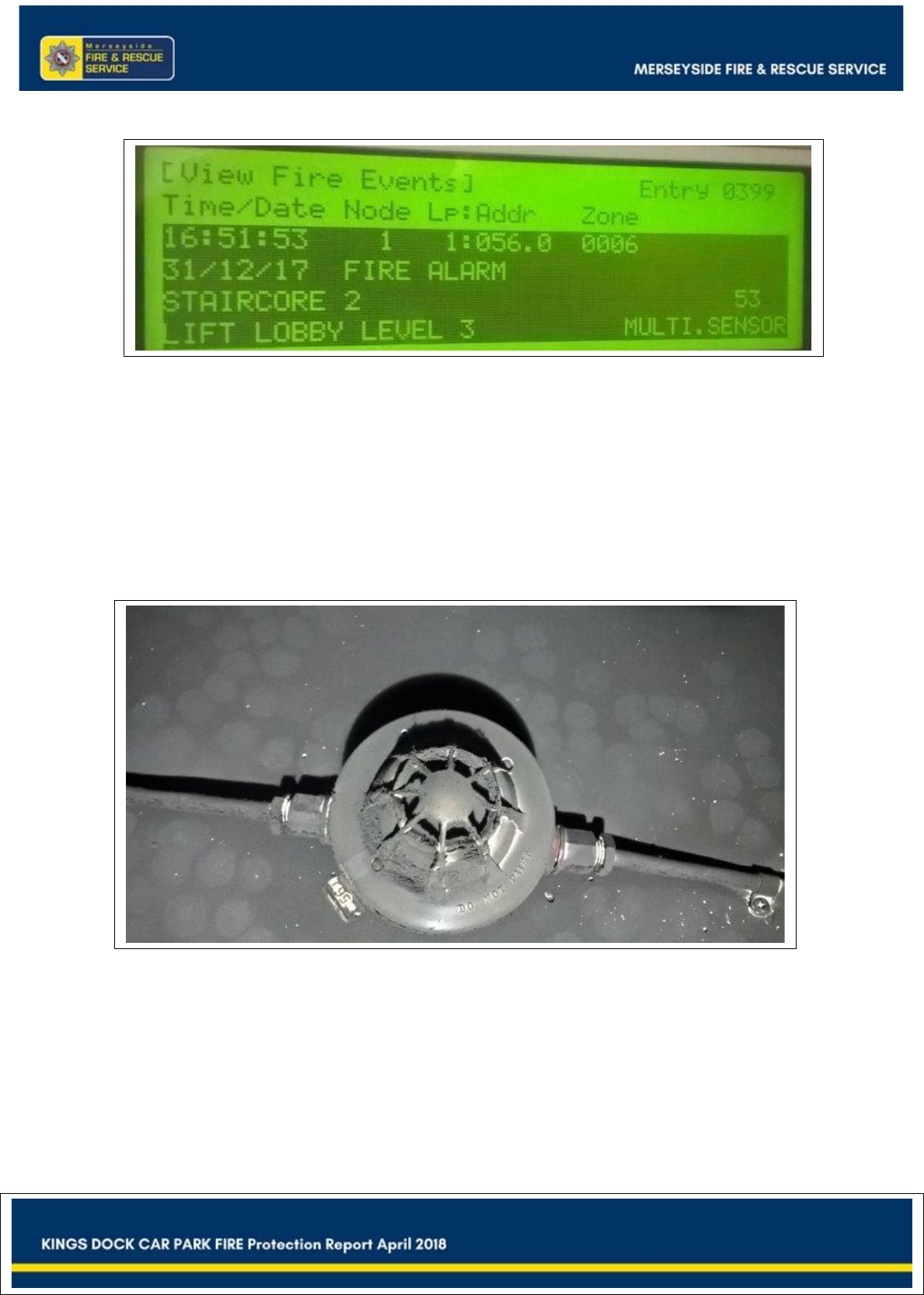
38
Figure 3.4.4: Photograph of Alarm Panel, 1st Actuation
However, the photograph below was taken in the lift lobby area of stairwell 2, level 3
and clearly shows the number 56, once the products of combustion had been removed
from the identity label.
Figure 3.4.5: Photograph of Multi-sensor in Lift Lobby, Stairwell 2, Level 3
Notwithstanding, it is reasonable to assume that both these locations indicated on the
panel are accurate, as the alarm panel indication of a call point on level 3, outside
stairwell 3, was the same location that both LCC staff and a member of the public said
that they had actuated the break glass point. Secondly, the lift lobby door at stairwell
2, level 3 was sited close to the fire. This door was repeatedly opened by members of
the public and staff, allowing the products of combustion into the lobby area, actuating
the multi-sensor.
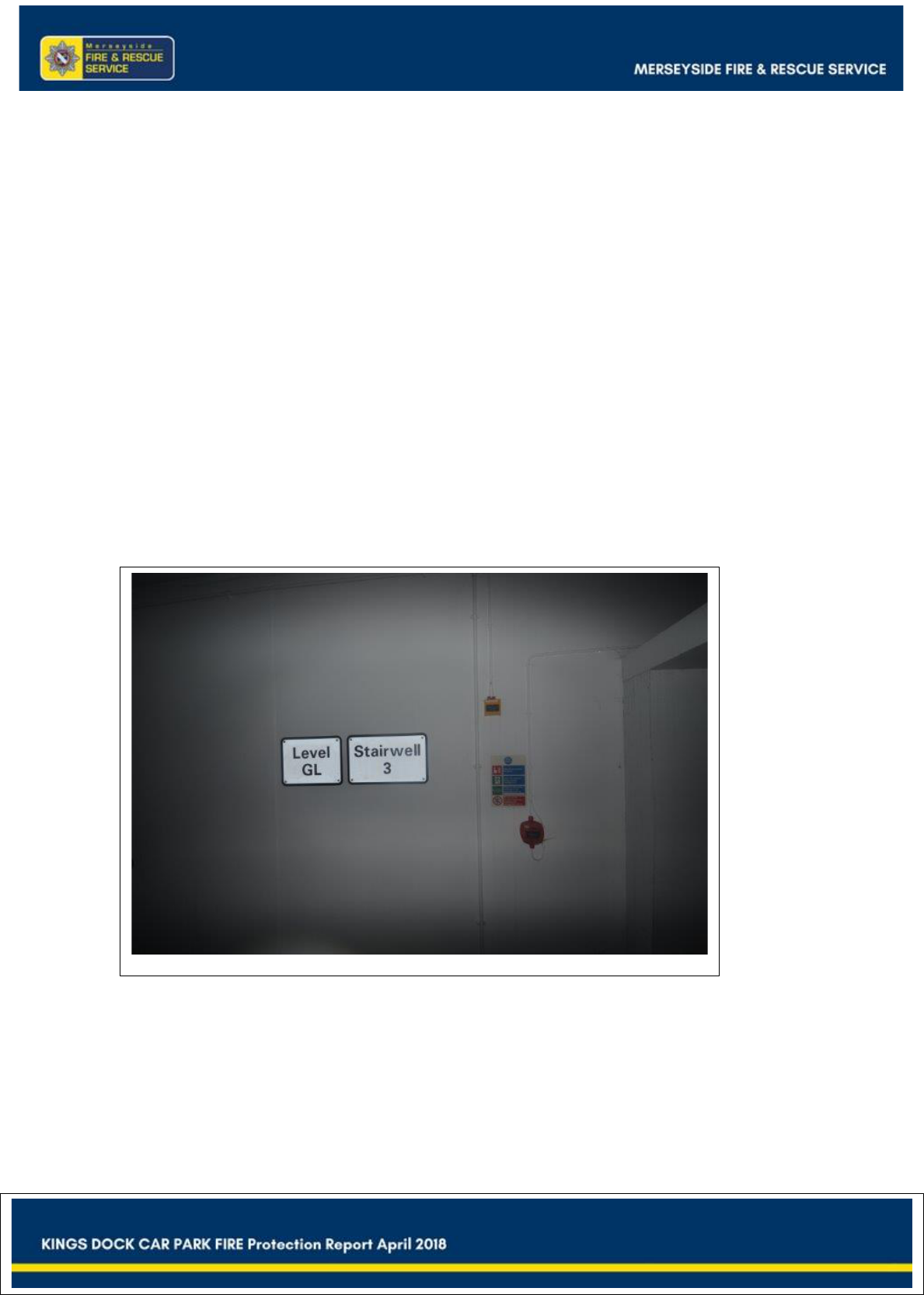
39
Further investigation and scrutiny of the original fire alarm schematics showed that the
call point and detector labelling matched their siting within the building. The zones
indicated on the panel actuations matched both the zonal plan in the office and the
zones of alarm actuation (where staff and members of the public stated that they had
pushed the break glass).
Upon inspection, call point 64 was found to be located in stairwell 4, level 2 and multi-
sensor 53 was located in stairwell 2, level 1. Both these locations matched the fire
alarm schematic.
This would indicate that the detector and call point addresses had been incorrectly
inputted into the alarm system during installation, or at a later stage.
The protected stairwells have dry risers, automatic openable vents with manual
overrides, automatic detection on all levels refuge points with communications and
manual call points are sited adjacent to final exits.
Figure 3.4.6 Active Protection Measures, ground floor, Stairwell 3
The car park and all escape routes are provided with emergency lighting, conforming
to BS5266 and emergency signage conforming to BS5499.
The building comprises four stairwells. Stairwells 1 and 4 are two hour firefighting
shafts, conforming to BS5588-5. Stairwells 2 and 3 are ninety minute protected
stairwells. Stairwells 1 & 2 are served by passenger lifts. None of the stairwells are
served by firefighting lifts.
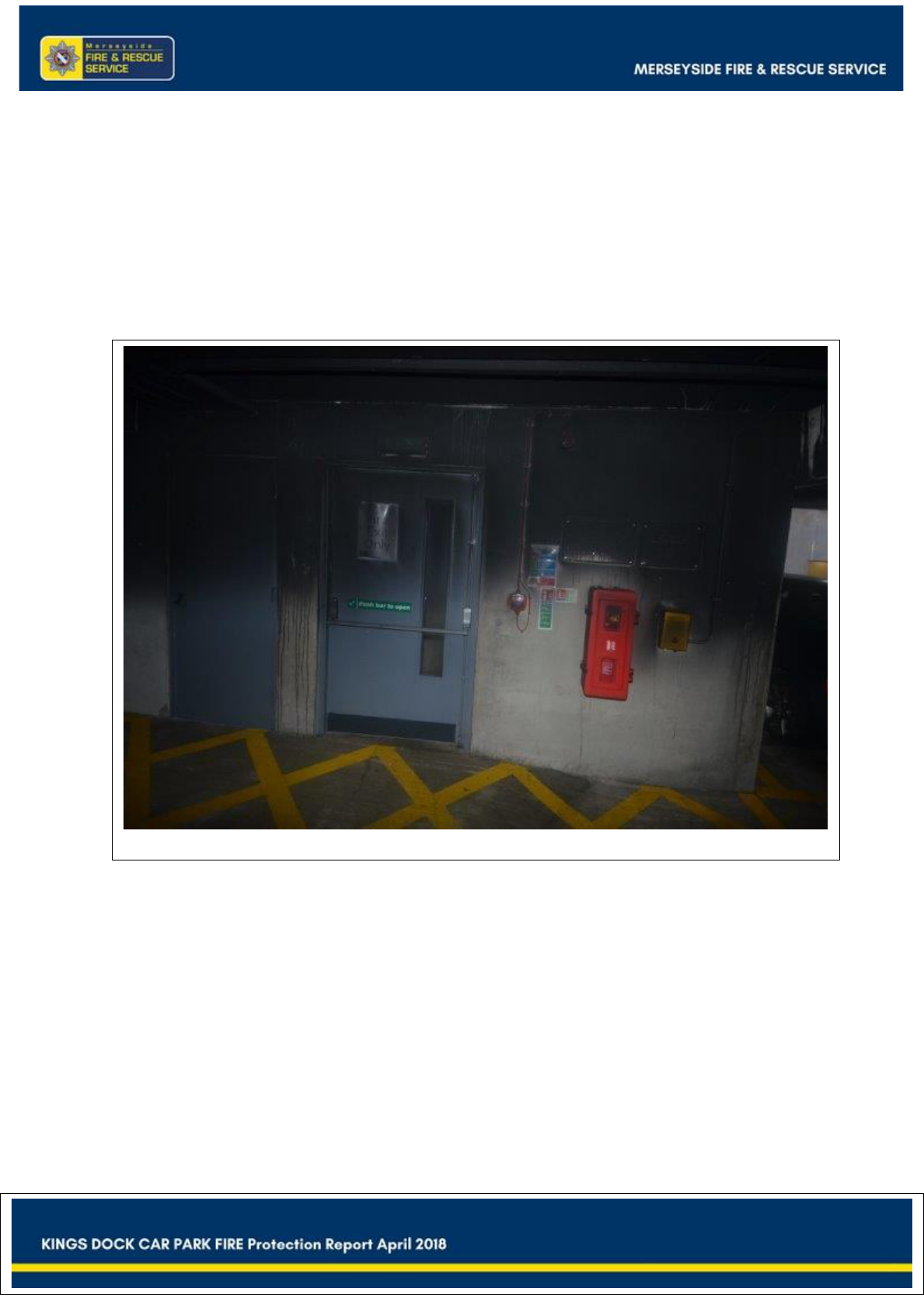
40
Fire extinguishers are located adjacent to call points on all levels and additional
firefighting equipment and a fire event team were provided by WH Management during
the event. The remit of the event firefighting team within the car park did not extend
beyond the stabled area on the ground floor.
Figure 3.4.7 Fire point and exit, Level 1 Stairwell 4
Stairwells 3 and 4 are only available on actuation of the fire alarm. The push bar doors
are locked by magnetic devices, linked to the alarm panel. These stairwells are not
accessible from outside the car park, for security reasons. Members of the public
complained of difficulty in opening the emergency escape door to stairwell 3, level 3.
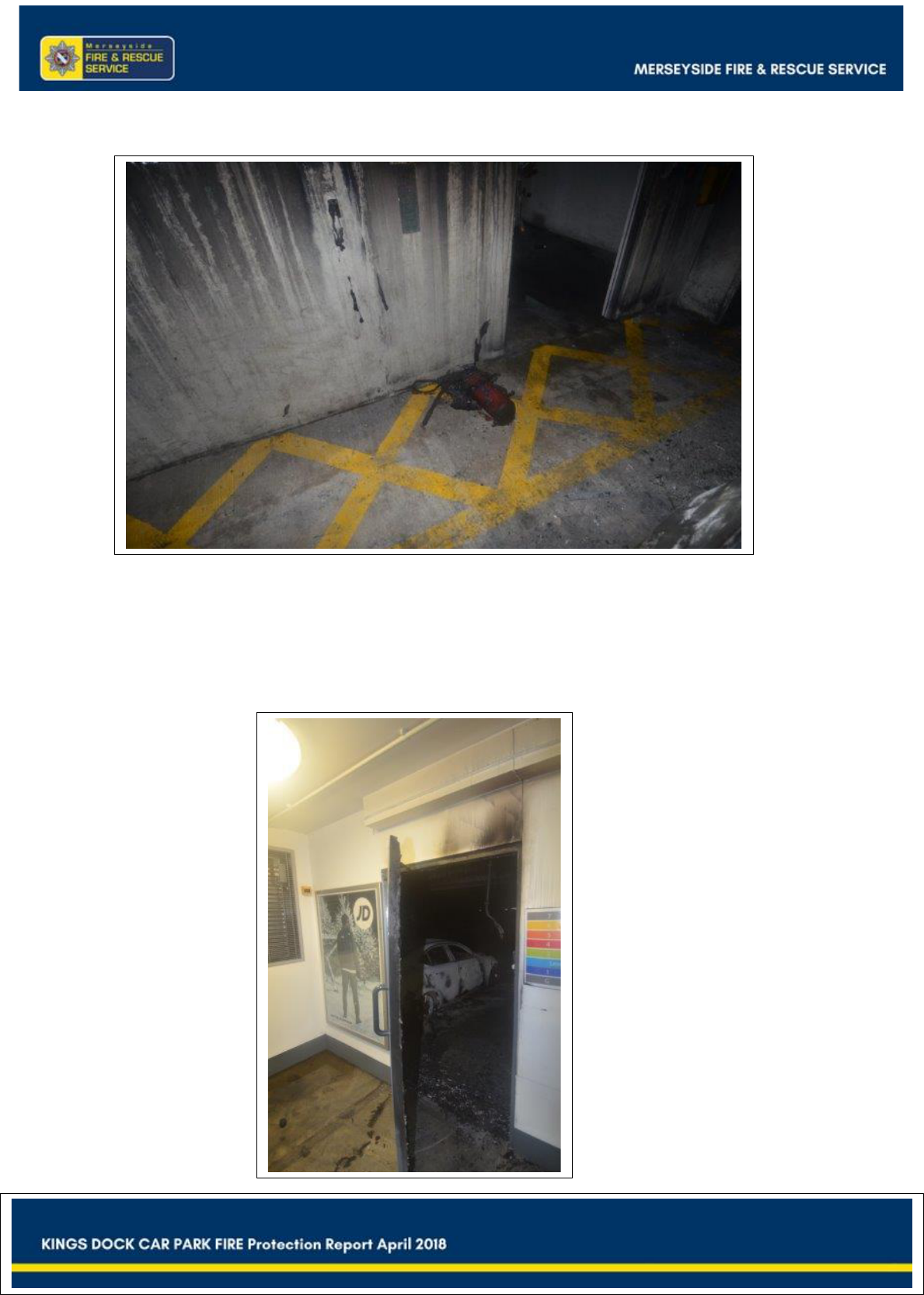
41
Figure 3.4.8 Remnants of Fire point, Level 3 Stairwell 3
Images 3.4.9 and 3.4.10 are good examples of the effectiveness of the passive fire
protection measures in place and how well they performed, despite the severity and
intensity of the fire.
Figure 3.4.9 Stairwell 2 Level 2 exit from parking area
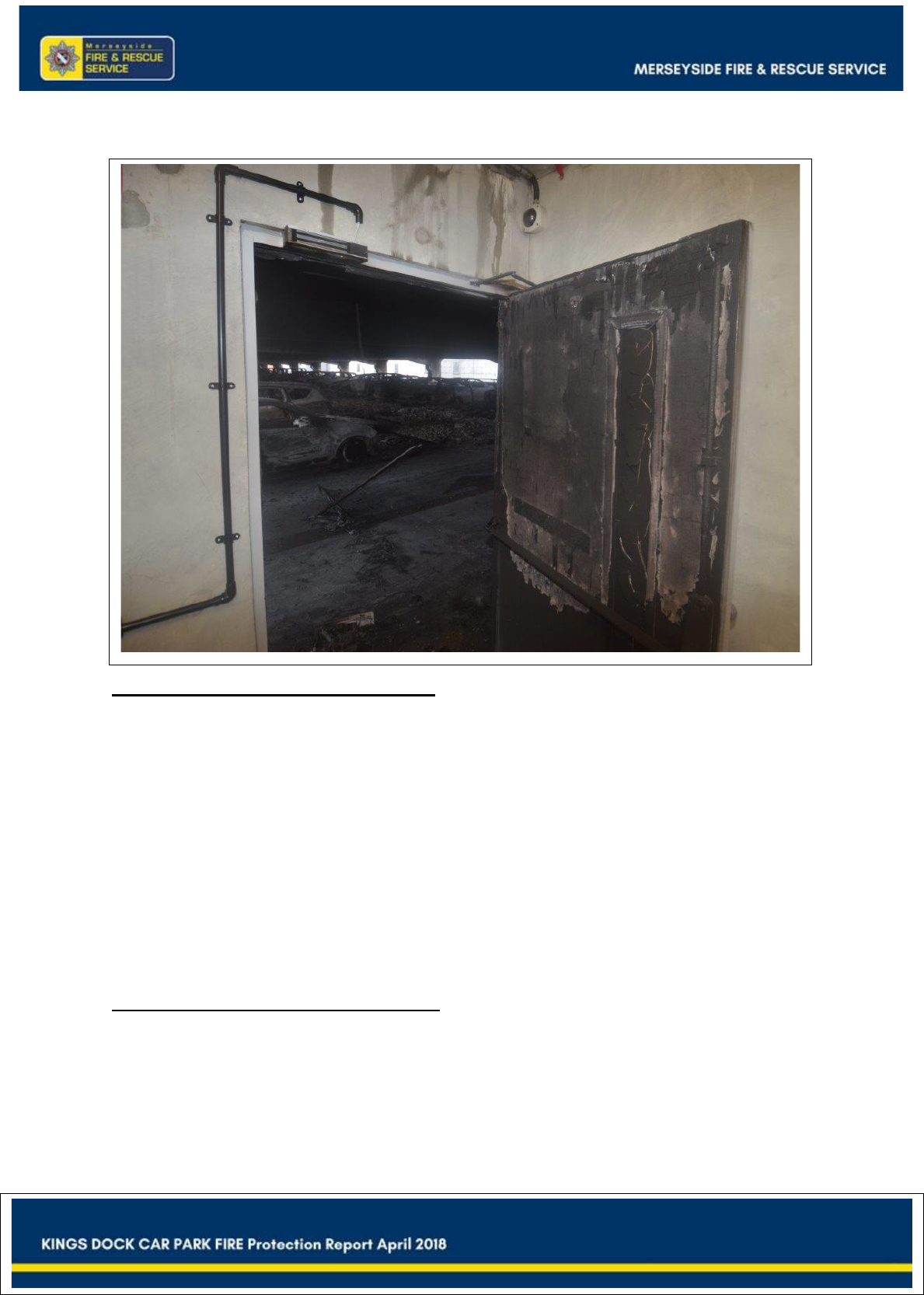
42
Figure 3.4.10 Stairwell 3 Level 2 exit from parking area
Observations and recommendations
1. LCC are advised to undertake an audit of fire escape doors at all parking
locations, to check compliance to BS5839-3 and BS7273-4.
2. Correctly labelled addressable detectors and call points clearly help the
responsible persons and Fire and Rescue Services to reduce the time taken to
identify the specific location of alarm actuation. A delay to locating a fire can
lead to an escalated incident and potentially more severe fire.
3. Where CCTV is used as part of a fire strategy for detecting a fire, it should fulfil
the requirements of BS EN 6276 and BS8418 and have adequate numbers of
staff to monitor it. If this is not achievable, then alternative and/or additional
detection should be considered.
3.5 Firefighting Access and Facilities
The gross floor combined area exceeds 24,000m² and consequently requires 100%
perimeter access for pumping appliances and high rise appliances. The apartments
constructed on the south and east sides, restrict 50% of the access area, consequently
reducing firefighter appliance and aerial appliance access to 50% of the building. As
a result MF&RS insisted on firefighting shafts so that a fire could be fought internally,
in a safe environment (see 3.4 Fire Protection Measures p.36).
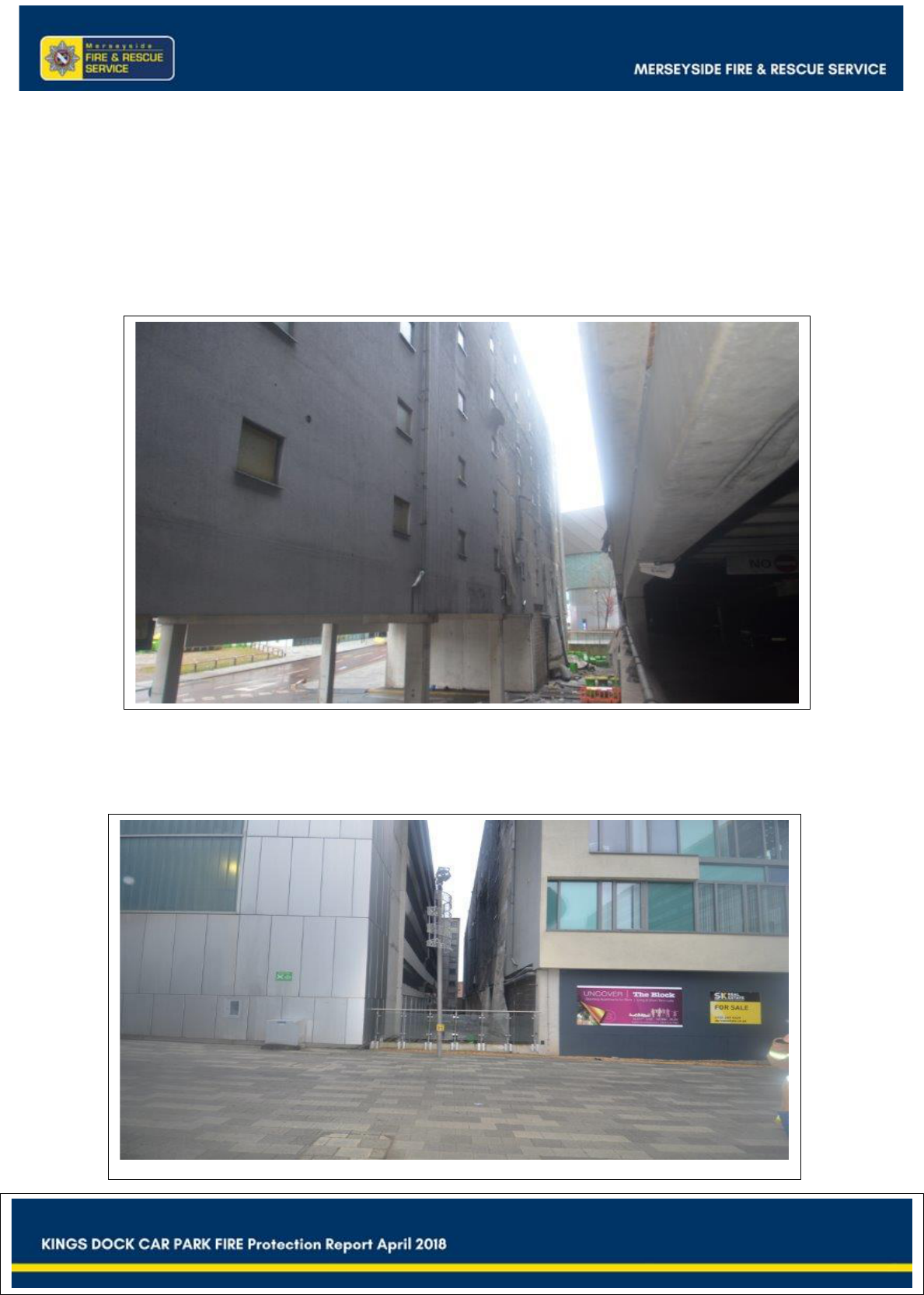
43
The following images show the severely restricted firefighter appliance access due to
the proximity of the serviced apartment building on the southern side of the car park.
This negative impact was identified during building regulations submissions and
MF&RS insisted on protected stairwells to mitigate this deficiency and accommodate
internal firefighting, reaching all levels.
Figure 3.5.1: Firefighting Access on southern elevation
Figure 3.5.2: Firefighting Access on southern elevation, viewed from western
elevation
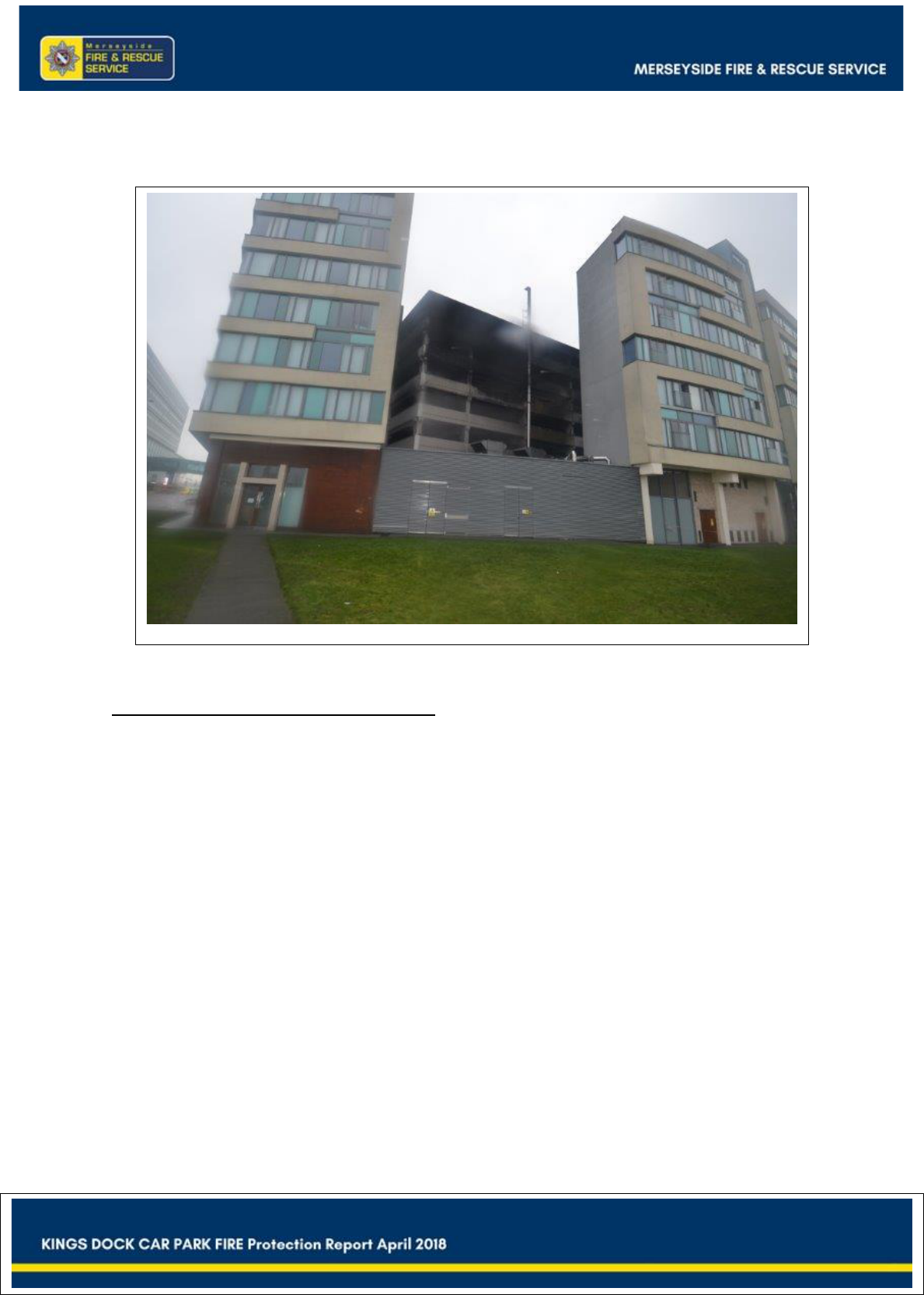
44
Figure 3.5.3: Firefighting Access on the eastern elevation, viewed from easterly
direction
Observations and recommendations
1. Aerial appliance access proved very difficult at this incident and the grilles
across the open sides hindered external firefighting. Access and facilities for
firefighters at car parks should be reviewed.
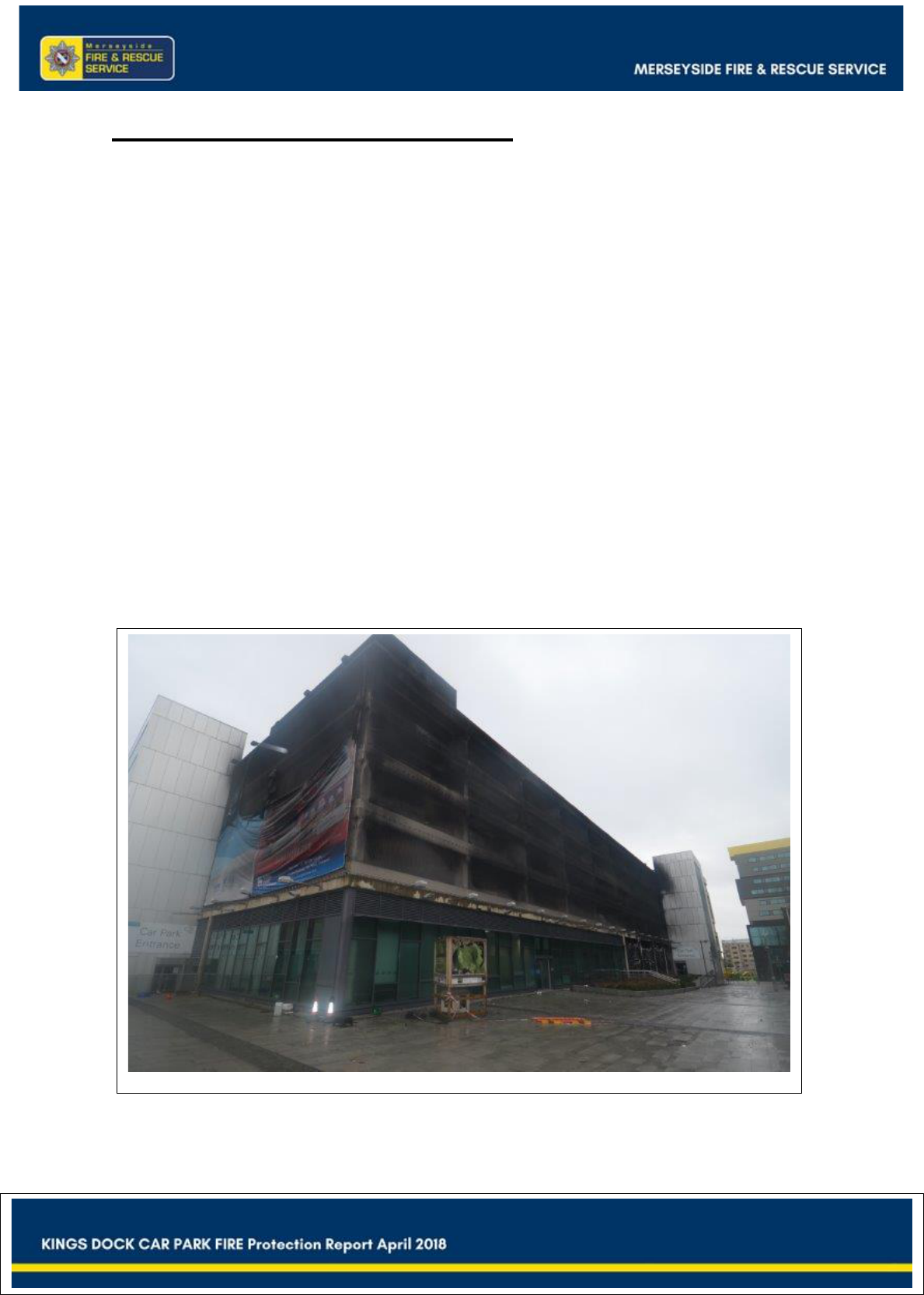
45
4. NATURAL VENTILATION
Approved Document B, Volume 2, (Buildings other than dwelling houses), Section
11.3b states that, in order for the car park to be defined as open-sided:
“each storey should be naturally ventilated by permanent openings at
each car parking level, having an aggregate vent area not less than 1/20th
of the floor area at that level, of which at least half (1/40th) should be
equally provided between two opposing walls;”
Post incident, MF&RS and LCCLABC undertook a thorough and robust examination
of the car park, to ascertain whether the cross ventilation was compliant with ADB,
Vol.2 and whether advertising hoardings attached to two locations on the northern
elevation had any potential negative effect on compliance. A comprehensive survey
of differing aperture areas was undertaken, involving a mobile elevating work platform
and laser measuring, due to the unstable nature of the floors following the fire.
Figure 4.1: Fire damaged advertising hoardings
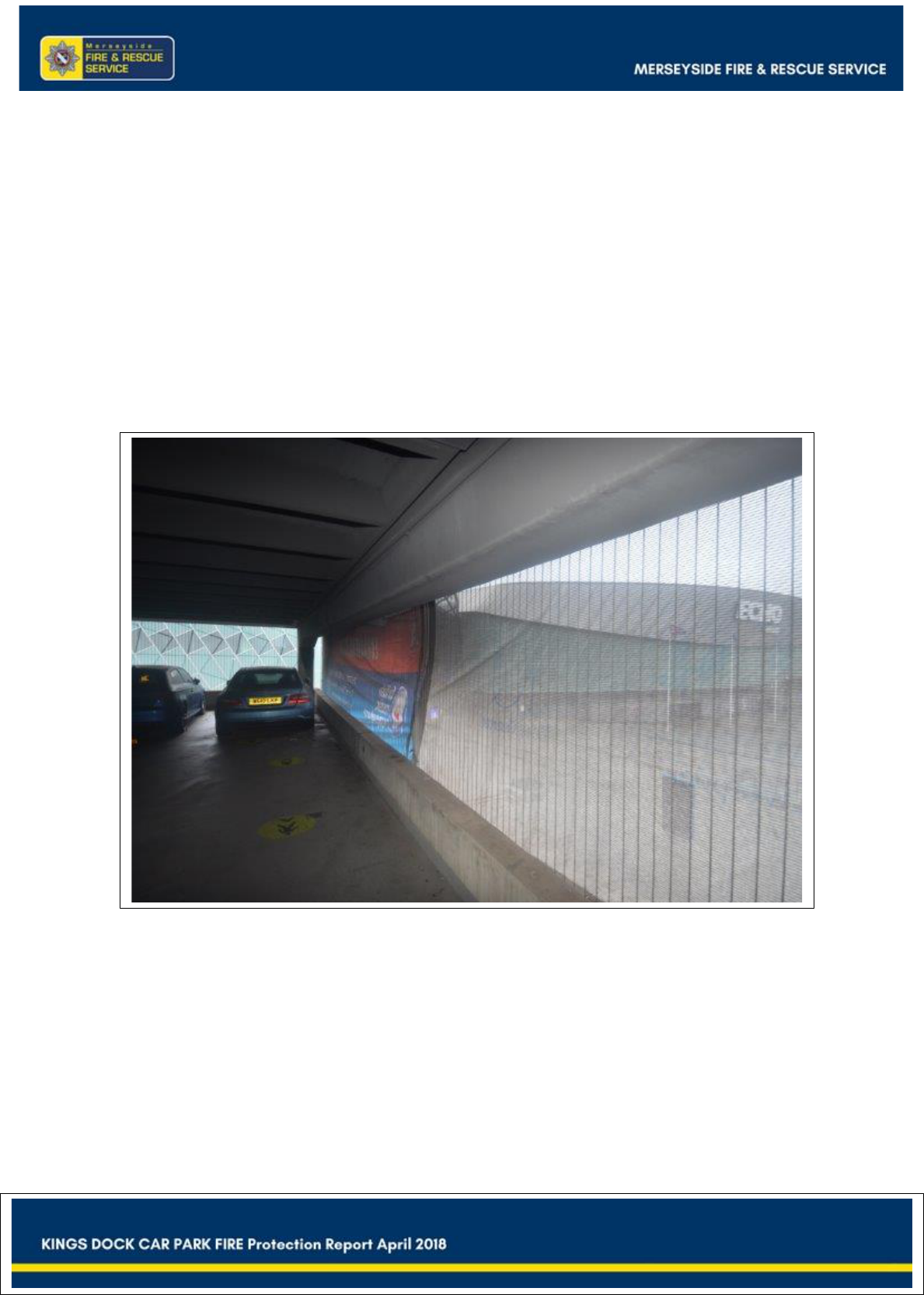
46
Initial calculations from plan drawings of the building showed that the building had
been constructed to plan and that the natural ventilation requirements had been
achieved. However, both parties wanted a definitive answer and LCCLABC should be
commended for this. The calculations submitted to MF&RS by LCCLABC are very
similar to the calculations performed by MF&RS and both show compliance to the
regulations set out in ADB Vol.2.
These calculations differ because MF&RS measured distances from as-built drawings,
whereas LCCLABC used laser measuring on site for actual opening sizes.
MF&RS took into account an approximate 8% reduction in ventilation caused by the
advertising in their calculations and the building still complied with ventilation
requirements under ADB Vol.2.
Figure 4.2: Internal view of grille and advertising on level 2
As can be seen from the above photographs (Figs. 4.1 & 4.2), the apertures between
columns are covered by grilles. These ‘Tigris Woven Mesh Panels’ cover the apertures
from level 3 to level 6 on the northern and western elevations. The free area of these
mesh panels is 65 %, according to GKD UK, the PC-Tigris data sheet. This was taken
into account by both LCCLABC and MF&RS in their calculations.
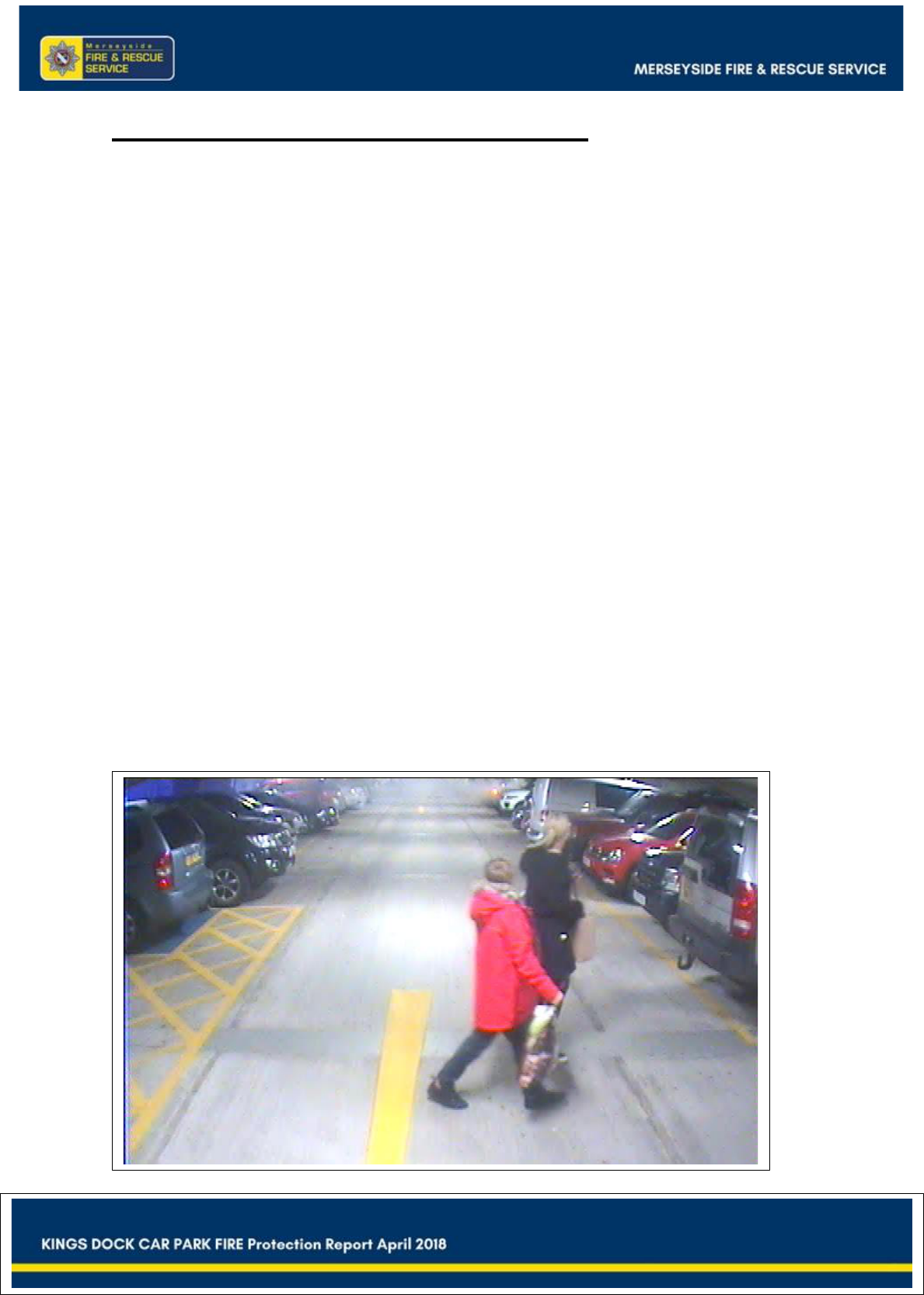
47
5. HUMAN BEHAVIOUR TO FIRE
Human Behaviour in Fire is the study of human response when exposed to fire in
buildings. It includes an understanding of people’s awareness, beliefs, attitudes,
motivations, decisions, behaviours and coping strategies and the factors that influence
them.
In the case of the Kings Dock fire, human behaviour and reaction to the fire may have
led to fire development prior to MF&RS arrival and may have caused initial attending
crews and incident commanders to have been distracted from commencing an
immediate weighted attack on the fire on level 3. Considering the number of witnesses
to the fire in its initial stages and their ability to dial 999 (mobile phone technology),
very few calls were received by MF&RS Fire Control in the early stages of the incident
and this would appear to indicate that members of the public displayed reactions to
fire that go against all fire situation training and advice.
CCTV footage shows several pedestrians and persons in vehicles witnessing the fire
but not making an emergency call. Some decided to drive down to ground level and
report the incident to LCC staff, whilst others did nothing. One particular driver stopped
their vehicle in the roadway for 30 seconds, immediately next to the vehicle of origin
when it was well alight and then proceeded to park their vehicle on the ramp from level
3 to level 4, without raising the alarm.
The CCTV images below (Figure 5.1.1) was taken just before first 999 call. None of
these witnesses called 999 or raised the alarm and the image overleaf (Figure 5.1.2)
captures the event approximately 3 minutes prior to 999 call.
Figure 5.1.1: CCTV still frame
The following image captures the event approximately 1 minute prior to 999 call.
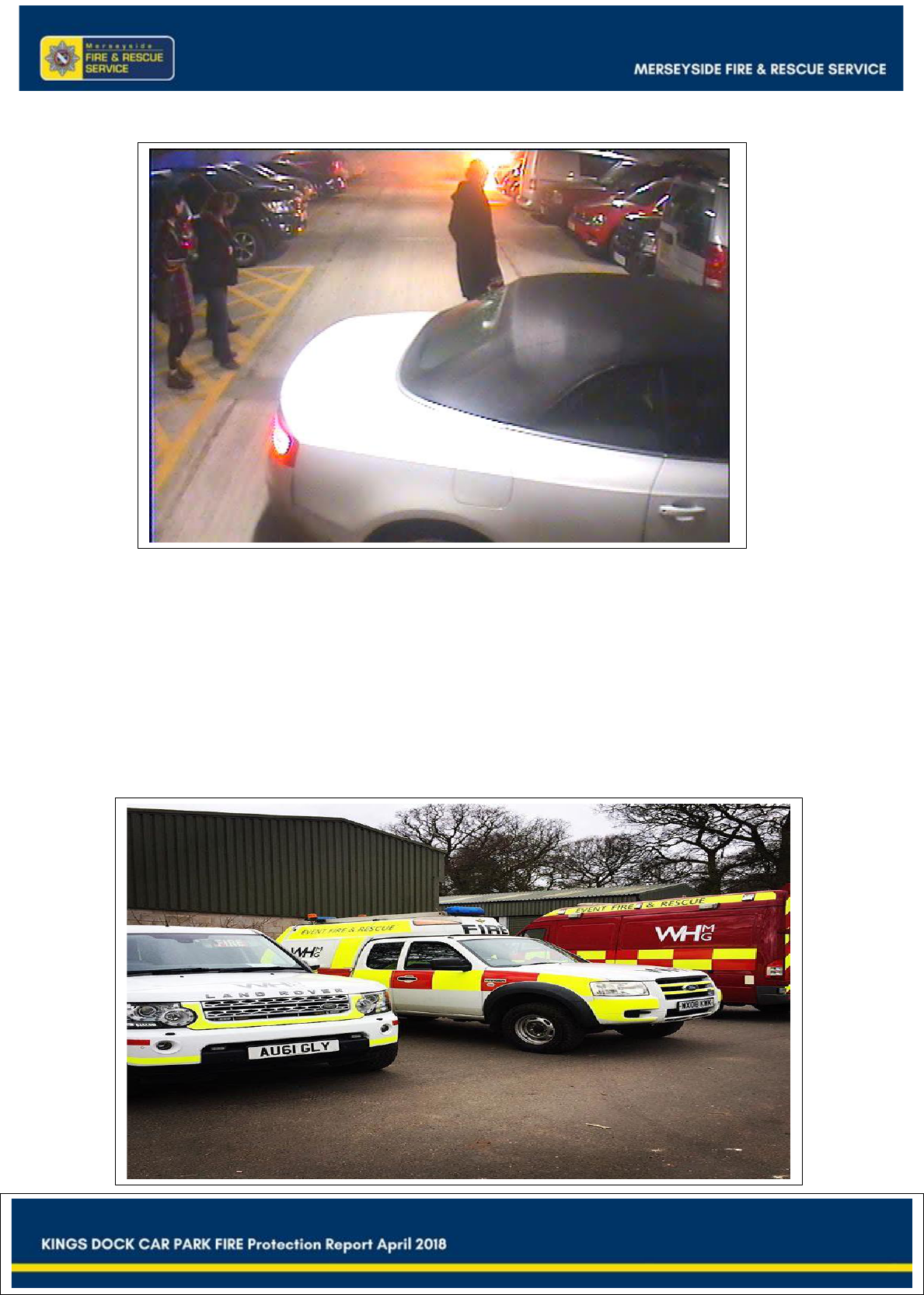
48
Figure 5.1.2: CCTV still frame
Only five 999 calls were received by MF&RS prior to first attendance (between
16:42hrs and 16:45hrs). No further 999 calls were made until 17:25hrs.
An “Event Firefighting Team” was in attendance by 16:45hrs. They parked outside the
main entrance to the car park, in a vehicle which had blue flashing lights and “fire &
rescue” livery. This may have led members of the public to believe that MF&RS were
in attendance and reduced number of 999 calls.
Figure 5.1.3: WH Management Emergency Response vehicles
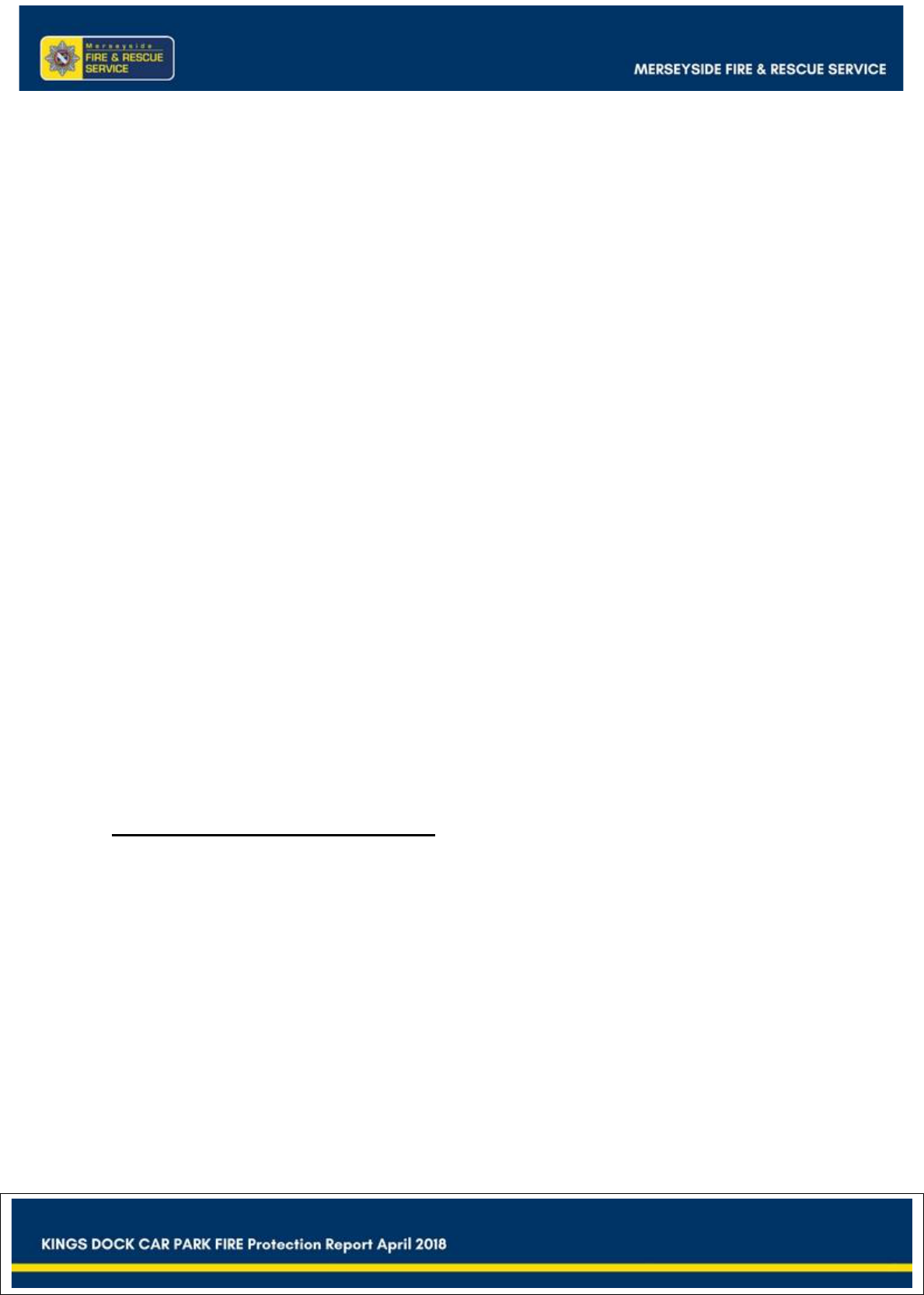
49
MF&RS, LCC, ACCL and WH Management staff all cited members of the public not
following instruction to evacuate, distracting staff from performing their duties, and
interfering with prescribed fire strategies that had been agreed between the
responsible parties. Although the vast majority of members of the public’s actions and
inputs were undoubtedly well-intentioned, the WH Management Post Incident Report
contains the following statement:
“During the briefing stage, a member of the public had forced her way into the stable area and started
to open stable doors. This caused panic with horses and younger grooms in what had been a calm and
prepared area. She was asked to leave twice by WH and event organisers who on the third warning
escorted her out of a side entrance. Her actions were irresponsible, dangerous and placed not only
herself but also others at risk.”
The first social media post (complete with photo of the vehicle of origin on fire) was
posted by 16:50hrs and this was followed by a ‘live stream’ on social media by
16:57hrs. This would appear to reinforce a growing trend of members of the public
placing more importance on capturing emergency events, disasters, RTCs, assaults
etc. for uploading to a social media platform, rather than follow the basic principles of
fire safety advice of leaving by the nearest available exit; raising the alarm and letting
the emergency services deal with the incident.
Notwithstanding the above, it should be noted that two student nurses who made the
initial 999 call, did exactly what FRS advises (raise the alarm, leave the premises and
stay out). They had entered the car park and were proceeding to drive up the levels
when they noticed the fire. They called 999, drove down to ground level and informed
LCC staff and then drove out of the car park.
Observations and recommendations
1. Event organisers should seriously consider the limitations of private emergency
response teams.
2. Private response teams should make every attempt, as far as is reasonably
practicable, to ensure that their personnel, equipment and vehicles are not
mistaken for emergency services. The requirement for response under blue
lights by such teams is seriously questionable.
3. MF&RS would advocate more public information as to what their actions should
be upon discovering a fire and the potential positive and negative effects of
members of public recording and streaming live emergency incidents and the
impact this has on the emergency services and any potential victims.
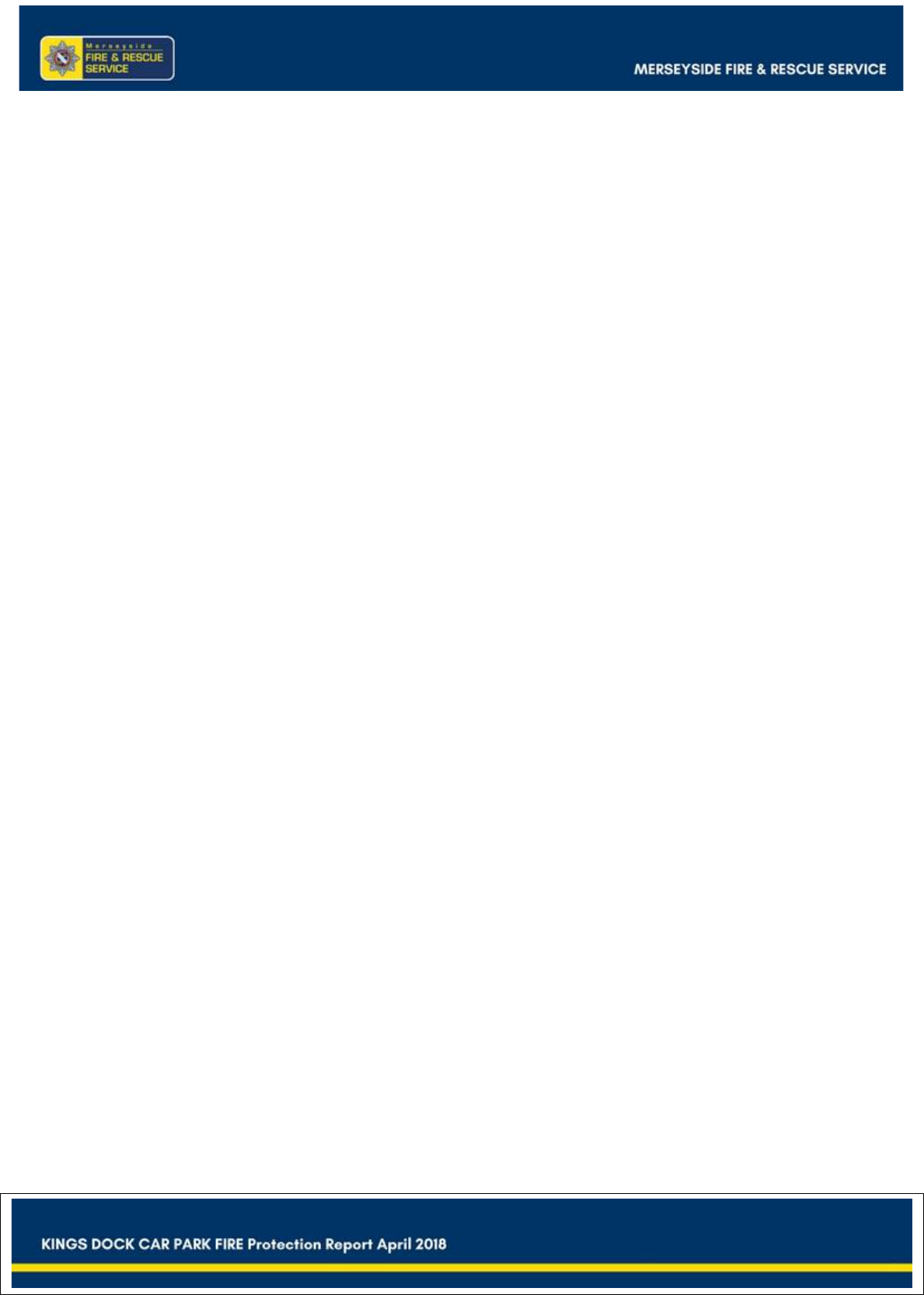
50
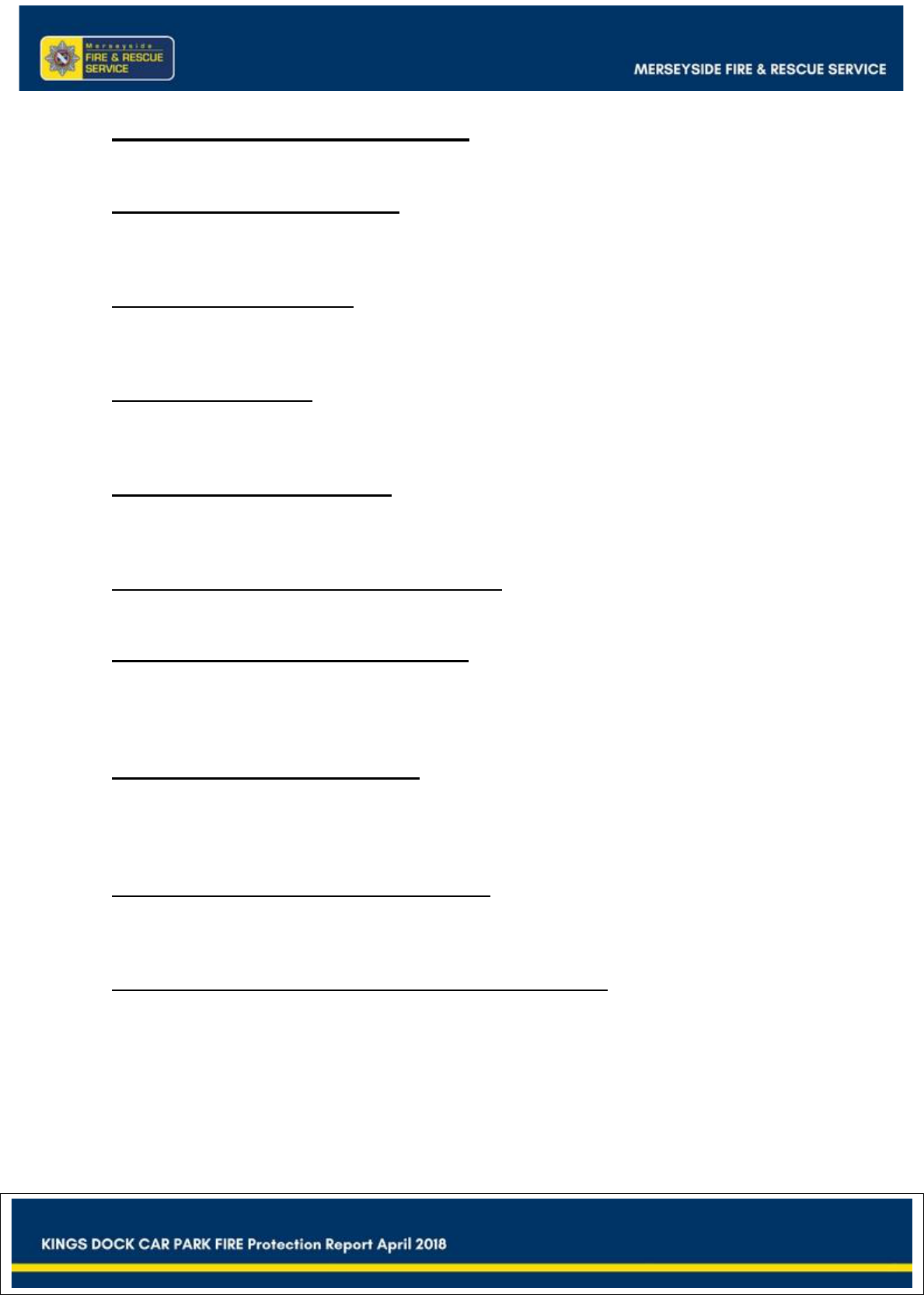
51
6. RELATED INCIDENTS
Fleming Way, Wiltshire, 29/01/18
Multi-storey car park, attached to local shopping centre, three crews dispatched to
tackle a vehicle fire on the third floor, suspected to have been deliberately ignited.
Topp Way, Bolton, 20/01/18
Multi-storey car park, single vehicle fire within the multi-storey car park. Firefighters
using one main jet on scene for 1 hour, recorded as an accidental fire.
Paris, France, 10/01/18
Fire in underground car park, 1 Firefighter fatality (heart attack), 120 Firefighters
attended.
Jecheon, South Korea, 20/12/17
Fire in a ground floor car park spread to the floors above in an eight storey building.
29 people were killed.
Boomtown Festival Fire, Hampshire, 12/8/16
Open car park on a straw stubble field. 92 vehicles involved in fire.
Southwater, Telford, Shropshire, 20/6/16
Multi-storey car park, fire involving several vehicles causing damage to wiring,
electrical fittings and surrounding structures on the third floor. 3 appliances dispatched,
using BA and one main jet brought the fire under control within 2 hours.
Cheltenham Rd, Harrogate, 4/12/15
Multi-storey car park, vehicle fire on 5
th
floor, 4 appliances dispatched and one aerial
ladder platform due to the position of the fire. Crews used 1 dry powder and 1 carbon
dioxide extinguisher to resolve the incident.
Isle of Wight, Newport town centre, 17/7/15
Multi-storey car park, one car involved, crews hauled up a hose reel to extinguish the
vehicle, fire investigation concluded as accidental ignition.
Willow Place Shopping Centre, Corby, Teeside, 30/12/14
Multi-storey car park building, several vehicles involved, damage to the car park
structure and several retail outlets. 6 appliances attended, 30 firefighters worked for
four hours to extinguish the fire. 4 youths aged between 14 and 20 charged with arson
in connection with the incident.
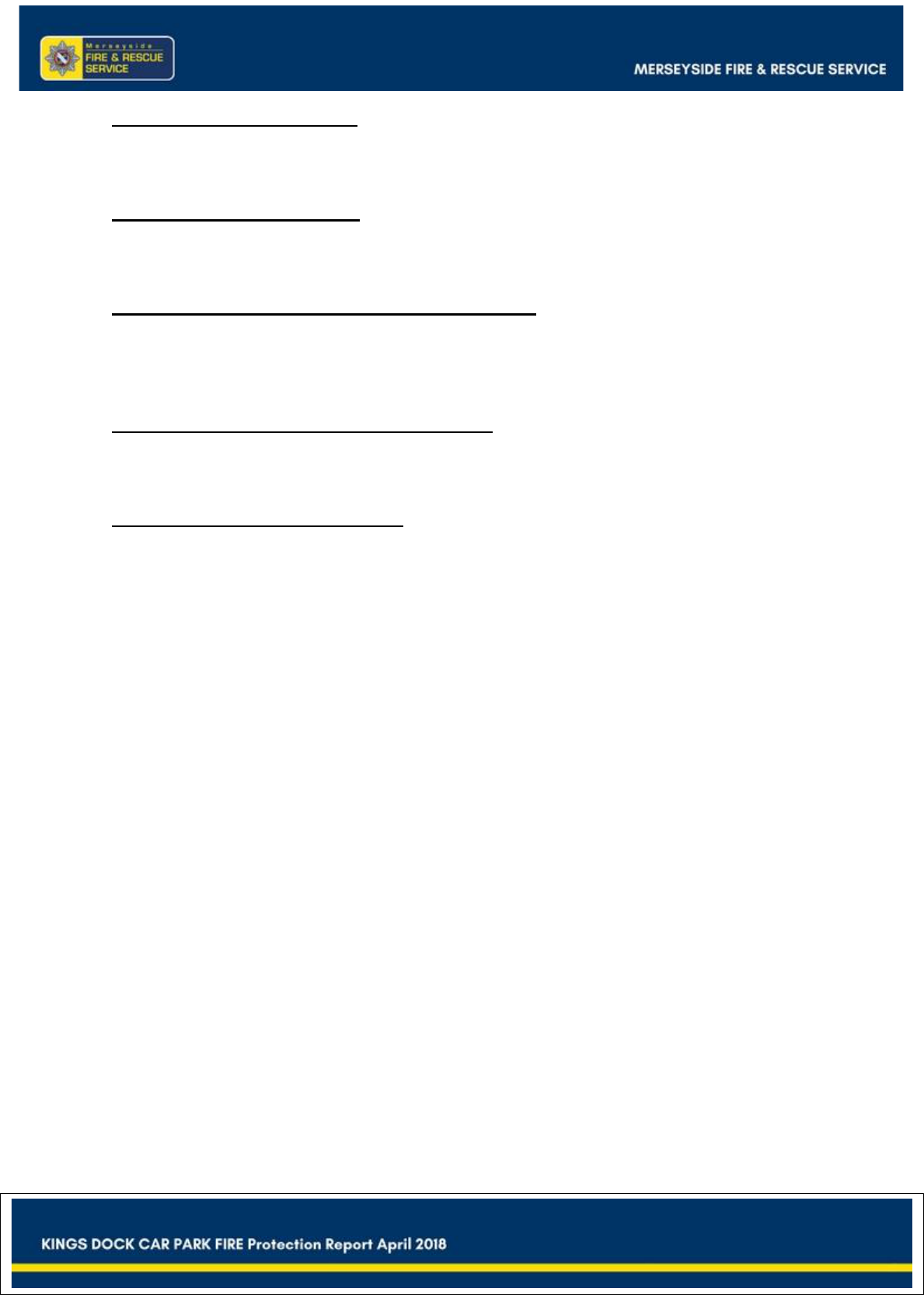
52
Place Vendome, Paris, 2012
Underground car park, 40 high performance and luxury vehicles lost in fire, declared
as accidental ignition due to electrical fault.
Ivry-sur-Seine, France, 2009
Multi-storey car park, 200 vehicles involved in fire, fifteen appliances engaged, use of
aerial appliances as water towers.
Foregate Shopping Centre, Kilmarnock 26/12/08
Multi-storey car park, fire on the third level with heat and smoke travel up to the fourth
and fifth levels. 2 BA teams deployed, a total of 11 vehicles damaged, fire investigators
found the cause to be accidental.
Monica Wills House, Bristol, England, 2006
Multi-storey car park, fire involving 22 vehicles, one fatality due to smoke inhalation
from occupancy above the parking facility.
Gretchenbach, Switzerland, 2004
Underground multi-storey car park, fire involving up to one hundred vehicles, 7
firefighters killed during firefighting operations.
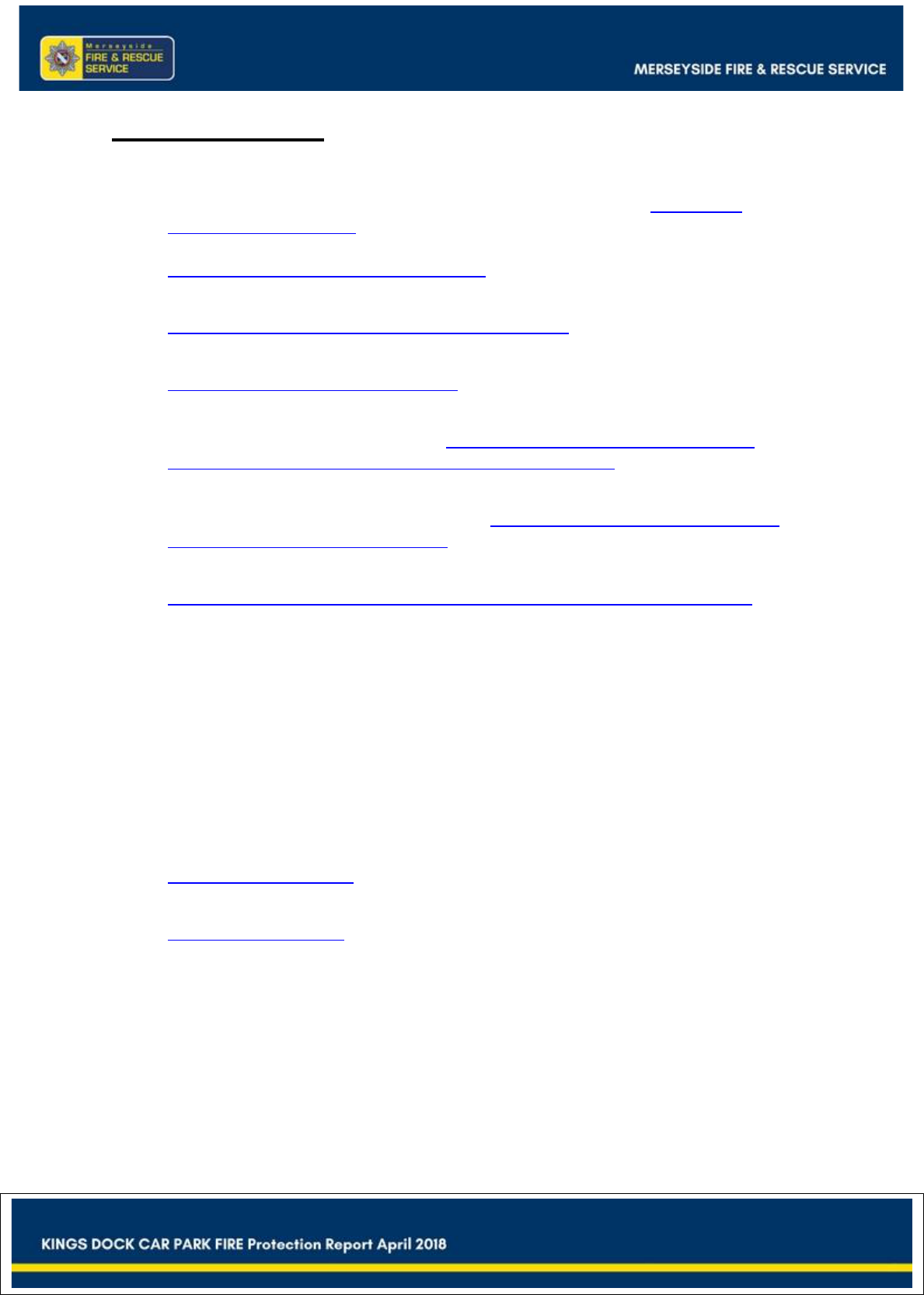
53
REFERENCES
1. Ministry of Housing, Communities and Local Government, Fire safety:
Approved Document B, Building Regulations 2010
2. BRE, Fire spread in car parks BD2552, December 2010
3. The Regulatory Reform (Fire Safety) Order 2005
4. British Parking Association website, accessed 26/01/18
5. The Institution of Civil Engineers, Recommendations for the Inspection,
Maintenance and Management of Car Park Structures, 2002
6. The Institution of Structural Engineers, Design recommendations for multi-
storey and underground car parks, Fourth Edition, March 2011
7. Structural-Safety, SCOSS Topic Paper, Fires in Multi-Storey Car Parks,
February 2018
8. Ministry of Technology and Fire Offices’ Committee Joint Research
Organisation, Fire and Car Park Buildings, Fire Note 10, E.G. Butcher, G.J.
Langdon-Thomas and G.K. Bedford 1968
9. Municipal Engineering in Australia, BHP Fire Tests Prove the Value of
Sprinkler Systems, Volume 14, Issue 4 pp.3-13, Thomas, I., Bennetts, I.,
September 1987
10. UNECE Regulation 34 Technical Prescriptions for Wheeled Vehicles
11. PC-Tigris Data Sheet GKD UK
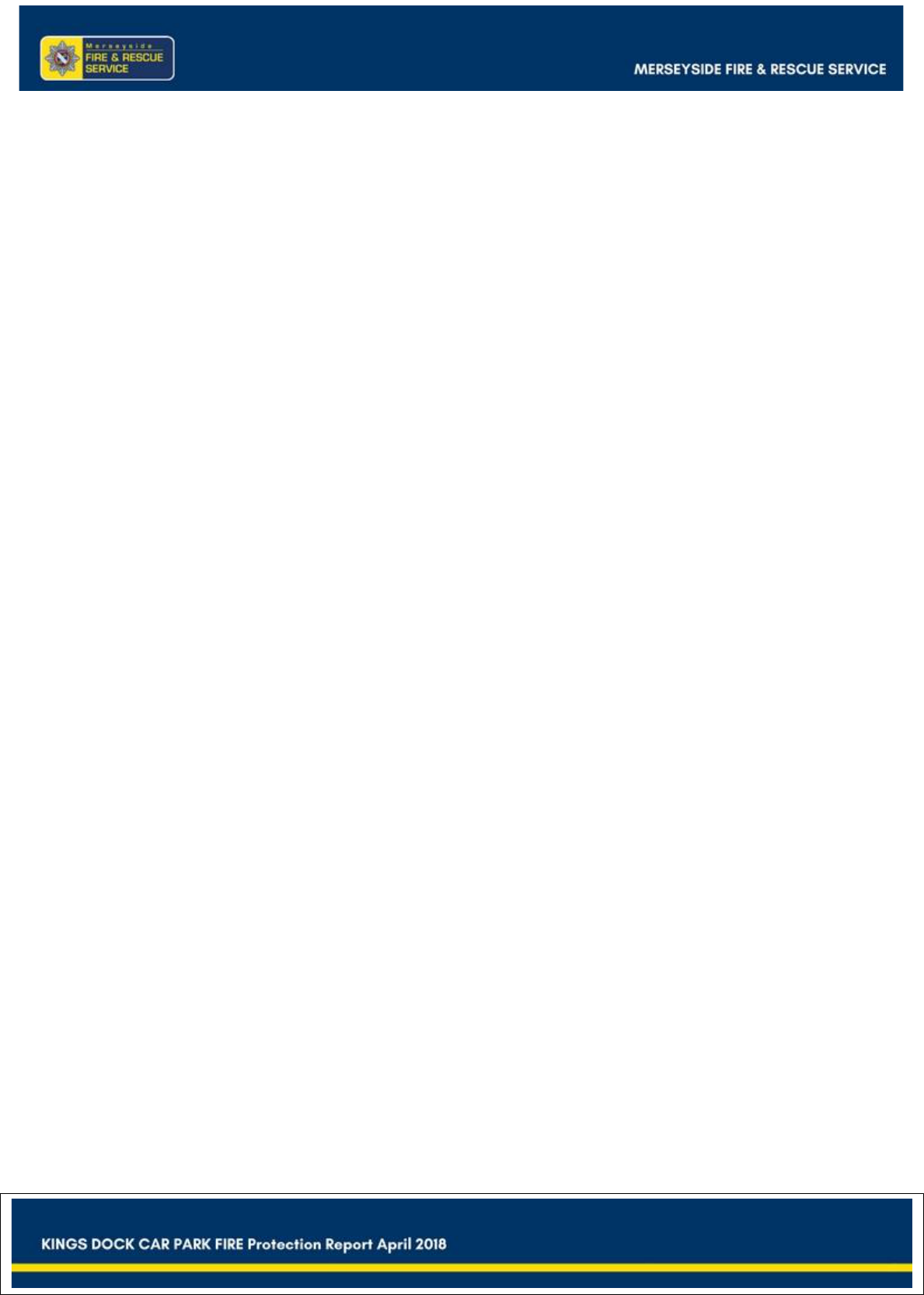
54
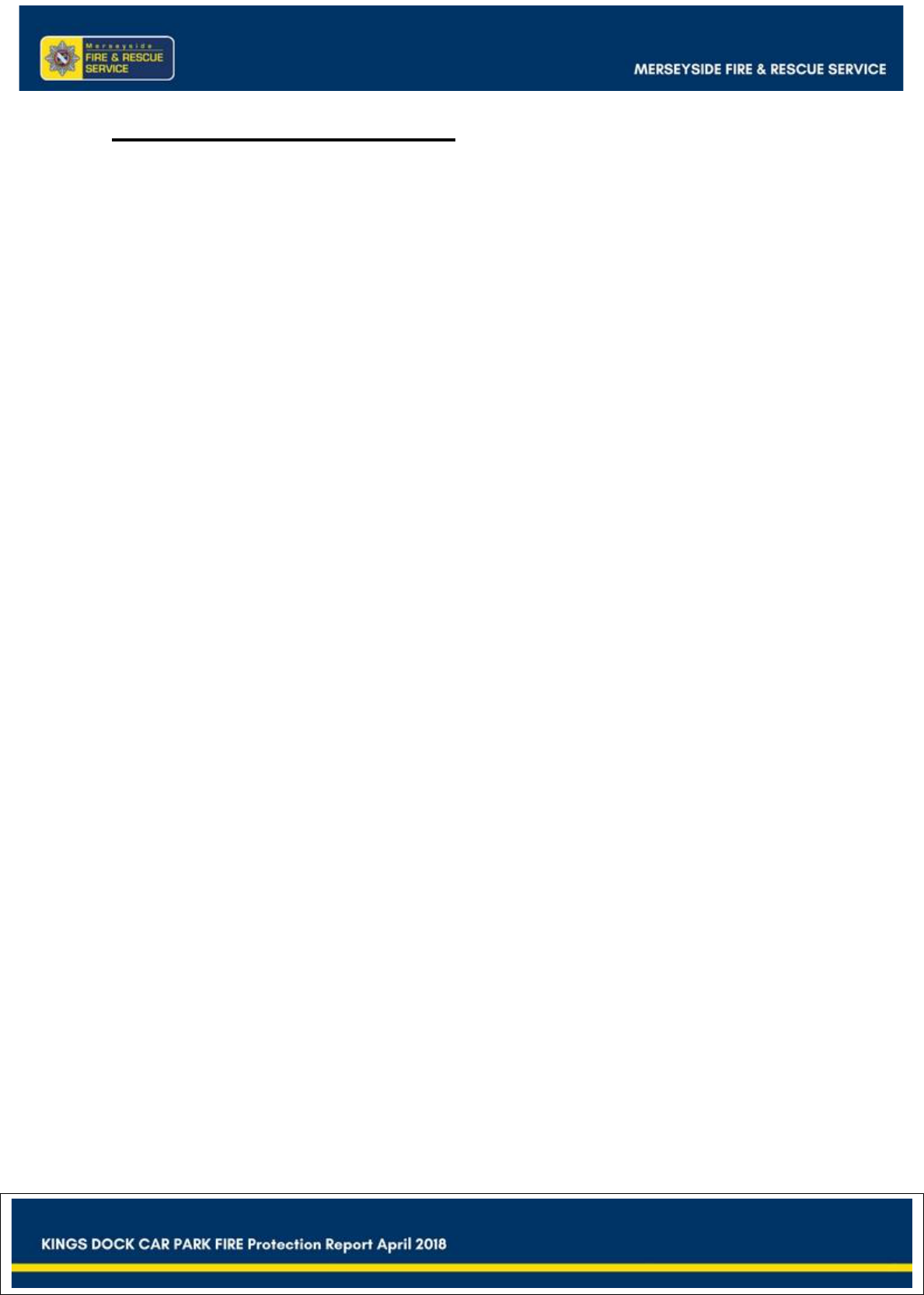
55
GLOSSARY OF TERMS
ACCL: ARENA and CONFERENCE CENTRE LIVERPOOL
ADB: APPROVED DOCUMENT B
BA: BREATHING APPARATUS
BRE: BUILDING RESEARCH ESTABLISHMENT
BS: BRITISH STANDARD
CCTV: CLOSED CIRCUIT TELEVISION
DCLG: DEPARTMENT of COMMUNITIES and LOCAL GOVERNMENT
FRA: FIRE RISK ASSESSMENT
H&S: HEALTH and SAFETY
IIT: INCIDENT INVESTIGATION TEAM
LCC: LIVERPOOL CITY COUNCIL
LCCLABC: LIVERPOOL CITY COUNCIL LOCAL AUTHORITY BUILDING
CONTROL
LIHSBE: LIVERPOOL INTERNATIONAL HORSE SHOW BOLESWORTH EVENTS
MF&RS: MERSEYSIDE FIRE and RESCUE AUTHORITY
OCS: OUTSOURCED CLIENT SOLUTIONS UK LTD.
OSS: ONLINE SAFETY SOLUTIONS
RR(FS)O 2005: REGULATORY REFORM(FIRE SAFETY) ORDER 2005
UKFRS: UK FIRE and RESCUE SERVICE
UNECE: UNITED NATIONS ECOMNOMIC COMMISSION for EUROPE
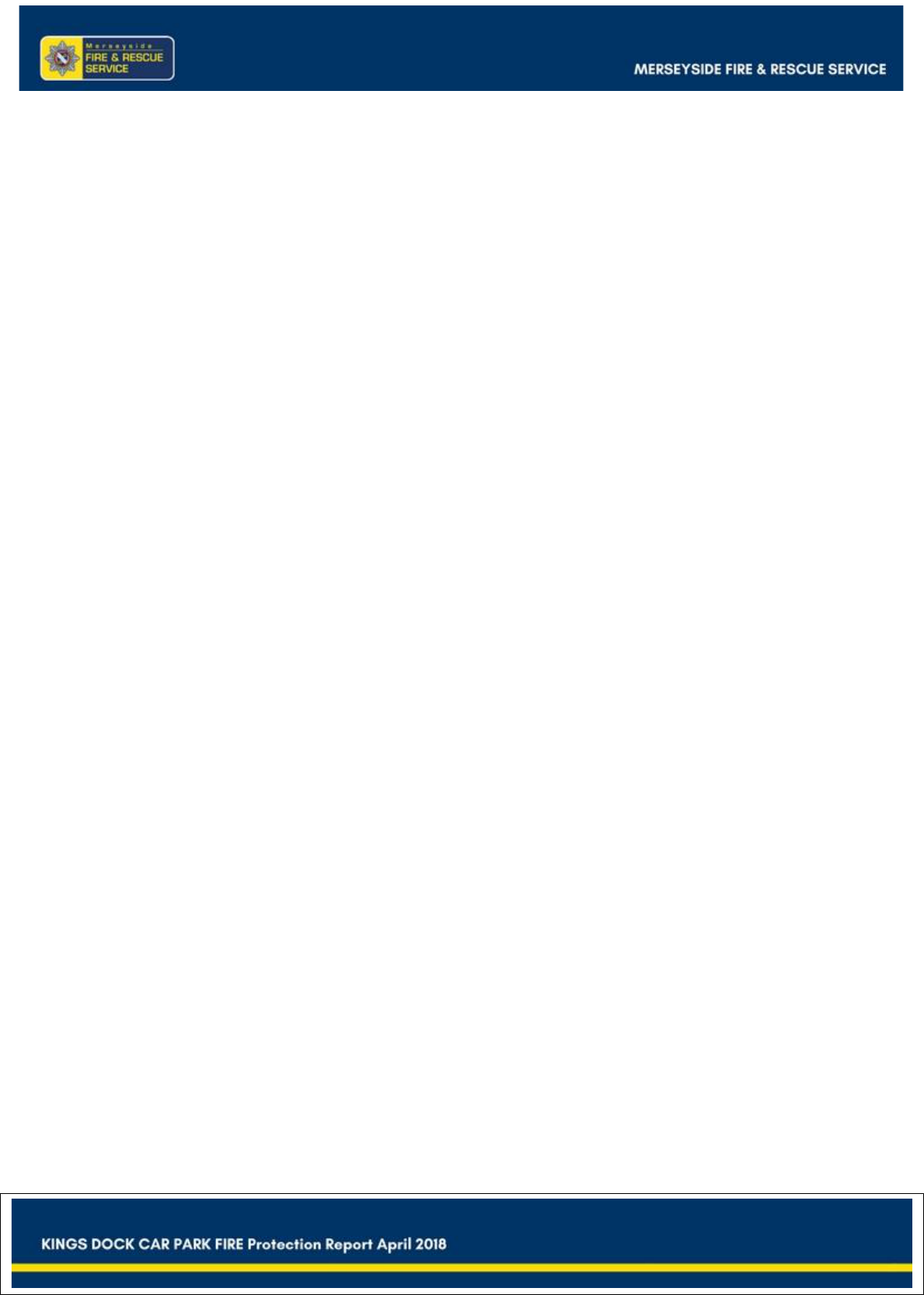
56
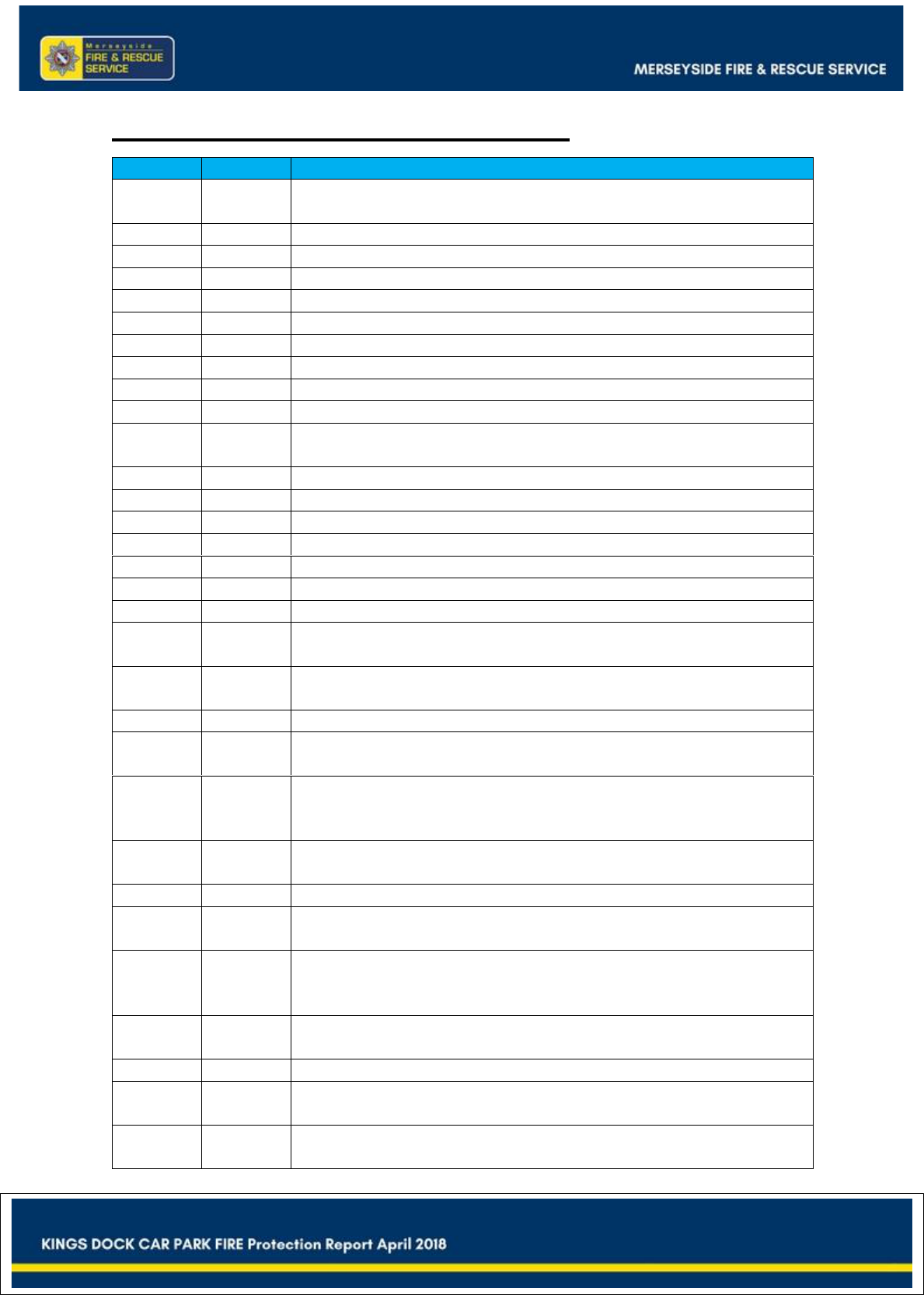
57
Appendix 1 – Detailed Timeline
Time
Date
Details
16:29
31.12.17
Internal car park CCTV - first signs of fire (smoke) from the
vehicle
16:33
31.12.17
Internal CCTV - steady stream of smoke from vehicle
16:37
31.12.17
Internal CCTV – initial signs of flame from vehicle
16:37
31.12.17
External CCTV – first signs of smoke in Plaza area
16:40
31.12.17
External CCTV – pans to 3
rd
floor and shows developing fire
16:42
31.12.17
First call to the Fire Service (999 call from member of public)
16:43:
31.12.17
First fire alarm actuation (break glass call point)
16:43
31.12.17
Two appliances mobilised
16:44
31.12.17
First call received from LCC at venue.
16:45
31.12.17
Female seen taking photo that is later shown on social media
16:45
31.12.17
Event firefighting team arrive at main entrance, under blue
lights
16:50
31.12.17
MF&RS 1
st
Appliance attendance at main entrance
16:51
31.12.17
MF&RS 2
nd
Appliance attendance at main entrance
16:51
31.12.17
Second fire alarm actuation (multi-sensor in stairwell 2)
16:56
31.12.17
Assistance message – “Make pumps 3”
16:56
31.12.17
External firefighting begins
16:57
31.12.17
Fire alarm Panel re-actuation (break glass and multi-sensor)
17:01
31.12.17
Assistance message “Make pumps 6”
17:08
31.12.17
First BA team (Alpha 1) committed from stairwell 2 into level 3
(Sector 2)
17:09
31.12.17
Second BA Team (Alpha 2) committed from stairwell 2 into
level 3
17:31
31.12.17
Assistance message – “Make pumps 8”
17:31
31.12.17
BA crews report multiple vehicles involved and re-ignition of
extinguished vehicles
17:35
31.12.17
Third BA crew (Alpha 3) committed from stairwell 2 into level
3. BA crews report running fuel fires, explosions and
“waterfall” of fire coming from level above
17:40
31.12.17
BA crews report up to 30 vehicles involved and running fuel
fire between rows of cars
17:41
31.12.17
Assistance message – “Make pumps 12”
17:52
31.12.17
Internal CCTV – first signs of flame from level 4, in location
away from ramps and above initial fire on level 3
18:07
31.12.17
First BA team (Bravo 1) committed from stairwell 1 to level 3
(Sector 3). Report clear view of fire due to wind conditions.
Fire confined to two rows of vehicles, away from ramps
18:20 -
18:25
31.12.17
All BA crews withdrawn from sector 2 due to untenable fire
conditions
18:22
31.12.17
Incident Investigation Team (IIT) in attendance
18:28
31.12.17
Second BA team (Bravo 2) committed from stairwell 1 into
level 4. Report a well-developed and rapidly escalating fire.
18:38
31.12.17
Emergency evacuation of all teams due to major fire event on
level 4 and concerns over firefighter safety
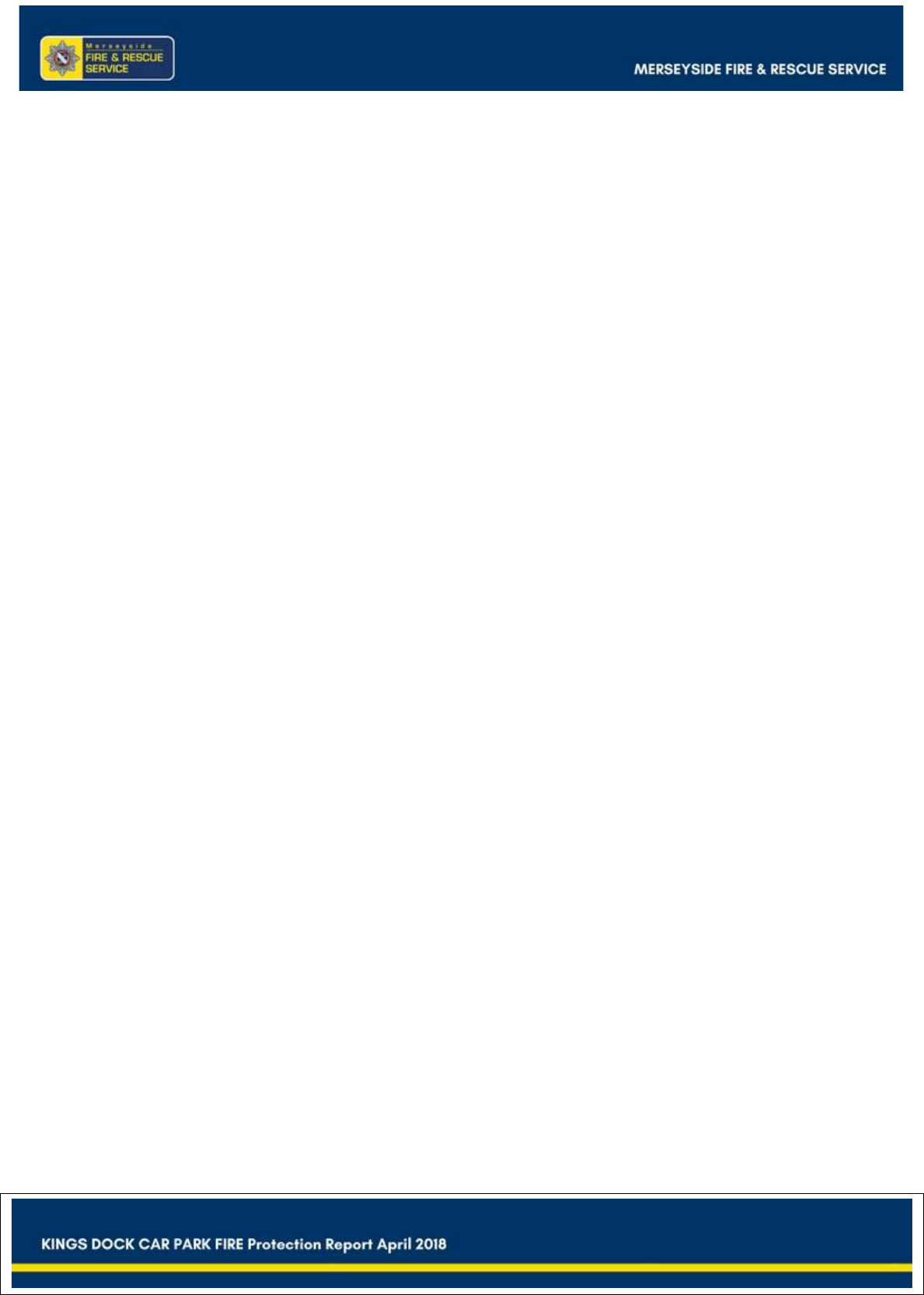
58
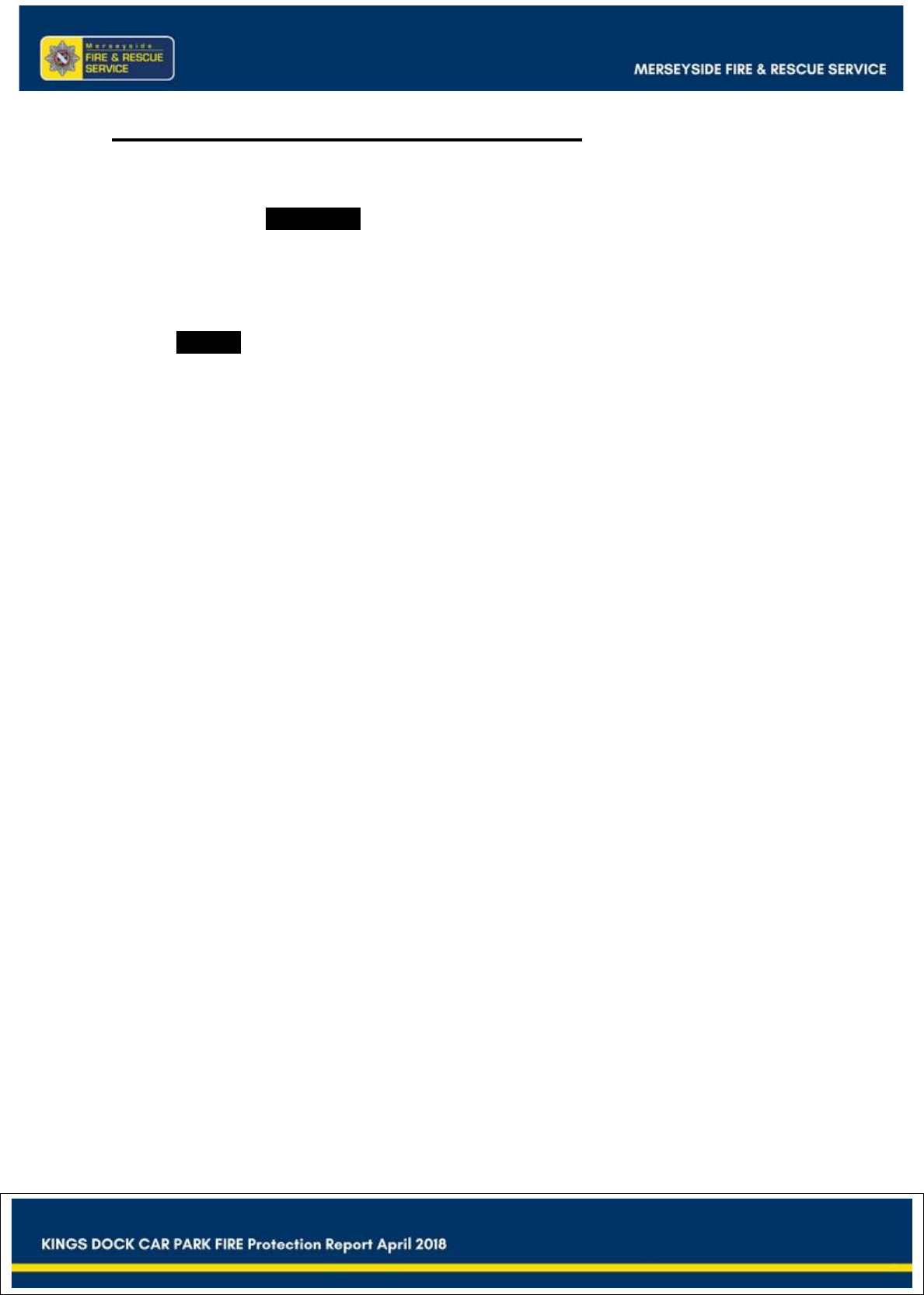
59
Appendix 2 - Alterations Notice
1. Name: Mr P Pickett
Premises: Liverpool Arena & Convention Centre
Address: Monarchs Quay, Liverpool, L3 4FP
2. I E W Avis, Fire Safety Manager, Liverpool, on behalf of Merseyside Fire and Rescue
Authority, hereby give you notice that the Fire and Rescue Authority are of the
opinion that, under Article 29(1)(b) of the above Order, any change made to the
premises, or the use to which they are put, may constitute a serious risk to relevant
persons (See notes) due to the reliance on fire engineering features designed into the
building and the high degree of management required to ensure the maintenance of
a fire safe premises.
3. The Fire and Rescue Authority hereby direct that if you, as a responsible person, (See
notes) intend making any of the following –
(a) a change to the premises, including the fire safety strategy;
(b) a change to the services, fittings or equipment in or on the premises;
(c) an increase in the quantities of dangerous substances which are in or on the
premises, or
(d) a change to the use of the premises;
you, as the responsible person, must notify the Fire and Rescue Authority of the
proposed changes.
The Fire and Rescue Authority also direct that in addition to the notification referred
to above, that as a responsible person you must -
(a) take all reasonable steps to notify the terms of this notice to any other person, or
persons, who have to any extent control of the premises, insofar as the
requirements in articles 8 to 22 of the Regulatory Reform (Fire Safety) Order
2005, or in regulations made under Article 24, relates to matters under his, or
their, control;
(b) carry out or review the risk assessment and record the significant findings,
including the measures which have been taken or will be taken and identify any
group of persons identified by the risk assessment as being especially at risk;
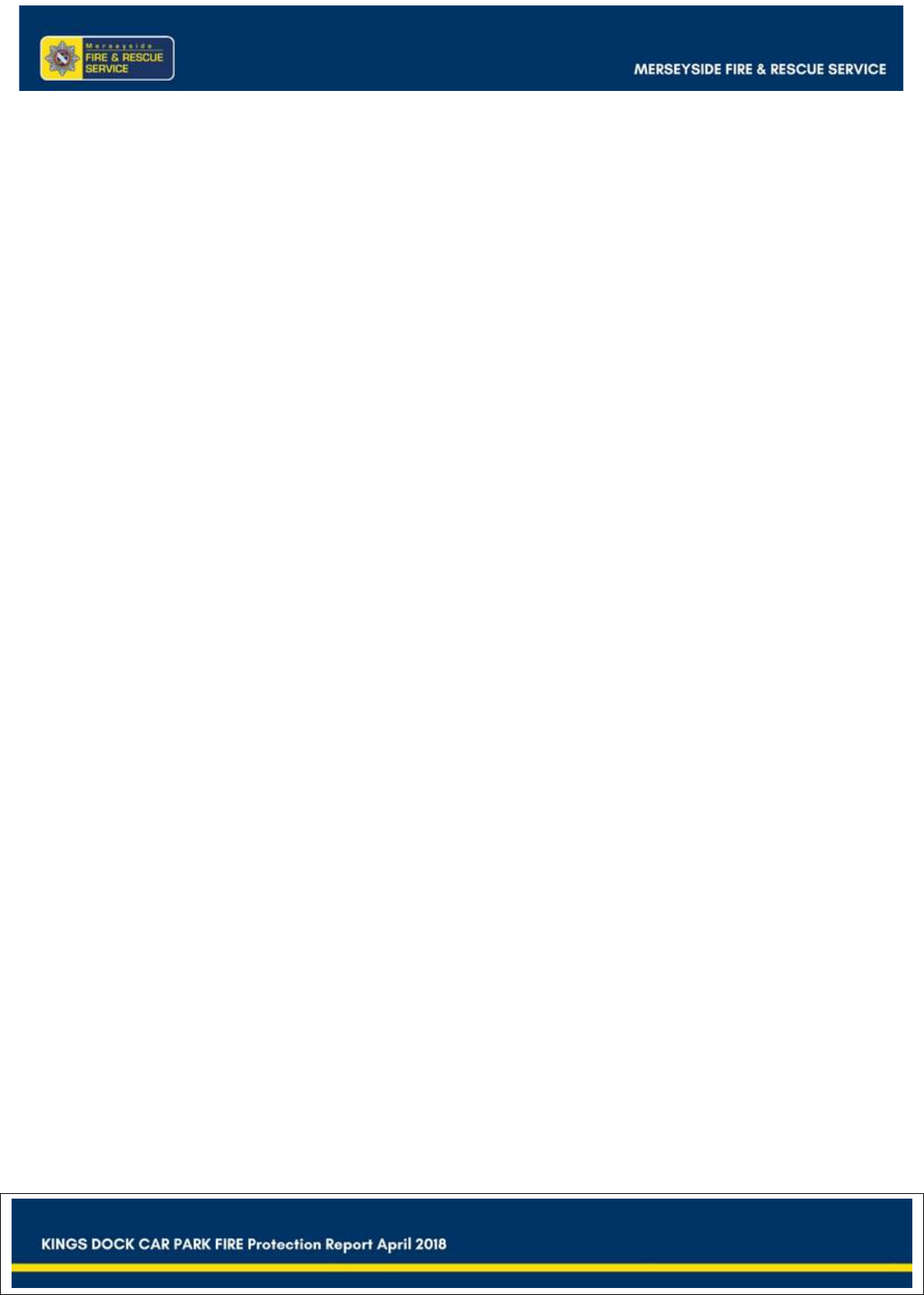
60
(c) record the arrangements as are appropriate, having regard to the size of his
undertaking and the nature of its activities, for the effective planning,
organisation, control, monitoring and review of the preventative and protective
measures, and
(d) before making any changes referred to in the above paragraph, send to the Fire
and Rescue Authority a copy of the risk assessment and summary of the changes
proposed to be made to the existing general fire precautions.
